
How to Travel with Baby Formula
Feeding our babies is the most important thing we do as parents. And the amount of pressure we put on ourselves over what to feed them and how to feed them carries over into travel. Travel with baby formula definitely requires planning in advance. The length of your journey and your destination will determine exactly how much you need to bring and how you need to bring it.
Packing Formula
You’ll need to pack formula for your travel day, and for the duration of your vacation if you aren’t certain your brand will be available where you’re going. Depending on the age of your baby and their tolerance for change, switching brands or formulations while on vacation is not recommended. Baby items are difficult to come by in airports and on the road. Always, always pack more feeds than you think you will need in your carry-on . And even if your brand is available at your destination, not having to rush out to a store when you arrive is worth packing extra.
FAA regulations allow for more than the allowed liquid requirements when traveling with a baby under two. Within reason . They aren’t going to allow you to go through security with a gallon of distilled water. However, it is safe to prepare powdered formula with bottled water. It must be below 200 mg/litre of sodium and no more than 250mg/litre of sulphate. Most brands fall well within these amounts.
Powdered Formula vs. Ready-to-Drink
If you are already feeding ready-to-drink formula, and you don’t think it will be available at your destination, it’s safe to say your luggage will be very heavy. Consider switching before your trip if possible. For ease of identification, travel with a can of the formula powder. The travel formula containers make life very easy in terms of portioning and mixing while en route. Although having the can handy for identification makes life easier while going through security.
Mixing Formula
Probably my biggest and best tip for travel with baby formula is to get baby accustomed to drinking room temperature bottles. Mixing formula while traveling is not such a big deal, however heating it up might be. Juggling cups of boiling water is no picnic if you’re also managing a hungry baby. Certainly there are portable baby bottle warmers designed for travel. If you have the money and the carry-on space for an extra gadget, and baby can’t tolerate a non-warmed bottle, then it’s worth the investment.
Traveling with Bottles
Bottles take up a lot of space. Although the powdered formula doesn’t take up a lot of room, the pre-sterilized bottles do. If your travel day is 12 hours, and baby feeds every four hours, that’s three bottles (plus at least two extra in case of delays). So there’s five empty bottles (plus nipples, plus caps) you need to pack and keep clean.
The pre-sterilized bottle liners definitely save space and make life easier for travel.
Washing and Sterilizing Bottles
Is it really a vacation if you’re still washing and sterilizing bottles? Of course! It’s not necessary to travel with a bottle sterilizer if you have access to (or pack) a travel kettle. However, if your accommodation has a kitchen or at least a microwave, the steam sterilizers are fairly compact and the sterilizer bags even more so.
Making bottle maintenance a part of your routine while on vacation is just part of travel with baby formula and once it’s done you can enjoy your evening together.
Have Baby Will Travel is a participant in the Amazon Services LLC Associates/Influencer Program . If you make a purchase through this site, we may receive a small commission. Click here to check out our Amazon Store .
- Tips for Feeding Baby on Holiday
- How to Sterilize Bottles in a Hotel Room Sink
- Bottle Feeding Travel Tips
- How to Travel with a Breastfeeding Baby
- Infant Travel: Planning Your First Trip with Baby
- Everything You Need to Know About Traveling with a Newborn
Photo by Jaye Haych on Unsplash
bottle feeding , feeding baby , formula
No comments yet.
Leave a reply click here to cancel reply..
Name (required)
Email (will not be published) (required)
This site uses Akismet to reduce spam. Learn how your comment data is processed .
Travel Partners
Additional Sponsors
Site Map • Privacy Policy • About • Consulting
Have Baby Will Travel® is a registered Trade Mark ©2007-2024 All Rights Reserved
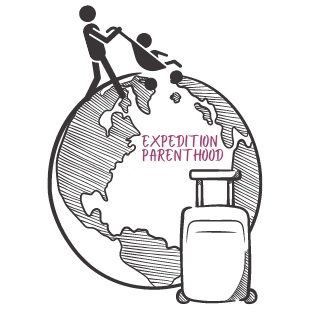
Flying with Baby Formula: My Best Tips After 100+ Flights
Many claim that baby formula adds a new level of stress to travel, as you cannot just whip out a boob and feed your baby whenever. Don’t stress or worry, as many new moms like to exaggerate. Flying with baby formula isn’t that complicated.
My babies were formula fed and I traveled with them every other week. I often flew alone and took numerous international flights between 8-16 hours long when both infants were formula fed .
If you prepare and know the rules, it’s pretty easy to travel with baby formula. Let’s answer all your questions about traveling with baby formula, and introduce you to useful gadgets, and tips on formula feeding abroad as well.
How to Travel with Baby Formula
Let’s dive into the most important question: Should you bring the formula with you on your trip? No matter what, your baby will need to eat during your flight, so you need to have at least some formula with you in a diaper bag.
You can opt for buying formula abroad (I’ll discuss this further down), but you need to assume that your flight might be delayed, you might not find a spot to buy it instantly, and so on.
Very few international airports have fully stocked pharmacies where you can purchase baby formula and even if they do, they don’t operate 24/7 either. Always have a formula for at least 24 hours ahead.
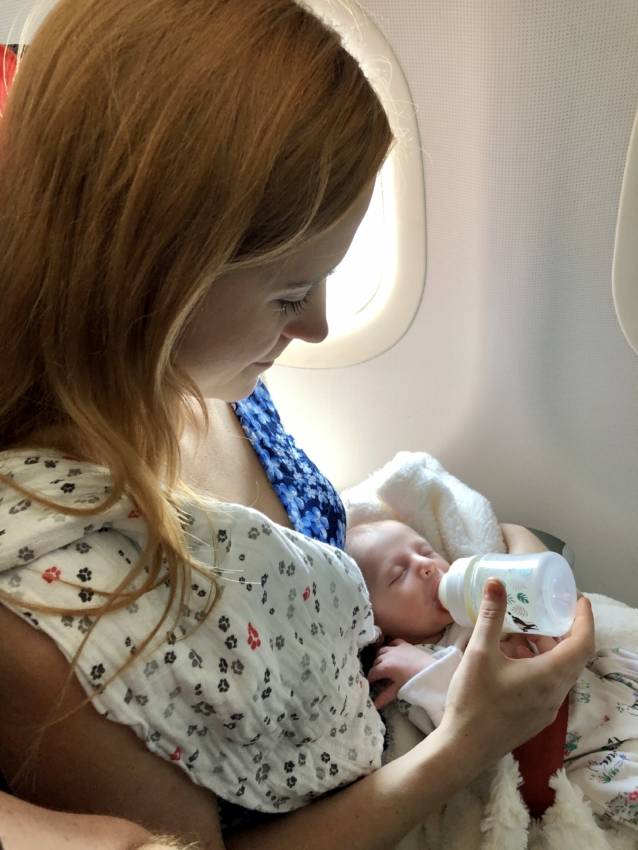
How Much Powdered Formula Can You Bring on a Plane?
There are no limits to how much formula you can bring on a plane, as long as it’s a “reasonable amount”. Even a full can of formula is considered reasonable, so don’t worry.
You can also bring formula cans in checked luggage. When my kids were babies we actually brought a suitcase full of formula back from Mexico as we prefer European formula that’s not available in the US.
Can you bring formula if you’re traveling without a baby? Yes, you can as long as it’s in a powdered and not liquid.
Just remember: if you’re bringing formula in your carry-on : powder substances greater than 12 oz. / 350 mL ( along with water for baby ) must be placed in a separate bin for X-ray screening . TSA will open your liquids to test them, but they don’t contaminate them.
Does TSA allow water for baby formula or liquid formula?
In the US you can bring your water for formula, or liquid formula or milk through airport security. You can also bring water or juice for a toddler, it doesn’t need to be strictly for formula.
Be sure to let the officer know before you go through security that you have liquids in excess of 100ml/3oz for your baby, as they need to go into a separate special bin and be extra screened. Usually, the agents unscrew the top for a vapor test, as they are not allowed to stick anything into the liquid.
If you’re in a rush I recommend not bringing a pre-mixed formula through TSA and just buy a bottle of water for formula once you’ve passed security. You can ask any Starbucks or restaurant to fill your thermos with hot water .
The amount of liquid you can bring that’s considered reasonable is left up to the TSA officer. I’ve seen plenty of people being questioned about their milk, so save this page on your phone in case you need to show the officers that you’re within your rights. That’s in the US though.
Outside of the USA rules seem to vary, but the general rule of thumb is when flying with baby formula you can bring enough liquids for a baby under 12 months of age .
Over 12 months it sadly depends on the mood of the officer, but I can assure you that if you’re flying from London Heathrow Airport or Stockholm Arlanda Airport your liquids will be thrown away, often with the bottle or sippy cup itself which is terrible, so keep this in mind.
IMPORTANT: When flying with baby formula or breastmilk, TSA recommends that formula and breast milk be transported in clear, translucent bottles and not plastic bags or pouches. You might have heard that officers “destroyed” a lot of breastmilk pouches when the mother was traveling without her baby. This wouldn’t have happened if the milk was packed according to their guidelines.
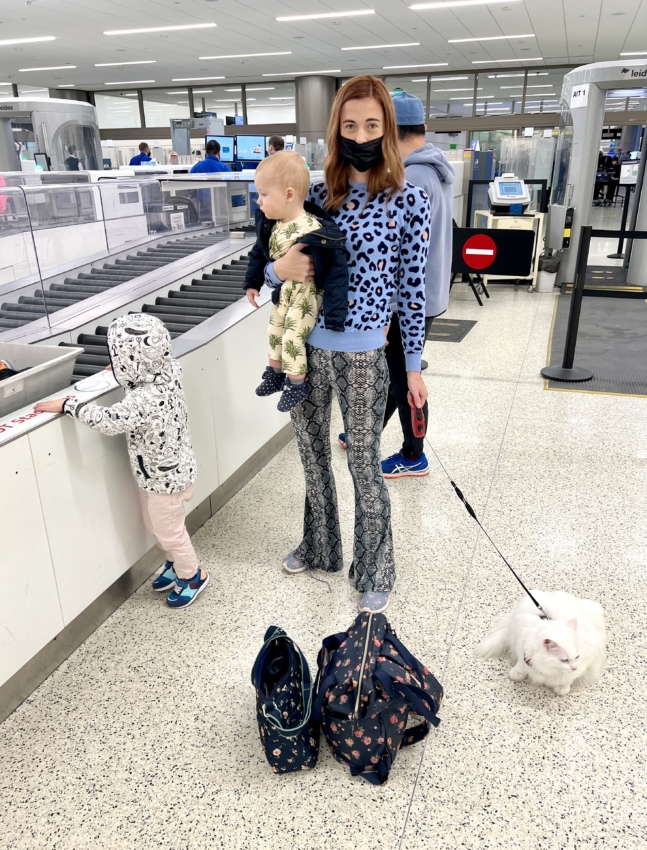
How do you keep formula warm when traveling?
Many will tell you to feed your baby with room-temperature formula. It’s a great tip, as you don’t need to warm anything up.
I’m always very much into making things easy, but let me tell you: this worked just fine with my second child, but never with my first. Unless the formula was warmed up he wouldn’t drink it.
We know that formula shouldn’t be reheated after a few hours, especially not at room temperature, so your best bet is to keep the formula and water separate until you need to feed your baby.
In order to warm your water you can either use a bottle warmer or bring a thermos with hot water. You can get anywhere at the airport (just ask for hot water for the baby) or even on the plane (ask the flight attendant to fill your thermos).
Best Items for Flying with Baby Formula
Powder formula dispensers.
These handy containers are perfect for any on-the-go parent for trips outside, but are extra useful when traveling. You don’t need to think about anything because you can pre-measure it.
Bottle Brush
I made the mistake of not bringing a bottle brush a few times. Bottles will need a good scrub after usage.
M y tip for washing bottles at the airport and in-flight is to use water from the sink to rinse it a few times first. Then, wipe the bottle down with paper towels. Afterward, either ask a flight attendant or nearby Starbucks to give you hot water and rinse your bottle with hot water.
Your bottle won’t be 1000% disinfected and clean, but it’s the practical and realistic way of cleaning the bottles on the go.
Some people bring sterilizing bags, but you only need to sterilize bottles before their first use (and this can be done in an old-fashioned way by cooking them in a big pot) and perhaps periodically after.
If you don’t sterilize your bottles while traveling you will be all right, unless your baby is immunocompromised, premature, and under 2 months old.
Plus, these bags require a microwave, and many hotel rooms never have it unless it’s a suite with a kitchenette.
A bottle warmer is a useful gadget, but not a must. You can simply get an old-fashioned thermos. It’s easy to ask for hot water even on a plane or any cafe at the airport.
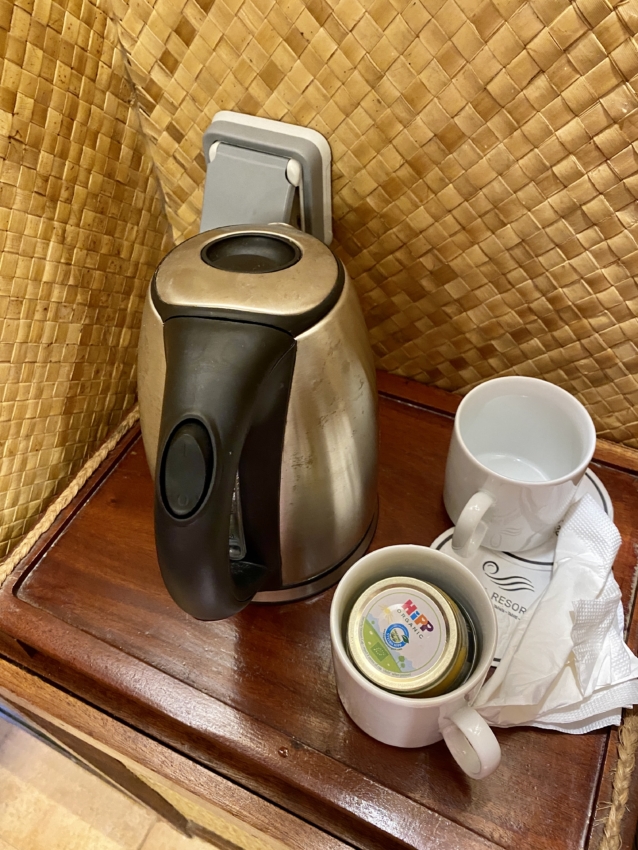
Anna Lisa is the founder of Expedition Parenthood, that combines her passion for travel with parenting. She's the creator of one of the top female travel blogs in the world, annaeverywhere.com, and one of the stroller reviews blogs in the US, annainthehouse.com, with combined readership in the millions each year.
Similar Posts
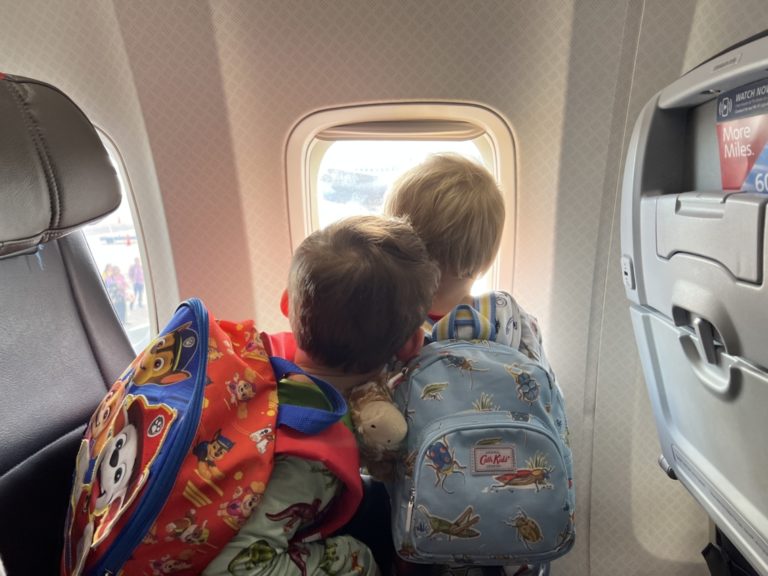
Baby & Toddler Travel Gear for an Effortless Vacation
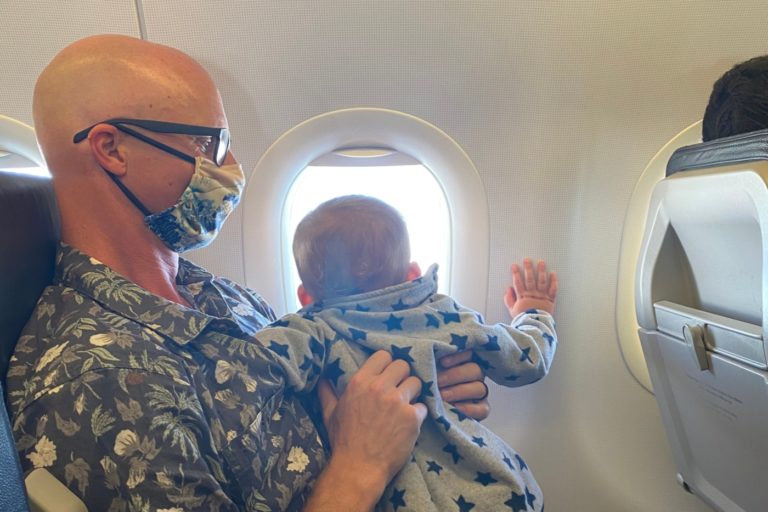
Guide to Flying with a Baby (After 100+ Flights with Infants!)
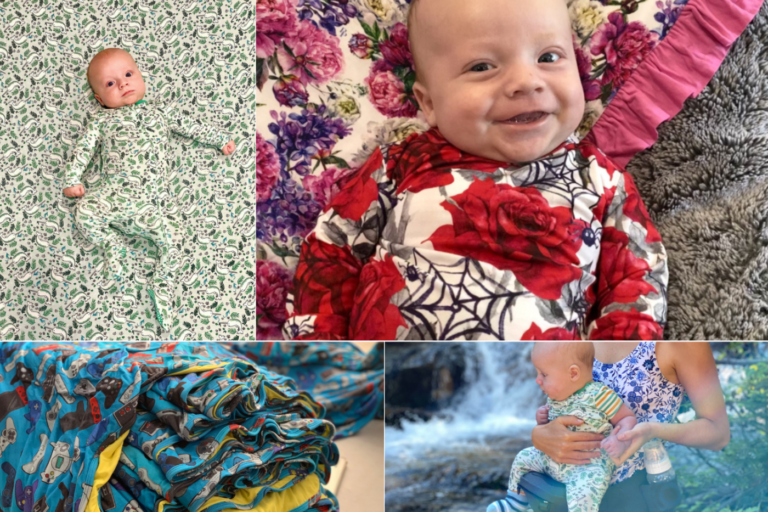
Are Bamboo Baby Clothes Good for Traveling? Our Favorite Brands

Is Slumberpod Worth It For Travels with Baby? NOT Sponsored Review
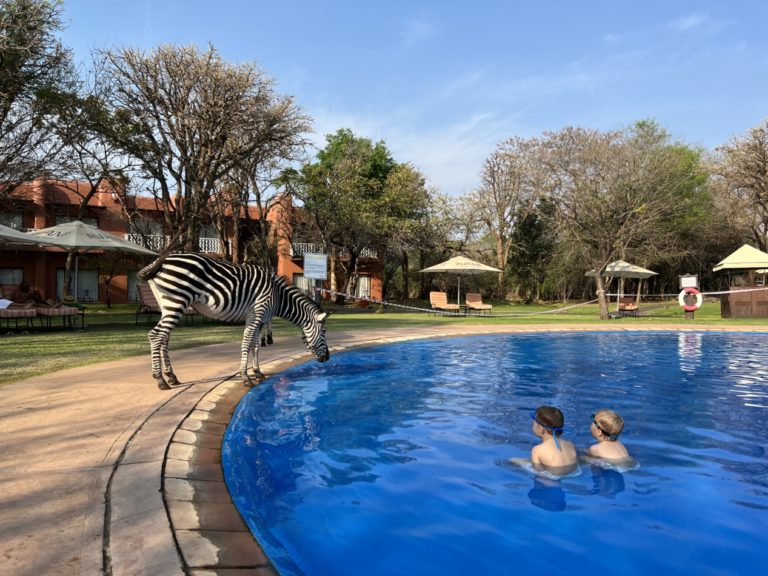
Most Memorable Travel Experiences for Toddlers and Little Kids

Hotel Cribs vs Portable Travel Cribs: What to Consider
Leave a reply cancel reply.
Your email address will not be published. Required fields are marked *
Save my name, email, and website in this browser for the next time I comment.

How to Travel with Formula: Tips and Guidelines
Traveling with a baby can be stressful, especially when it comes to packing and transporting formula. However, with a little preparation and knowledge, it can be a smooth and hassle-free experience.
First, it is important to note that baby formula is allowed in both carry-on and checked bags. However, it is recommended to pack enough formula for the entire trip in case of any delays or unexpected situations. When packing baby formula powder in a carry-on bag, it is important to follow the TSA guidelines and notify the officer right away.
When traveling with formula, it is also important to consider the baby’s feeding schedule. Planning tasks and activities around the baby’s usual feeding times can help avoid any hunger-related meltdowns. It is also a good idea to pack extra bottles, nipples, and cleaning supplies to ensure everything stays sanitary and accessible during the trip.
TSA Guidelines
Preparing formula for travel, storing formula, sterilizing bottles, packing essentials, choosing the right formula for travel, navigating airport security with baby formula, managing feedings on a plane, using formula dispensers for convenience, cleaning bottles after travel, checking formula expiration dates, additional tips for traveling with formula, how much powdered formula can i bring on a plane, can i bring unopened baby formula on a plane, can i bring powdered formula on a plane, can i bring hot water for baby formula on a plane, do airports sell baby formula, what is the best way to travel with baby formula, understanding the basics of traveling with formula.
Traveling with a formula-fed baby can be challenging, but with the right preparation, it can be a stress-free experience. Here are some basics to keep in mind when traveling with formula:
According to TSA guidelines, formula, breast milk, juice, and baby food in quantities greater than 3.4 ounces (100ml) are allowed in carry-on baggage and do not need to fit in a quart-sized bag. You are permitted to bring acceptable amounts of breast milk and baby formula with you on your trip. It is recommended to inform the TSA agent of any formula, baby food items or breast milk in your carry-on baggage during the security screening process.
When packing formula for a flight, it is essential to plan ahead and pack enough for the duration of the trip. It is better to have too much than not enough. A formula dispenser can be a helpful tool for measuring out the correct amount of formula for each feeding. It is important to note that not all formula dispensers are TSA approved, so it is best to check with the airline before packing one in your carry-on.
When traveling with formula, it is crucial to ensure that it is stored properly to prevent spoilage. Powdered formula should be stored in a cool, dry place, while ready-to-feed formula should be kept in a cooler or insulated bag with ice packs. It is also recommended to bring a few extra bottles and nipples in case of spills or unexpected delays.
When traveling with formula, it is important to ensure that bottles are properly sterilized to prevent the spread of germs. One option is to bring sterilized bottles from home, but disposable sterilizing bags can also be a convenient and space-saving option. It is also recommended to bring a sterilizing tablet and ask the crew for water on the flight.
By keeping these basics in mind, traveling with formula can be a smooth and stress-free experience for both parents and babies.
Preparation Before Travel

Traveling with a bottle-fed baby requires some preparation to ensure that feeding goes smoothly, especially when traveling by air. Here are some tips to help parents prepare for a trip with baby formula.
When packing for a trip with baby formula, parents should consider the following essentials:
- Formula: Bring enough formula to last the entire trip, plus a little extra in case of delays.
- Bottles: Pack enough bottles for each feeding, plus a few extra in case of spills or leaks.
- Water: Bring clean water for mixing formula, or plan to buy bottled water after passing through security.
- Bottle brush: Pack a bottle brush for cleaning bottles on the go.
- Burp cloths: Bring a few burp cloths to clean up after feeding.
- Insulated bag: Use an insulated bag to keep formula and bottles cool.
When choosing a formula for travel, parents should consider the following factors:
- Powdered formula: Powdered formula is the easiest to travel with because it is lightweight and does not require refrigeration.
- Ready-to-feed formula: Ready-to-feed formula is convenient but heavy and expensive.
- Formula dispensers: Formula dispensers are useful for pre-measuring powdered formula for each feeding.
- Cooling accessories: Cooling accessories, such as freezer packs or gel packs, can keep formula cool while traveling.
Parents should also check with their airline’s policies regarding traveling with baby formula. Most airlines allow a reasonable quantity of baby formula to be brought in carry-on or checked baggage. Formula should be packed in a quart-sized bag and declared at security checkpoints.
By preparing ahead of time and packing the right essentials, parents can ensure that their baby is well-fed during travel.

Traveling with a baby can be stressful, especially when it comes to navigating airport security. However, with a little preparation and knowledge, it can be a smooth and stress-free process.
Formula, breast milk, juice, and baby food in quantities more than 3.4 ounces are permitted in carry-on baggage by the Transportation Security Administration (TSA). These items should be removed from the carry-on bag and screened separately from other belongings. At the start of the screening process, parents or guardians should notify the TSA officer that they are carrying formula or other medically essential liquids in excess of 3.4 ounces.
To help speed up the process of going through airport security when traveling with baby formula, here are some tips:
- Pack formula in see-through bags to make it easier for security officers to inspect.
- Remove all liquids from the nappy bag before screening.
- Be aware of prohibited items such as gel packs or ice packs that are not frozen solid. Frozen gel packs or ice packs are allowed in carry-on bags.
- If traveling with a breast pump, it is allowed in carry-on bags and does not count as a carry-on item.
It is important to note that TSA officers may need to test liquids for explosives or other prohibited substances. If a TSA officer needs to test a liquid, they will ask the passenger to open the container and transfer a small amount of the liquid to a separate screening container.
In summary, traveling with baby formula through airport security can be a smooth process with a little preparation and knowledge of TSA guidelines. Informing the TSA officer at the beginning of the screening process and packing formula in see-through bags can help speed up the process.
Feeding Your Baby During Travel
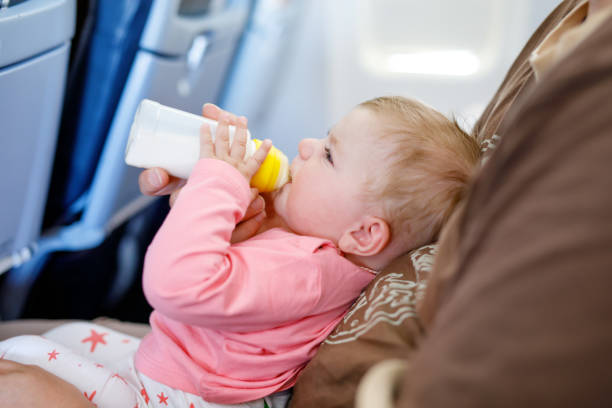
Traveling with a baby can be challenging, especially when it comes to feeding. However, with proper planning and preparation, feeding your little one during travel can be made easier. Here are some tips to help you manage feedings on a plane and use formula dispensers for convenience.
If you’re flying with a formula-fed baby, you can bring your formula with you. Formula, breast milk, juice, and baby food in quantities more than 3.4 ounces are permitted in carry-on baggage. It is, nevertheless, recommended that you bring additional formula in case of spills or delays.
To warm up bottles, you can ask the flight attendant for hot water or use a portable bottle warmer. It is also helpful to bring wet wipes for cleaning up spills and messes.
If you are breastfeeding, it is recommended to nurse during takeoff and landing to help your baby’s ears adjust to the pressure changes. You can also bring a liquid-filled teether or toddler drinks to help your little one swallow and relieve ear pressure.
Formula dispensers are a convenient way to pack pre-measured formula for travel. They come in various sizes and shapes and can fit easily in a diaper bag or carry-on luggage.
To use a formula dispenser, simply fill each compartment with the appropriate amount of formula needed for each feeding. When it’s time to feed your baby, pour the formula into a bottle of pre-measured water and shake well.
It is important to note that tap water quality can vary from place to place, so it is recommended to use bottled water or boiled tap water when making formula. Frozen gel packs can also be used to keep pre-made bottles cold during travel.
By following these tips and using formula dispensers for convenience, feeding your baby during travel can be made easier and less stressful.
Post-Travel Care and Maintenance
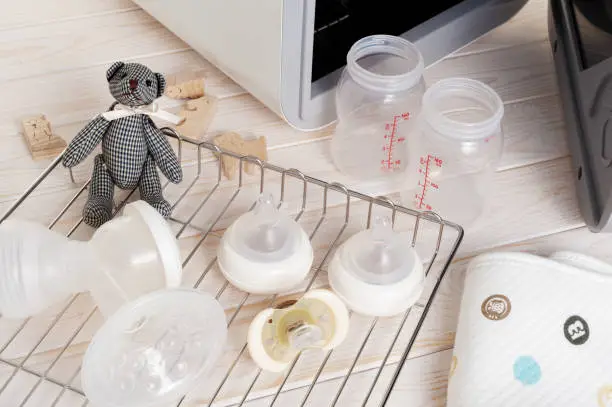
After a trip, it’s essential to take care of the formula and feeding equipment to ensure the baby’s safety and health. Here are some tips for post-travel care and maintenance:
It’s crucial to clean the bottles thoroughly after every use to prevent bacteria growth. Use a bottle brush and mild soap to clean the bottles and nipples. Rinse them with hot water to remove any soap residue.
If you don’t have access to hot water, you can use bottled water or a water bottle with a built-in filter. Be sure to clean the water bottle before using it to rinse the bottles.
After cleaning, sterilize the bottles and nipples by boiling them in water for at least five minutes. You can also use a sterilizer or microwave sterilizer bags for convenience.
Always check the expiration date of the formula before using it. Expired formula can cause digestive problems and make the baby sick.
Check the expiration date on the formula container before packing it for travel. If the formula expires during the trip, dispose of it and buy a new one.
It’s also essential to check the expiration date of any backup formula you bring along. Don’t forget to check the expiration date of the water you use to mix the formula.
In conclusion, taking care of the formula and feeding equipment after travel is crucial for the baby’s health and safety. Clean the bottles thoroughly and check the expiration date of the formula before using it. By following these simple steps, parents can ensure that their baby is getting the best care possible.

When traveling with a formula-fed baby or toddler, there are a few additional tips that can make the experience smoother and less stressful. Here are some practical tips for parents:
- Pack enough formula: It’s always better to pack more formula than you think you’ll need. This is especially important if you’re traveling to a remote location where it may be difficult to find your preferred brand of formula. A good rule of thumb is to pack at least one extra day’s worth of formula, just in case of delays or unexpected situations.
- Use translucent bottles: When going through airport security, it’s important to use translucent bottles for your formula. This will make it easier for security personnel to screen your formula without having to open the bottles. If you’re using opaque bottles, consider transferring your formula to translucent bottles before your trip.
- Consider affiliate links: If you’re looking to purchase formula before your trip, consider using affiliate links to save money and time. Many online retailers offer discounts and free shipping for formula purchases, and using affiliate links can help you earn cashback or other rewards.
- Pack formula in carry-on baggage: When flying with a formula-fed baby, it’s a good idea to pack your formula in your carry-on baggage. This will ensure that you have easy access to your formula during the flight, and will also prevent any potential issues with lost or delayed checked baggage.
- Be prepared for spills: Accidents happen, especially when traveling with young children. Be sure to pack extra bibs, burp cloths, and wipes to clean up any spills or messes that may occur during your trip.
- Know the TSA rules: Make sure you are aware with the TSA rules regarding formula and other liquids before your travel. Formula, breast milk, juice, and baby meals weighing more than 3.4 ounces are permitted in carry-on luggage and do not need to fit in a quart-sized bag. You may be forced to submit them for additional screening, though.
By following these additional tips, parents can ensure a smoother and stress-free travel experience with their formula-fed baby or toddler.
Traveling with baby formula can be a daunting task for new parents. However, with the right preparation and knowledge, it can be a smooth and stress-free experience. Here are some key takeaways to keep in mind when traveling with baby formula:
- Plan ahead: Consider your baby’s feeding schedule and pack enough formula for the duration of your trip. It’s always better to have more than you need than to run out.
- Pack smart: Use a formula dispenser to keep pre-measured formula organized and easy to access. Bring empty bottles to mix and serve the formula in. Consider packing a few extra items such as a bottle brush and sterilizing tablets for added convenience.
- Be aware of regulations: Check with your airline or transportation provider to ensure you are following their guidelines for carrying liquids and baby formula. Remember that TSA regulations allow for empty bottles to pass through security.
- Practice good hygiene: Always wash your hands thoroughly before preparing formula and use clean, sterilized bottles. Consider packing a portable bottle sterilizer or sterilizing tablets for added peace of mind.
- Be flexible: Traveling with a baby can be unpredictable, so be prepared to adjust your plans as needed. Don’t be afraid to ask for help or take breaks when necessary.
By following these tips, parents can feel confident and prepared when traveling with baby formula. With a little bit of planning and preparation, it’s possible to enjoy a stress-free trip with your little one.
Frequently Asked Questions
According to TSA guidelines, you are allowed to bring a “reasonable amount” of powdered formula on a plane. However, it is recommended that you bring only enough for your trip and pack it in your checked luggage to avoid any issues during security screening.
Yes, you can bring unopened baby formula on a plane in your carry-on or checked luggage. However, it is recommended that you pack it in your checked luggage to avoid any potential issues during security screening.
Yes, you can bring powdered formula on a plane in your carry-on or checked luggage. However, it is recommended that you pack it in your checked luggage to avoid any potential issues during security screening.
You are allowed to bring hot water for baby formula on a plane, but it must be in a thermos or other insulated container and be presented for inspection at the security checkpoint. It is also recommended that you bring extra water in case of delays or other unforeseen circumstances.
Many airports do sell baby formula, but it is not guaranteed. It is recommended that you bring enough formula for your trip to avoid any potential issues.
The best way to travel with baby formula is to pack it in your checked luggage to avoid any potential issues during security screening. It is also recommended that you bring extra formula and water in case of delays or other unforeseen circumstances.
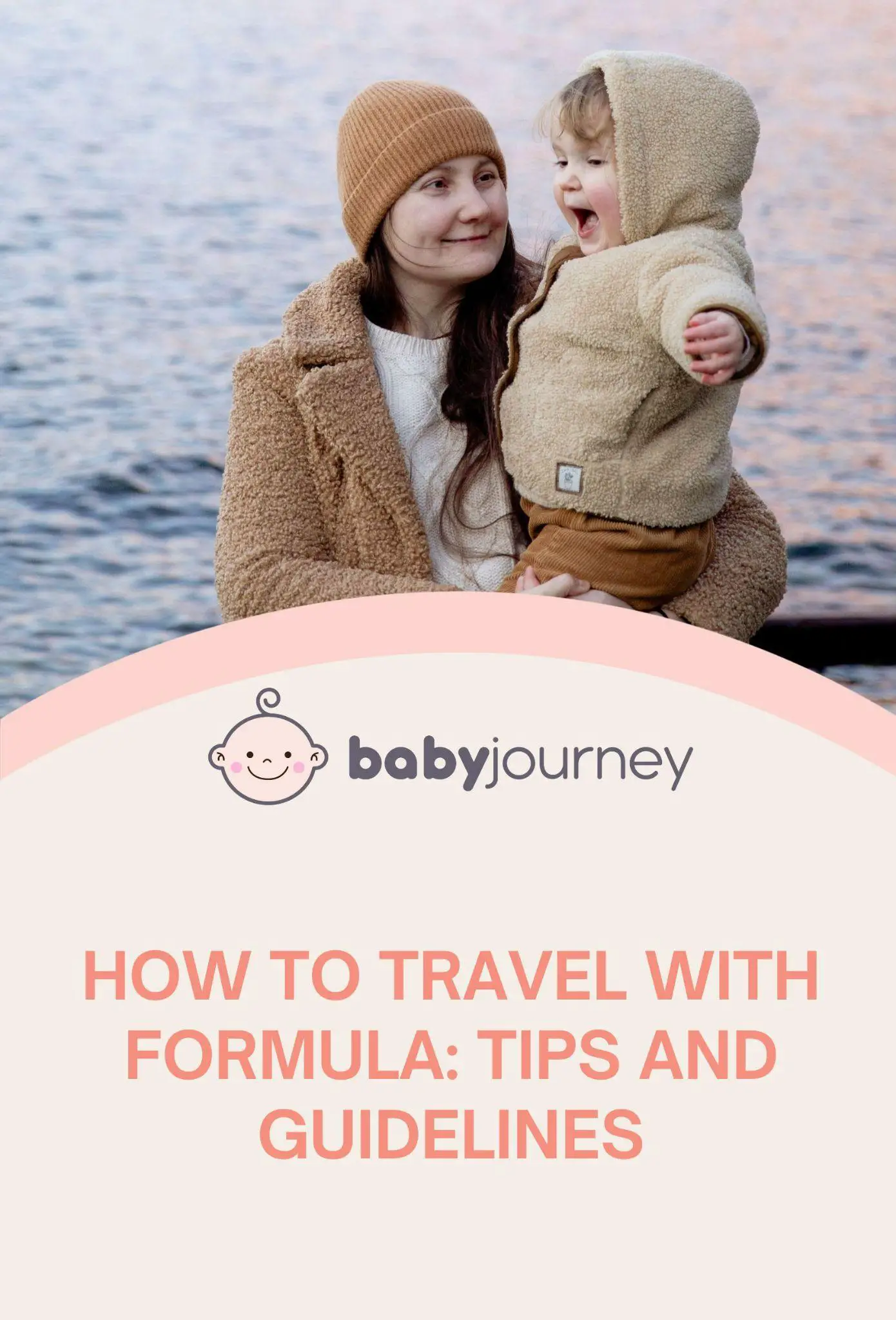
About The Author
Related Posts
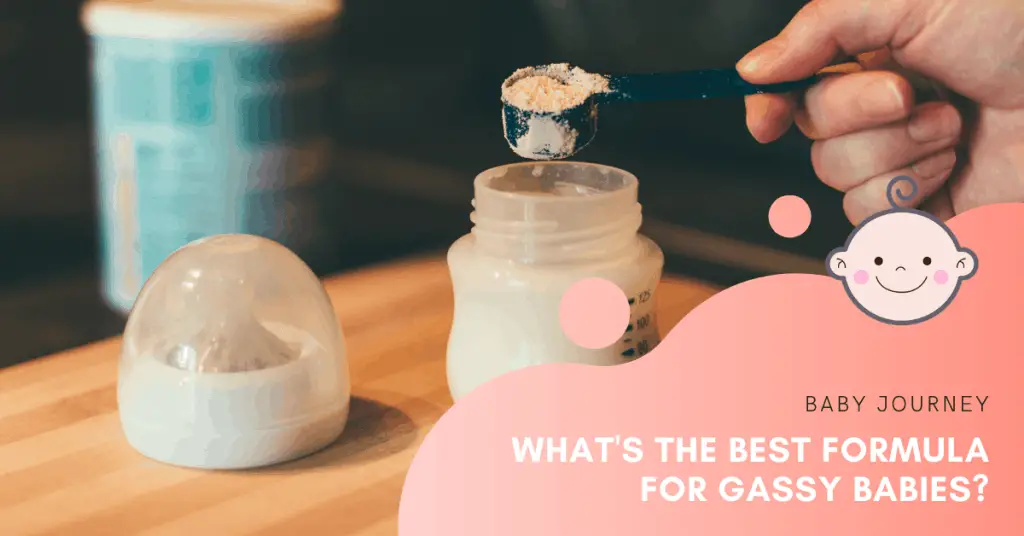
What’s the Best Formula for Gassy Babies? A 2024 Guide
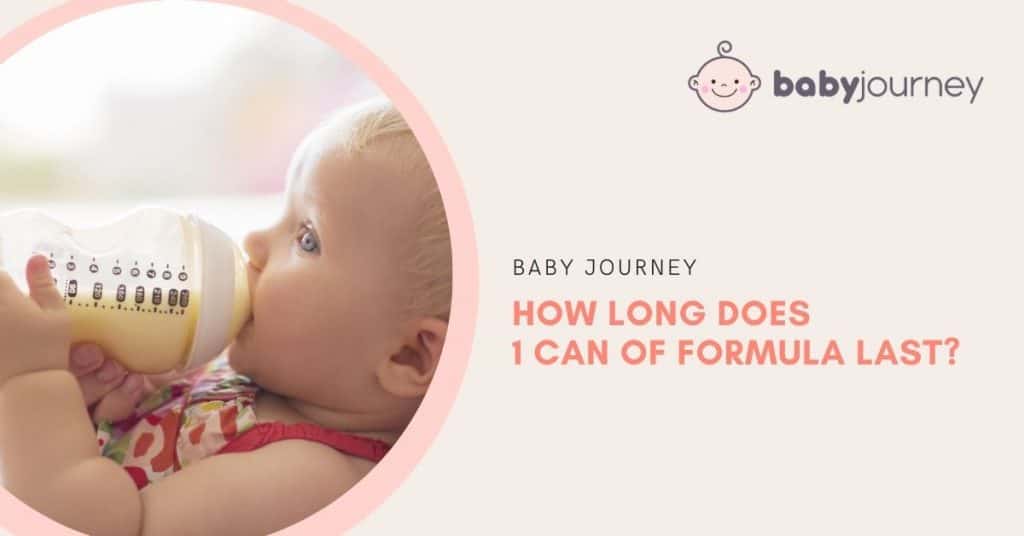
How Long Does 1 Can Of Formula Last?
Leave a comment cancel reply.
Your email address will not be published. Required fields are marked *
Save my name, email, and website in this browser for the next time I comment.
Save 15% with code: BREW15OFF and Free shipping on US orders $85+

How to Travel with Baby Formula (By Plane or In the Car)
Posted by Jane Springston on May 12, 2021
Going on vacation with your baby is both exciting and daunting. At this point you’ve likely reached a comfort level caring for your little one and have even mastered outings during the day. Now you’re ready to take on traveling with your baby, but you know there is a lot to consider. And that includes managing all those feedings and what the heck is the best way to travel with baby formula?!
It can seem challenging when you’ve never done it before, but with the right knowledge and a few expert tips, traveling with your little one and her formula doesn’t have to be hard.
Planning Ahead for Feeding Your Formula-Fed Baby While You Travel
Whether you are heading to your destination by airplane or car, planning ahead is going to make all the difference in making your vacation with your baby a positive experience. We cover many our top suggestions in our article, “ Tips for Traveling With Your Baby .”
You’ll want to take extra time to plan out what you need for your baby’s formula feedings. You can utilize the following checklist to ensure you have everything you need:
- Formula - If you’re traveling domestically, chances are that there will be a store nearby that sells the type of formula you give to your baby. But be sure to do your research ahead of time to ensure this is the case. We recommend bringing more than enough formula along with you anyway, so that you don’t have to be rushing out on your vacation trying to buy more.
- Bottles - Once you get to your hotel or destination, you’ll be able to sanitize your baby’s bottles. But until then, you’ll want to have enough to get you through your trip. For example, if you’ll be on a plane, you don’t want to have to worry about cleaning any bottles mid-flight so make sure you bring enough to get you through.
- Portable Bottle Warmer - A travel bottle warmer is a life-saver when traveling with your baby. It’s going to be difficult to access warm water to make your baby’s formula bottle, so a bottle warmer will do the trick. The Baby’s Brew portable bottle warmer is perfect because it easily fits in a diaper bag and will warm your baby’s formula in advance so it’s ready when they are.
- Formula Dispenser - These take the mess out of bottle making while making portioning out your baby’s bottle super simple. We list our favorites in this article !
- Water - You can’t make a formula bottle without it (unless of course you use ready-to-feed formula). In terms of what water to use for your baby’s bottles, tap water is generally regarded as safe to use, but if you can bring your own sterilized water from home that’s even better.
Along with what you’ll need to make the bottle, you’ll also want to have what you need to keep your little one clean. Burp cloths and baby wipes are something you’ll want to have on hand. Our checklist works great for both plane and car travel, but these trips will bring different challenges so let’s get into the specifics.
Traveling with Baby Formula By Plane

Because there are so many rules about what you can and can’t take with you on a plane, of course you’re going to be a bit concerned about how you’re going to manage your baby’s formula feedings on the airplane.
Many parents wonder, “ Can you travel with baby formula on a plane?”
Luckily, the Transportation Security Administration (TSA) is much less strict about bringing liquids onto a plane that are for babies and young children.
The rules in regard to formula, breast milk and juice, according to their website, is as follows:
“ Formula, breast milk and juice for infants or toddlers are permitted in reasonable quantities through the security checkpoint. Remove these items from your carry-on bag to be screened separately from the rest of your belongings.”
The part about “reasonable quantities” can be a bit confusing, but they likely won’t question the amount you have especially if your little one is with you. Just be sure to notify the TSA officer right away that you have formula in your bag that exceeds the typical maximum of 3.4 ounces.
You can also skip putting it through the x-ray machine or tell them you don’t want them to open it, but they will need to use a different method of screening.
Going through security is often stressful enough even without a baby and all of their formula, so it’s important to be relaxed about the process and give yourself plenty of extra time to get through this portion of the travel process. Remember that you aren’t the first parents to pass through security with a little one, so the process should go smoothly.
Top Tips for Easy Plane Traveling with Formula
So you can rest easy knowing you’ll be able to take your baby’s formula on the plane with you (whether that’s already liquid in a bottle or stored in powdered form), but the next step is navigating bringing it along and giving it to your baby in the easiest way possible.
From avoiding messes to timing those feedings just right, here are our top tips for bringing that formula along as you cruise the friendly skies.
- Prepare Bottles Ahead - You will already have plenty to worry about as you’re navigating the airport and boarding the plane, so don’t add bottle-making to the list if you don’t have to. According to Kids Health , formula may be prepared up to 24 hours in advance, as long as it's refrigerated. We suggest taking advantage of this and storing your baby’s bottles in a cooler bag. That way when it’s time to warm one up, you just pull a bottle out of the bag.
- Warm Bottles Ahead - Above we recommended taking along a travel bottle warmer. We suggest using one like the Baby’s Brew where you can begin warming the bottle at the push of a button and that can be warmed well in advance. That way, the minute your baby gets hungry, you’ll have the bottle ready and you can avoid the tears.
- Feed Your Baby During Take-Off - We suggest trying to time your baby’s feed with take-off. Even if it’s not technically “meal time” you may try offering your little one a bottle. This can help with plugged ears and make for a peaceful transition into your flight. (And of course cross your fingers that it will soon send them off to dreamland for a good portion of the flight.)
Traveling with Baby Formula By Car

For many, traveling with a baby by car can seem a little less overwhelming. Because they’ve likely been in the car many times before and you don’t have to worry about your baby crying and bothering other passengers, it’s usually a little less stressful. However, car trips often mean more time spent traveling. This means you’ll have to be a bit more strategic about your baby’s bottle feedings.
Even if your baby is old enough to hold their own bottle, it’s not recommended that you feed your baby while the car is moving. According to Hygeia Health , “Bottles become projectiles in the event of the crash,” and “Motion sickness is something to consider.” Therefore, you’ll have to plan out when you’ll need to stop to feed your little one - whether that’s at a rest stop or when your family stops to get a bite to eat.
Top Tips for Easy Car Travel with Formula
Formula-feeding while road tripping gets easier the more times you do it, especially when you have the right strategies in place to keep your baby happy with a full tummy.
- Prepare Bottles Ahead - This tip we recommended for plane travel works great for car travel as well. Because it’s so important to have clean hands to prepare bottles, it’s just better to have this already done. Pit stops on road trips don’t usually make for the cleanest places anyway. Just be sure you keep the bottles of pre-made formula cold and use them within 24 hours.
- Keep Everything Up Front - There is nothing worse than finally getting on your way and realizing that something you need is in the back of your car. Even though we don’t recommend giving your baby their bottle while the car is moving, we DO suggest getting the bottle prepped ahead of time. Be sure you have access to your baby’s bottles and bottle warmer so that you can start the warming process ahead of time so that it’s ready to go when it’s time to stop.
- Be Ready to Store Used Bottles - Because you probably won’t be able to clean your baby’s bottles until you arrive at your final stop of the day, we suggest having a wet bag to store them in. That way you won’t have bottles cluttering up your car and you can sanitize them later on while easily wiping up your wetbag so it’s ready to use again.
Formula Feeding When You Arrive
You’ve arrived at your hotel or your final stop and you can finally breathe a sigh of relief!
It definitely feels good to get to this point when you’ve been traveling with a baby all day. At this point you’ll want to get your baby’s bottles all sanitized and ready for the next day. If you have formula bottles that you didn’t use and it’s still within 24 hours, be sure to transfer those to the fridge. (Pro tip: ALWAYS stay somewhere that has a fridge when you have a baby.)
The last thing to do is fill your baby up with one more formula bottle before you all crash into bed...because after all that travel, you will surely be ready for sleep!

← Older Post Newer Post →
Leave a comment
Please note, comments must be approved before they are published
The Baby's Brew Blog

Top Products for Parents with Disabilities
Parenthood is an incredible journey filled with love, joy, and its fair share of challenges. For parents with disabilities, the journey can be even more...

A Comprehensive Guide to Cluster Feeding
Becoming a parent is an extraordinary journey, filled with moments of joy, surprise, and, inevitably, a few challenges. Among the myriad of experiences that come...
Notify me when available
We will send you a notification as soon as this product is available again.
We don't share your email with anybody
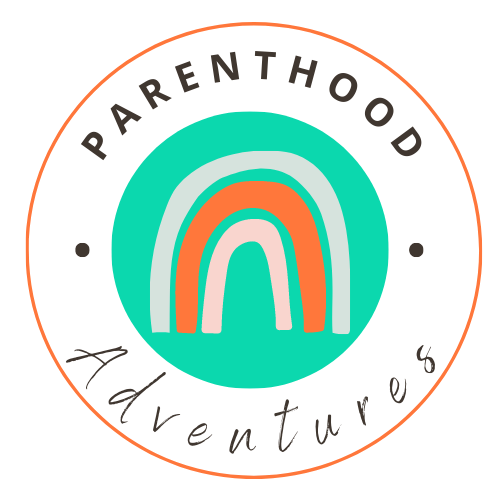
- Baby and Toddler Travel Tips
- Diaper Bags and Suitcases
- Best Travel Strollers and Tips
- Packing Lists + Hacks
- Baby travel must haves
- Babywearing
- Destinations
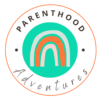
- Mom Confessions
How to Travel with Baby Formula on a Plane
By the time my son turns two, we will have taken him on over 100 flights from shorter jaunts to nearby states to international flights that lasted for 16+ hours. Over that time we’ve gone from combo feeding him to transitioning to 100% formula.
Thankfully it’s pretty simple to bring your baby’s food along once you know the rules and best practices. Here’s everything to know about how to successfully travel with baby formula when you fly:
TSA Regulations for Carry-Ons
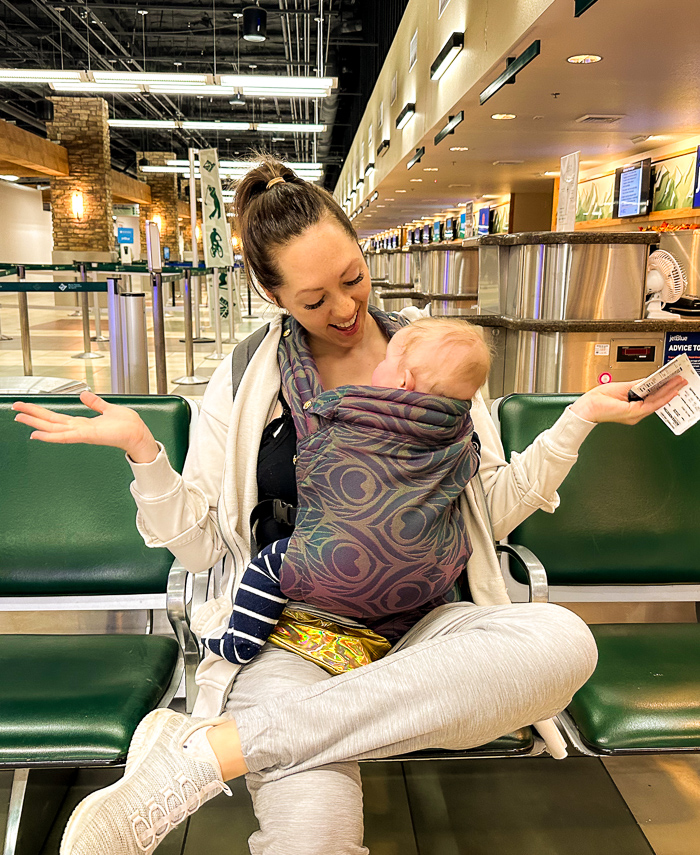
The first important thing to know is the TSA regulations regarding liquids, as you will most certainly have extra checks. Be sure to budget extra time for this! Whether you have TSA precheck or not, the following considerations all apply:
Liquid amounts
For baby food including breast milk, water for formula, liquid formula, juice, and other forms of milk, you’re allowed to bring “a reasonable amount” of each above the 100ml/container limit.
The amount that is reasonable to take through security is left up to the TSA officer. I have actually run into issues with this when they wanted us to dump one of our water bottles for his formula when our flight was only about an hour and a half. For reference we had 240 mls. I knew we were within our rights to have all of the water, and in case we had delays in the air, which has happened to us before, we needed to have it along. I remained polite but firm that we were allowed to have it and asked to speak to a supervisor, who agreed that the amount we had was, indeed, reasonable. If we’d had to dump, we could have bought water in the terminal, but I preferred to use our own.
I highly recommend printing out or saving TSA rules to your phone in case you run into any issues. Read full TSA rules here.
Extra checks
Almost no TSA experience has been the same for me, but 80% of them have involved extra checks for the liquids. Be sure to let the officer know before you go through security that you have liquids in excess of 100ml/3oz for your baby. They will probably pull them out for extra screening.
They are allowed to put the bottles through an extra machine and they are allowed to unscrew the top for a vapor test, they are not allowed to stick anything into the liquid.
I highly recommend using clear bottles , which usually means easier screening and fewer vapor tests.
Powder checks
If you have powder formula, they will probably run a white test strip over it for bomb testing as well. I have never had them open up the formula, but rather run the strip on the outside of the container. As far as I know there is no limit on the powder amounts. I’ve brought entirely full cans with me many times.
If you’re traveling abroad, be sure to look into the rules for the specific country you’re traveling out of. So far going through customs in Mexico and Japan , the experience has involved no additional checks and was much easier than US security.
Packing Formula Safely and Effectively
The worst thing would be a formula spill en route when it’s difficult to impossible to replace the formula. I’ve never actually seen formula for sale in the airport, and as far as I know Emirates is the only airline that stocks it onboard, so make sure that you bring more than enough with you in case of delays, and pack it securely.
We sometimes transfer formula to a clean Tupperware with locking lids. I also will store a can with a secure lid in the diaper bag. I make sure that I only bring unopened bags and cans of formula in my checked baggage and wrap them in clothing so that they don’t get jostled and burst. Though we don’t use liquid formula, I’d do the same with liquid cans.
That said, weight from liquid can add up quickly, and they tend to take up a lot more space, so if you also use powder, I would recommend only traveling with the powder. Also be sure to check whether your destination has formula you can easily buy. If you use a hypoallergenic or speciality formula, you may need to bring it all with you. We could have easily bought more in Mexico and Japan, though I’ve heard in destinations like Thailand it can be harder to find.
If You Need to Warm the Water
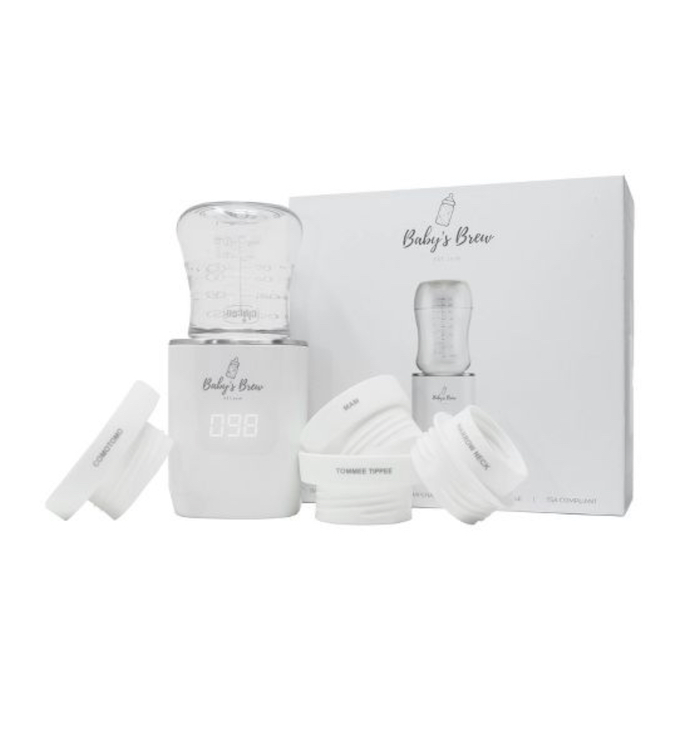
The best thing we ever did is slowly start only serving our baby room temperature formula. According to the CDC , formula does not need to be warmed to be safe to drink. When he’s hungry, we can just make a bottle on the spot. I like to pre-fill his Comotomo bottles with the exact amount of oz we’ll need for ease.
But what if your baby prefers it warm? No problem, this portable bottle/formula warmer can be charged ahead of time (or in your seat in a pinch). Consider bringing a portable power bank to recharge the warmer as needed.
I have also been offered warm water from flight attendants previously, but since we only use bottled or boiled filtered water for his formula, I’ve used what we brought since I know the origins of it.
Washing Bottles on the Go
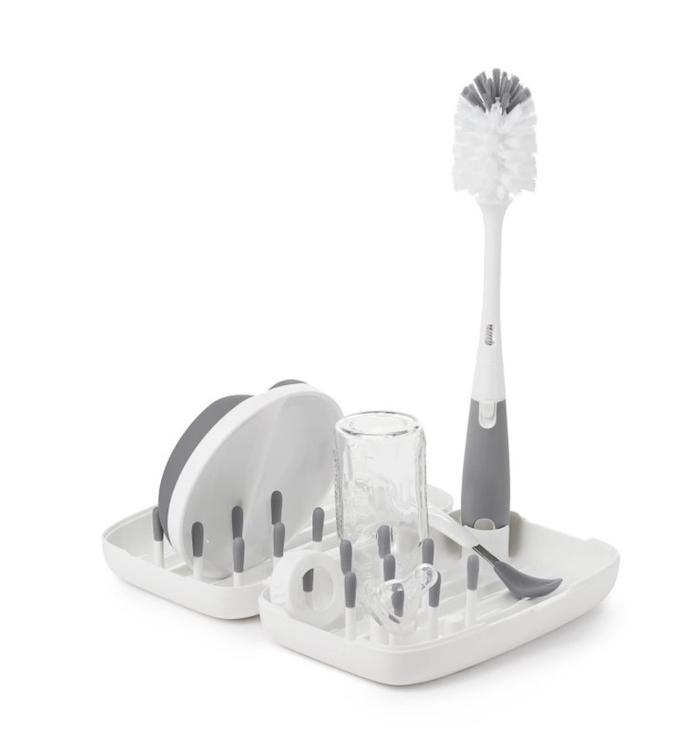
I’m in love with our OXO baby bottle brush and drying rack . I joke it’s the best $18 I’ve ever spent. We even use it at home to keep our son’s bottles totally separate from the rest of our dishes.
It folds up for easy portability and fits into our diaper bag with ease. I recommend bringing your own soap in a carry-on size bottle since airport and airplane soap is usually not the kind that you would want to use on bottles. It can be heavily scented, foam, or high in chemicals and antibacterial agents.
You can easily wash bottles in the airport bathroom or lounges. On the flights, I use filtered water from my own water bottle that I get in the terminal. If I’m out of that, I asked the flight attendant for a bottle of water. It’s never been an issue. I tend not to use the water from the top on planes as sometimes it’s not potable and I also I’m not sure about the state of their water trucks. For me I would not care, but for my baby I’m extra cautious.
Where, When, and How to Feed
As formula feeding parents know, the ease of being able to bottle feed anywhere is delightful. We have walked through the airport with our son in a carrier ( I like this one for travel days) feeding him while we walk. We are also always sure to feed during takeoff and landing to help clear his ears.
Formula feeding has been way easier than pumping, though if you combo feed, I have tips for pumping on the go and traveling with breast milk for you, too.
Overall, flying with formula is pretty simple once you know the rules and how to properly store it. It’s a bit more to travel with, but it’s not a big deal, either. Happy flying!
*Some links in this post are affiliate links that support us at no extra cost to you when you purchase through them. We only recommend products we love and use ourselves. Your trust always comes first!
Kristin is the founder of Parenthood Adventures, combining her love of travel and newfound joy of motherhood. She's the creator of one of the most-read women's travel blogs in the world, bemytravelmuse.com, with a readership in the millions each year.
Similar Posts
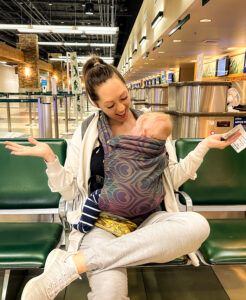
How to Survive Flying with a Baby (50 Tips!)
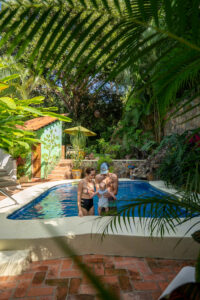
Is Mexico Baby Friendly? Everything to Know Before You Go

What is a Family Restroom and Who is it For? (And NOT for?)
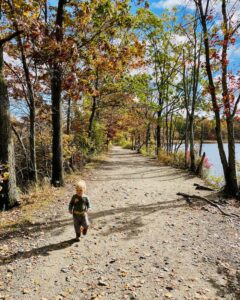
Hiking with a Toddler: 35 Important Tips

How to Get Through TSA with a Baby (Precheck and More Tips)
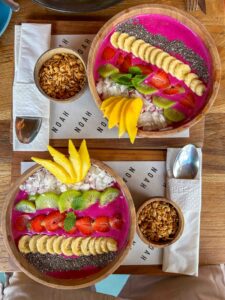
How to do Baby-led Weaning While Traveling
Taking our first flight with our daughter (3 months old) next week. It’s a 12 day trip which is a bit intimidating! I am combo feeding so this is helpful! Planning to leave my pump supplies at home and just do breast/formula.
You got this! Have fun! It’s a great age to travel with.
Leave a Reply Cancel reply
Your email address will not be published. Required fields are marked *
Save my name, email, and website in this browser for the next time I comment.
This site uses Akismet to reduce spam. Learn how your comment data is processed .
How to Travel with Baby Formula (Explained)
By: Author Elizabeth Ciobanu
Posted on 06/21/2022
Traveling with a bottle-fed baby can be overwhelming because there are so many moving parts to keep track of. But considering the comfort and health of your baby, the best approach is to plan ahead for everything you will need for your journey with your baby.

You need to consider several things when traveling with baby formula. First is the number of days you will be away and the safety of the formula.
Taking enough formula shouldn’t be an issue when traveling in the car, but if it’s by plane, there are restrictions on how much prepared formula you can bring.
You don’t have to cancel your travel plans because your baby is too young. You can still travel and enjoy yourself with proper planning.
This blog post will guide you on how to travel with baby formula by car or plane. I will also discuss some other topics related to traveling with baby formula to help you feel confident and ready for your trip.
How To Travel With Baby Formula By Car

You’ve probably traveled with your baby in the car many times already, but taking a longer trip might seem daunting.
Nevertheless, you will have to be a bit strategic because traveling by car often takes longer than a plane trip.
Also, you have less freedom to move the baby about or offer comfort while she is strapped in her car seat.
One such hassle while traveling with your baby in the car is that it is not safe to feed your baby in a moving car even if they can hold the bottle by themselves. You will need to stop to give the baby her bottle.
But here are some strategies that will help you be more efficient on your car trip with your baby.
Bottle Preparation
Preparing the baby’s bottle of formula before hitting the road is the most important thing to do. Ensure your hands are clean to avoid contamination that might lead to stomach upsets.
Get this done before you leave, as you may not have a clean way of preparing the bottle during those pit stops you make on the road.
Once the bottle is clean, fill it with the baby formula and pack it in an insulated bag or a cooler, but make sure you use any prepared bottles within 24 hours.

Keep Everything Within Your Reach
Ensure everything the baby needs is kept up front (not packed under all the suitcases in the trunk!) before hitting the road. Realizing that you left something you need at the back of the car when feeding the baby might be frustrating.
Ensure you can access the baby’s bottle and warmer easily and start warming the formula in time so that it will be ready when you stop.
Have a Place To Store The Used Feeding Bottles
Cleaning used bottles before reaching your destination may not be practical. It is therefore wise to have a wet bag for storing them. This way, you will avoid having your car cluttered with bottles.
You can also sanitize the bottles and wipe the wet bag easily once you have arrived at your destination.
How To Travel With Baby Formula By Plane

Parents traveling with infants are allowed to carry bottles of baby formula when traveling by plane. But you must be strategic about carrying it and feeding your baby as easily as possible without missing or delaying the baby’s feeding time.
The following tips should help you think through how to do this.
Prepare The Bottles Ahead of Time
Airport navigation is not easy, not to mention the process of boarding the plane. You will have a lot to worry about, so you should prepare the bottles in advance.
Kids’ health experts advise that you can prepare a baby’s formula up to 24 hours ahead of time, provided you refrigerate it. Take advantage of this and store baby formula in a cooler bag. It will be easier to pull it out and warm it during feeding.
Carry a Travel Bottle Warmer
A baby bottle warmer is essential when traveling by plane or car. It is the only way you can warm the milk well in advance. This way, you won’t have to rush and start warming the milk when your baby gets angry.
You don’t also don’t want to bother passengers with a crying baby, so it’s good to put the formula in the warmer in advance.
Feed The Baby When The Plane Takes Off
A strategic plan is to feed your baby when the plane is taking off. This will come in handy in keeping the baby calm during the transition and helping your baby’s ears adjust to pressure changes.
Also, feeding the young one at this time will increase the chances of falling asleep for a better part of the flight. If this happens, you will get time to relax after the stressful moment of boarding the plane.
Which Baby Formula is Best For Traveling?
There are several baby formula options you can consider when traveling.
One option is to carry some water and a premeasured formula. However, this method demands that you avoid using a vacuum flask for the formulas’ storage since it may cause some security issues, especially at the airport.
The other better option is carrying ready-made formula. It is easy to use because all you are required to do is pour the formula into the baby’s feeding bottle. Some airports have baby shops where you can buy the formula before checking in.
Nevertheless, you must confirm with the airport you will be flying from and know the type of formula they stock, and the cost.
What Are The Must-Haves When Traveling With Baby Formula?
Formula powder dispensers.
Any on-the-go parent must have a formula dispenser when traveling. The containers help in preparing quick bottles. It holds and measures the formula for you. They come in different types and sizes; therefore, you can choose one depending on your preference and traveling schedule.
While it may seem more convenient to just pick up some formula from wherever you’re heading, there’s no guarantee that you’ll be able to find your usual brand. It’s best to take a good supply of what your baby is used to so minimize the chances of stomach upset or baby refusing the bottle.
Convenient Bottle
You need a convenient bottle when traveling, and one that baby has already gotten used to at home. Don’t try to change things up the day you leave, but get her used to the travel bottle well before leaving.
Pick a bottle that’s easy to carry, clean, and use.
Also, bottles that come with pre-sterilized liners are better because they not only ensure your bottle is clean but also reduce the time you take to clean it up, hence perfect for travel.
Water For Baby Formula
If the type of baby formula you are carrying requires some water to make, you should carry the water with you. You can carry distilled, tap, or bottled water since they are considered best for making baby formulas.
Nevertheless, you may have to boil the tap water to kill any microbes that could be in it. Do this before leaving home!
Traveling with your baby doesn’t have to be a nightmare. All you need to do is plan your trip well, whether traveling by air or car.
Also, remember to carry everything you need to make the baby formula when it’s feeding time. This way, you will have an easy time far away from home.
- Getting Pregnant
- Preschooler
- Life as a parent
- Birth Clubs
- See all in Community
- Ovulation calculator
- How long will it take to conceive?
- When to take a pregnancy test
- Best sex positions
- Top signs of pregnancy
- How soon after your period can you get pregnant?
- How age affects fertility
- Earliest pregnancy symptoms at 2 weeks
- What fertile cervical mucus looks like
- Think you're pregnant but the test is negative?
- Faint line on pregnancy test
- See all in Getting Pregnant
- How big is my baby?
- Due date calculator
- Baby movements week by week
- Symptoms you should never ignore
- Hospital bag checklist
- How your baby's developing
- Signs of labour
- Your baby's position in the womb
- Baby gender predictor
- How to count pregnancy weeks
- Nuchal translucency (NT) scan
- Fetal development chart
- See all in Pregnancy
- Baby names generator
- Baby name inspiration
- Popular boys' names
- Popular girls' names
- Names inspired by nature
- Place names as baby names
- See all in Baby Names
- Your baby week by week
- Baby milestones by month
- Baby rash types
- Baby poo: what's normal?
- Travelling with your baby
- Sleep training methods
- Teething signs
- Growth spurts
- See all in Baby
- Your toddler month by month
- Toddler development milestones
- Dealing with tantrums
- Toddler holiday packing checklist
- Food & fussy eating
- When to start toilet training
- Moving from a cot to a bed
- Bedtime battles
- Games & activities
- Vomiting: what's normal?
- See all in Toddler
- How to raise a happy child
- Discipline strategies for preschoolers
- How kids learn to share
- Coping with aggression
- When do kids stop napping?
- Dealing with night terrors
- How to stop kids biting nails
- What to say instead of 'no'
- Ways to teach good manners
- See all in Preschooler
- Postnatal symptoms to watch out for
- Pain and stitches after giving birth
- Postpartum blood clots - when to worry
- Government benefits for families
- Sex secrets for parents
- See all in Life as a parent
- Baby teeth chart
- Best baby monitor
- Car seat laws
- When do babies roll?
- Baby christening
- When do babies smile?
- Humidifier for baby
- When do babies sit up?
- Best baby formula
- Missed miscarriage
- How to swaddle a baby
- Why am I throwing up yellow in pregnancy?
- 6 weeks pregnant bump
- Safe cheeses in pregnancy
- How much formula do babies need?
- Increased fetal movement
- Girl or boy? Old wives' tales
- How to clean baby's ears
- Can you eat ham when pregnant?
- Protein in urine during pregnancy
- Iron rich foods for babies
- Pregnancy meal plans
- C-section hospital bag
How can I formula feed on a plane trip?

- Mix up a fresh feed at home on the day you need it.
- Cool the feed in the back of the fridge , where it’s coldest, for at least an hour.
- When you're ready to leave, transfer the feed into a cool bag with an ice pack and use it within two hours. If you don’t have a cool bag, use the feed within one hour.
- When your baby is ready for her feed, warm the milk for no more than 15 minutes.
Was this article helpful?
Making a bottle of formula milk

How long can I keep formula milk out of the fridge?

How do I store formula when I am out and about for the day?

Sterilising bottle-feeding equipment

BabyCenter's editorial team is committed to providing the most helpful and trustworthy pregnancy and parenting information in the world. When creating and updating content, we rely on credible sources: respected health organisations, professional groups of doctors and other experts, and published studies in peer-reviewed journals. We believe you should always know the source of the information you're seeing. Learn more about our editorial and medical review policies .
Where to go next

12 tips on how to travel internationally with a baby

Traveling with an infant is already an adventure -- and traveling abroad with one is an even bigger feat to tackle.
Knowing the rules, researching and prepping ahead of time and packing the right things can make (or break) your first international trip with a baby. If you're in the know, you can take advantage of all the options afforded to traveling families, from bassinets on the plane and security shortcuts to special infant fares and other perks.
Covering everything from booking and documents to travel insurance and even jet lag, this guide provides everything you need to prepare for an international trip with your baby.
Want more travel news and advice from TPG? Sign up for our daily newsletter .
Get your baby's passport
Before you get too far into planning a trip abroad, you'll need to get your baby's first passport .
While you're at it, make sure everyone else in the family has a valid passport, too. Remember, U.S. passports for children under 16 expire after five years, not 10 years like adult passports. Also, make sure everyone's passport isn't nearing expiration. Many countries require three or six months of validity to enter, which effectively means that child passports are really only valid for 4 1/2 years, which go quickly.
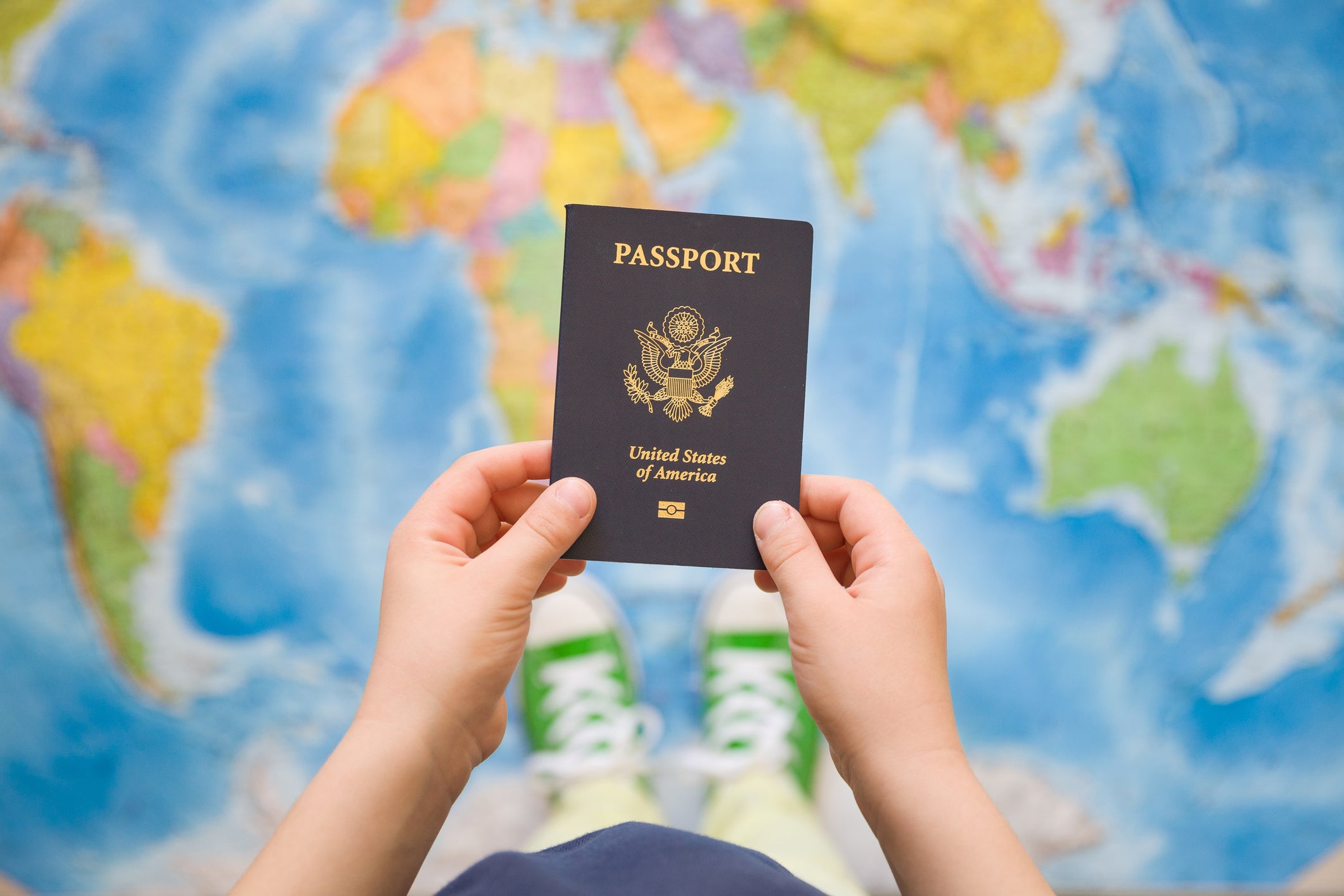
When getting a passport for your baby , here are the main steps to follow:
- Get their birth certificate.
- Find out where to apply.
- Make an appointment. You'll need to go in person and bring your baby with you.
- Take their passport photo. It can be difficult to get a photo of your baby. Rules for photos state that the child/baby should be looking directly at the camera with a natural smile or neutral look. If you can manage to get the baby's eyes to stay open, that's typically enough for their first passport photo. The background should be white and the size 2 by 2 inches with no filters. Within that size, your baby/child's head needs to be 1 to 1 3/8 inches (25 to 35 mm) from the bottom of the chin to the top of the head. If you're struggling to get everything just right, the ItsEasy App can help you crop and size your photo to the correct dimensions.
- Gather the paperwork. Fill out Form DS-11 and take your baby's birth certificate plus photocopies of each document. Bring a couple of photos, a valid ID for each parent, a photocopy of parental IDs and the fee (you can pay by check). Fees are currently $100 for the passport and $35 for processing.
- Attend the appointment in person with both parents present . If only one parent can go, fill out and bring parental consent form DS-3053 plus a copy.
Get your baby Global Entry
If you already have Global Entry , you won't be able to use the service as a family if your little ones don't have it. So, get a start on your baby's application. Or, if this is something your whole family wants to do, apply simultaneously, making expiration dates and renewals easier to complete for everyone at the same time.
Do note that with TSA PreCheck , kids 12 and under won't need to have their own number to accompany parents through these special security lanes -- but that's not true for Global Entry, which you use to return to the U.S.
Check with your doctor
Check with your pediatrician to see when your baby can start flying.
To give you an idea, TPG talked to Dr. Jenny Yu , medical director at Healthline , to find out when it's typically safe for babies to travel. "While babies typically develop their immune system around 1 month, most pediatricians would recommend waiting until 3 to 6 months for travel," she said. For premature babies, it might be a little longer.
Also, with international travel, it's important to factor in any additional vaccines they might need, especially if you're traveling to emerging countries. Start by checking with the U.S. Centers for Disease Control and Prevention for recommendations on which vaccines both adults and babies should get, then talk with your pediatrician to see what is best for your family, baby and travel situation.
Other important questions to ask your doctor should be if your baby can wear sunblock or mosquito repellent and how to keep your baby and your whole family safe from tropical or waterborne diseases, COVID-19 and any other possible infections, which can depend highly on your destination.
Pick the right destination
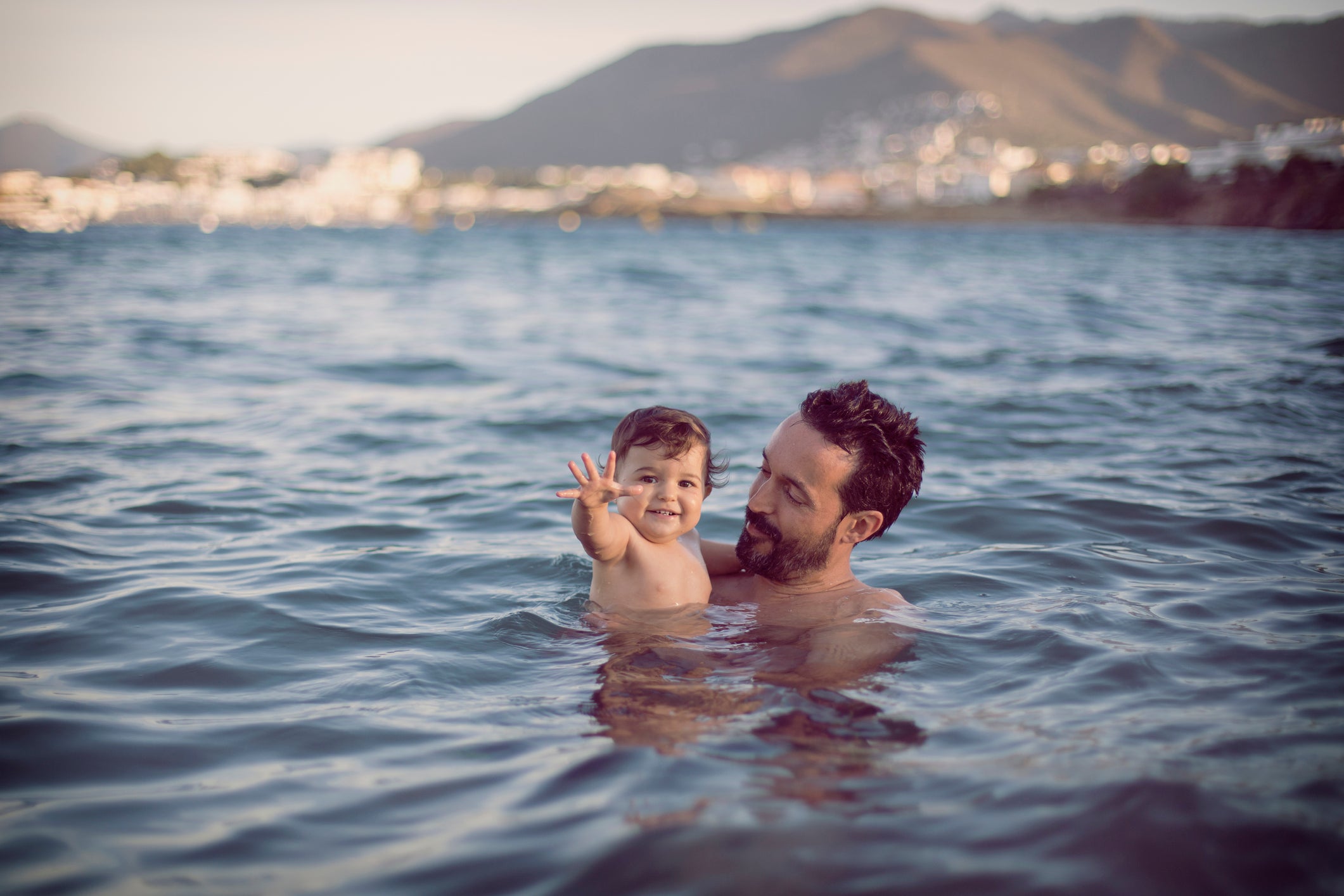
Whether it's a far-flung visit to Asia, a trip to visit family in Europe, a Caribbean escape or an African safari, you can travel anywhere with a baby as long as you and your family feel comfortable doing so. Choose a destination that makes you feel joy, not anxiety or stress at the thought of getting there and enjoying it with your baby.
Consider things like the activities you want to do, and if the destination is a place that feels welcoming for families. Also think about logistics, like the language barrier, climate and local transportation, when deciding if that particular destination is right for your family.
Book tickets
Depending on how old your baby is, you have some options when flying abroad with them. Here are a few to consider:
- Lap infant: If your baby is under 2 years old, they don't need their own seat. They can instead sit on the lap of a ticketed adult. For international travel, some airlines charge 10% to 30% of the adult ticket price or just the taxes and fees for a lap infant, and some airlines don't charge anything at all. This table shows the costs by airline to buy your baby a lap ticket. Make sure to check on luggage policies when traveling with a lap infant. Most airlines allow for a stroller and car seat checked free of charge. You may also be able to check or carry on additional baggage, too, but more on that later.
- Bassinet for lap infant: Many airlines have bassinet options, especially aboard larger aircraft that fly internationally. See if you can select this option while booking or call the airline for more information on securing a bassinet. Bassinets are usually free, but given to those who request them first. Ask for one right after booking to ensure you'll be assigned a seat with one when available. In most cases, bassinet weight limits max out at 20 to 24 pounds, so they're best for smaller babies and newborns.
- Extra seat with car seat or restraint for babies 2 years and up: If your baby is older than 2 years, you must pay for their seat. Many airlines have discounted tickets for children. If the child weighs more than 44 pounds, they won't need any additional restraint system within their own seat. If they weigh less than 44 pounds, see the information on a certified child restraint or car seat below.
- Additional seat with car seat or restraint for babies under 2: If your baby is less than 2 years old, you can still book them their own seat. In fact, the Federal Aviation Administration suggests that children under 44 pounds wear an FAA-approved harness (such as the CARES harness ) or certified child restraint to help keep them safe during turbulence, takeoff and landing. Make sure to check your car seat to see if there is an FAA-approved sticker on it.
It's worth noting that car seat, bassinet and harness options and policies vary wildly by airline and class of service. For more information on these policies by airline, read this article on 23 airline car seat and bassinet policies around the world .
Note that when booking seats for your family on an international flight, there are areas where kids and babies are not allowed to sit, like exit rows. Malaysia Airlines doesn't allow babies in its first-class cabins on A380 and 747 aircraft. Some international airlines such as AirAsia, Scoot and IndiGo also have kid-free and quiet zones where families with babies and children under a certain age (usually 10 or 12) aren't allowed to sit.
Additionally, if your baby is closer to 2 years old, you might want to compare the price of a lap ticket to the price of getting them their own seat. Sometimes, the price difference may not be that much, and it could make the flight more comfortable for the entire family.
Organize documents, including visas and COVID-19 forms
Passports aren't the only documents you'll need for international travel these days. Check to see if you and your baby need a visa to enter whatever country you're visiting. If you're traveling without your partner, look into completing a Child Consent Form.
Have proof of vaccines, complete any health forms and entry forms and take those COVID-19 tests if required to enter the country. Be clear on if your baby or children need to wear masks during the flight and plan accordingly. While babies 2 and up need to wear masks on board U.S. airlines, international airlines have different rules. For example, Iberia only requires children 6 and up to wear masks. Presently, British Airways has made masking up for all passengers a "personal choice" when not required by international law. We expect these rules to continue to rapidly evolve.
It's worth checking what documents you need for the trip when booking and again before traveling to ensure that you have everything you need as rules and regulations frequently change, especially in this era of pandemic travel .
Understand luggage rules
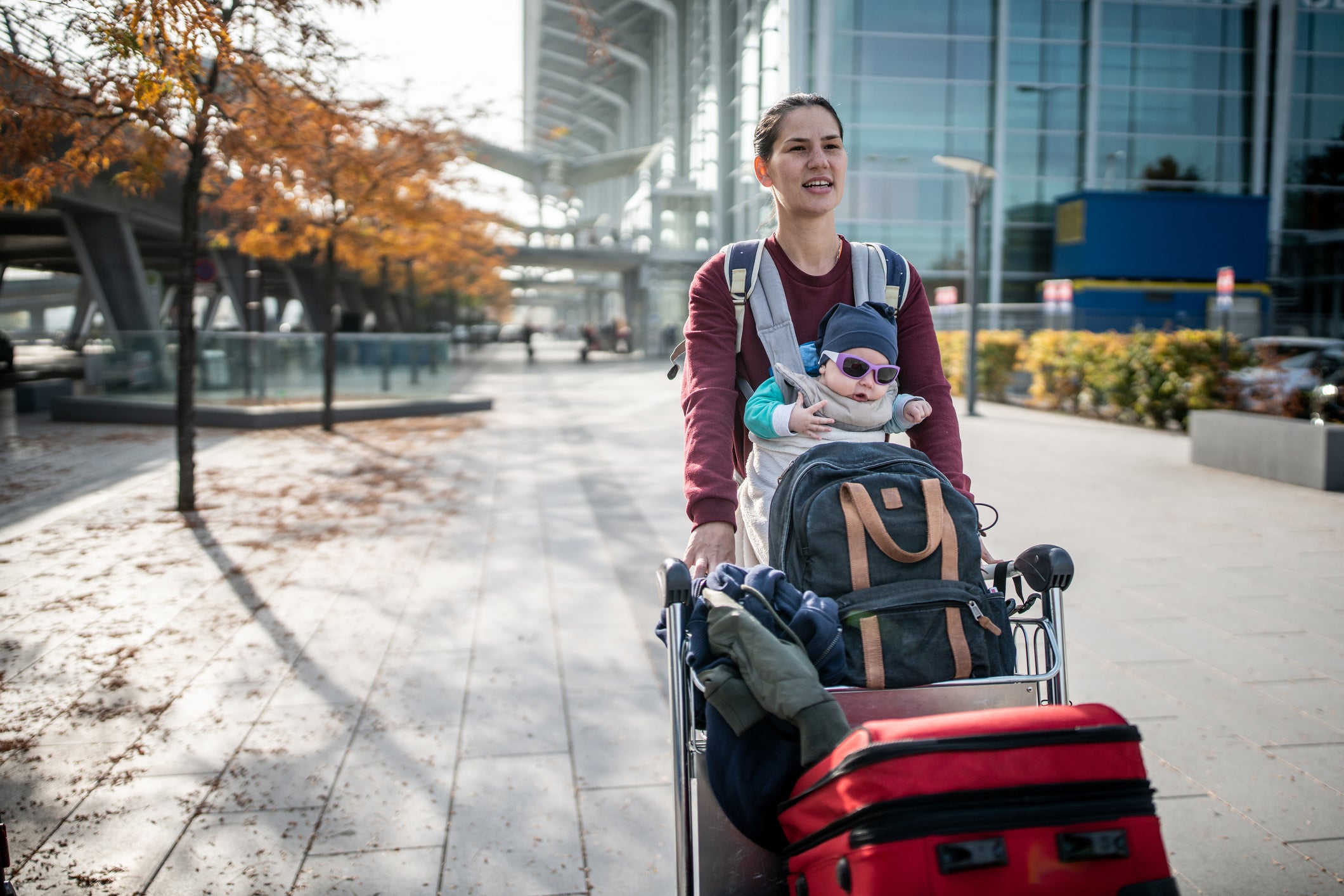
Different airlines have varying rules for how much luggage you can take when traveling abroad, especially when traveling with lap infants or children/babies occupying their own seats. Most airlines allow you to check a stroller and/or car seat. Many also offer additional checked luggage, as well as a carry-on bag or item for the baby.
For example, British Airways allows both lap infants and children ages 2 and up to have a carry-on item and a checked bag in most cases, giving parents a little flexibility when bringing along all those key items babies need . Cathay Pacific allows lap infants two additional bags at 10 kilograms each when flying between most destinations.
If you aren't clear on the luggage rules, call the airline before traveling to confirm so you won't get stuck with any surprises or have to pay additional fees.
Know the rules for breast milk and formula
Thanks to the Friendly Airports for Mothers Improvement Act, all large- and medium-size airports in the U.S. now provide lockable, non-bathroom places to pump or nurse babies in every terminal and at least one men's and one women's restroom with changing tables in each terminal. This may not be the case abroad, so if you're concerned, research your destination airport to see what options are provided when it comes to these services.
You shouldn't have any issues flying with breast milk or formula on your outbound trip from the U.S. , as regular Transportation Security Administration liquid regulations don't apply to these special liquids. According to the TSA , "reasonable quantities" of these liquids are allowed, but you must take them out during screening for the security officer to test.
You can look up rules to see what's allowed when returning from your destination. For example, the United Kingdom allows breast milk past security in containers up to 2,000 milliliters. You can also take formula, milk and bottled water for the baby, but the baby must be present. In the European Union , you can take breast milk and formula through security and when flying as long as your baby is traveling with you.
Your airline may also provide clarity on these types of rules. Cathay Pacific, for example, states that breastfeeding is allowed during all phases of the flight, using an electric pump is allowed once electric devices can be switched on and travelers can even bring along suitably packed dry ice to refrigerate expressed milk, assuming it's declared during check-in.
According to some airlines, if you're taking a large breast pump along, this may count as a medical device and not be part of your carry-on allowance, but these regulations often aren't very clear. Contact your airline for more information and print out the rules in case you have any issues during security screening or boarding.
If you're traveling from a very obscure destination within an emerging country and you can't find answers about bringing breast milk, it may be best to have a Plan B in place, such as bringing along enough formula in powder form to last you for the flight or planning to pump or breastfeed in flight.
Should you want to ship your breast milk abroad, options are available for you depending on your destination, such as Maven Milk and Milk Stork .
Book accommodations
When booking accommodations in your destination abroad, take things into account like baby necessities, baby-friendly items, the option to do laundry and the availability to heat, cool and store milk and formula. Choosing a vacation rental instead of a hotel may be the right idea if you need more space, a kitchen and laundry facilities.
If your baby is eating solid foods, make sure there are restaurants or supermarkets nearby where you can get exactly what you need. Doing a little pre-trip research can help you feel confident and comfortable when traveling with your baby regardless of which hotel or home rental you choose to stay in.
Pack strategically
Packing with a baby can seem precarious, but it doesn't have to be. Just make sure you have enough of everything you need to get through the flight, plus a bit extra in case of delays or cancellations. For an exact list of everything you need to pack, see this article on how to pack -- and prepare -- for travel with a baby .
For extra-long flights, try to have everything to help your baby comfortably nap on hand, like a lovey, blanket, pacifier and more. Have changes of clothes on hand for the whole family in case of a messy situation, and enough layers for a plane that may be hot or chilly. A baby carrier can be key, too.
When packing for a trip abroad, the most important items to remember are everyone's passport, visa and key documents, plus anything essential that you know you can't get in another country. Babies live all over the world, so you can easily get items like diapers, wipes, formula and more anywhere. However, you may not find the exact brand you want, or if you're going somewhere rural or far-flung, like on a safari in Africa, you may want to bring enough for your entire trip.
For example, Enfamil, a popular baby formula brand, is found all over Europe and even in the Caribbean and Latin America. However, it may not be available in Africa or Asia, so do your homework.
If you're traveling with items that need to plug in to charge, like a breast pump, baby monitor or nightlight, bring converters if necessary. You can always rent baby items abroad, too, rather than lugging everything along with you. It's possible to preorder diapers and wipes in many destinations, as well.
Strongly consider travel insurance
Things happen. While getting the flu abroad may not be a big deal for an adult, a sick baby can be scary and stressful, especially if you're in a foreign country. Having travel insurance that covers accidents and emergencies -- and COVID-19, too -- can set your mind at ease and save the day if something happens.
Before travel, note where the nearest hospital or health care facilities are, as well as any international hospitals where staff may be more likely to speak English. Know exactly how to use your insurance, like what numbers to call or what to do if a situation arises. Check if any of your credit cards have travel insurance that may cover you and your family if things go awry.
Plan for jet lag
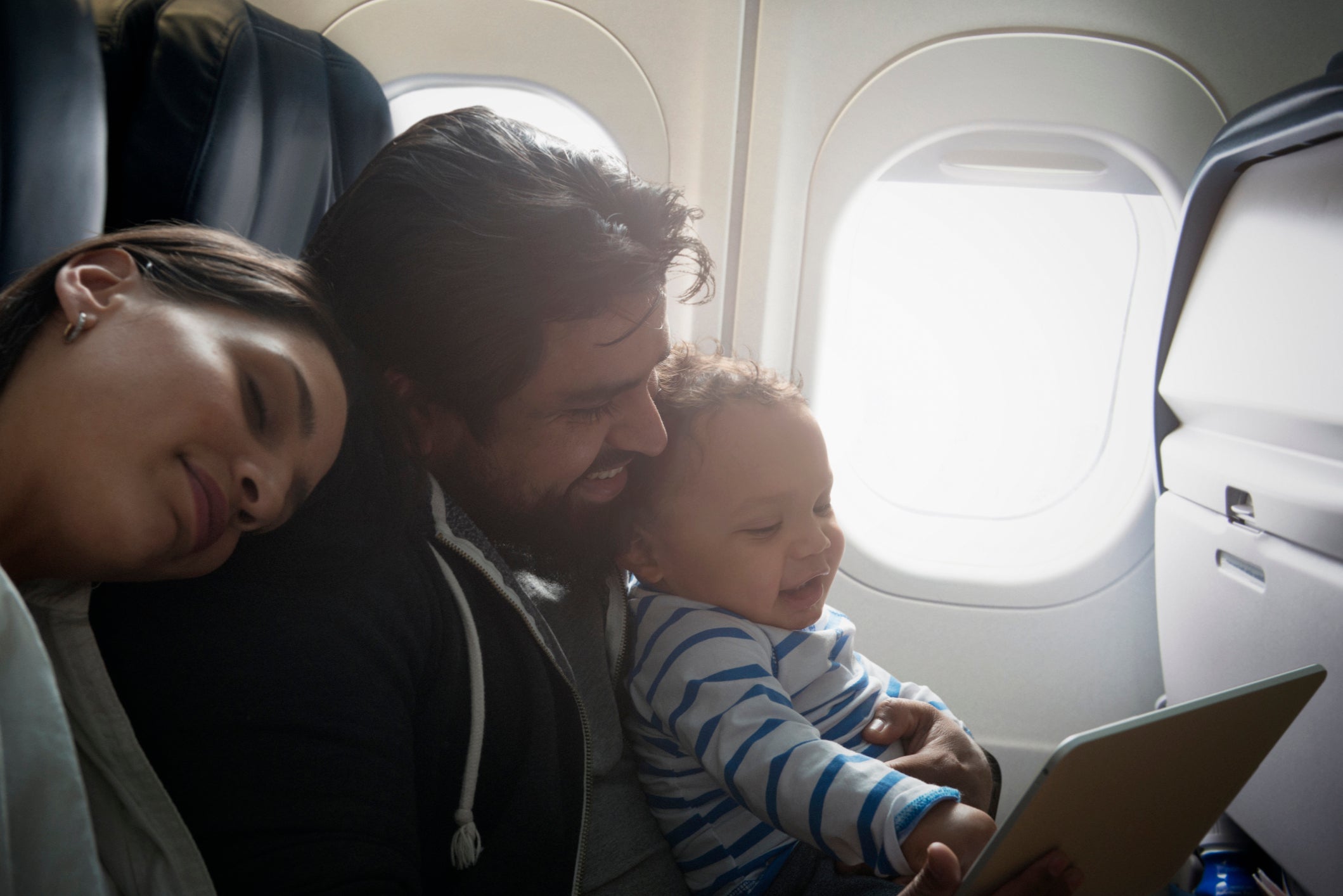
Jet lag stinks. Jet lag with a baby might be even worse. There are things you can do to make jet lag a little less stressful, though, especially when traveling abroad to very different time zones.
First, give yourselves a few days to adjust, planning big events later in the trip. Limit your baby's naps when possible. If your baby takes a five-hour nap, they definitely won't be sleeping through the night.
Shift mealtimes, naptimes and bedtimes to the new time zone as quickly as possible, getting daylight during the day and darkness at night, so internal clocks begin to adjust for the whole family. If the time zone difference is small, you may want to keep your baby on the original time zone to minimize disruption, especially for a shorter trip.
For more tips on combating jet lag with a baby in tow, read this guide on surviving jet lag with your baby .
Bottom line
Planning and taking an international trip with a baby can be simple and create memories for a lifetime if you prepare just right. With a little bit of extra research, you'll be armed with everything you need to know, do and bring to make your trip abroad smooth and hassle-free.
Can You Bring Baby Formula On A Plane? (Powder vs Liquid TSA Rules)
Last Updated on August 7, 2022
So you want to know how to travel with formula…
How much formula can you take? And how should it be packed when going through the airport security checkpoint?
Let’s find out quickly before your baby needs fed or a nappy needs changed!
TSA Baby Formula Rules
The Transportation Security Administration runs airport security. They decide what you can and can’t take on a plane.
Here’s a screen-grab from their website about flying with formula:
Note the special instructions for bringing baby formula in carry-on luggage.
Here’s the deal. The instructions are a little different for baby formula powder and premixed liquid formula.
Flying With Powered Baby Formula
You can bring powered baby formula on a plane in your carry-on bag or checked bags.
But when packing powdered formula in hand luggage the powders rule applies.
There is no limit to the amount of powdered baby formula you can pack in your carry-on luggage.
But if your powdered can is over 12 oz then remove it from your carry-on bag and place it in a separate tray when going through security so it can undergo additional screening.
It doesn’t matter if your baby’s formula is opened or unopened.
Flying With Liquid Baby Formula Or Water
You can also bring bring premixed liquid formula or water to mix with your powdered formula. The usual 3.4 oz liquids rules does not apply and you don’t need to pack the liquid in your quart sized bag.
The same goes for bringing breast milk in carry-on baggage.
You can also bring formula cooling accessories like ice packs, freezer packs, or frozen gel packs.
So you can cool formula bottles with an ice pack when traveling. Once you are on the plane you can ask a flight attendant for hot water to get your baby’s meal back up to a temperature they will enjoy.
Your baby does not need to be present when going through security (but it helps). In theory you just need to explain to the TSA officer at the checkpoint that you are bringing the water or liquid formula as a medically necessary liquid for your baby.
When an infant is old enough to walk through security unaided they are no longer considered to be an infant by the TSA and this exception to the usual liquids rules no longer applies.
It’s recommended that you transport any liquid baby formula in a clear translucent bottle to help with the screening process.
Liquids stored in plastic bags or pouches can’t be screened by the bottle liquid scanners so you might be asked to open them.
X-ray machines don’t negatively impact formula or breast milk but if you don’t want the TSA to use them you can ask that they are screened separately the liquid using other methods.
How Much Formula Can You Take On A Plane?
Since medically necessary liquids are exempt from the usual liquids rules there is no limit on how much you can bring.
The same goes for powdered baby formula. There is no limit to how much formula you can take on a plane.
So you won’t have any problems with reasonable quantities in carry on bags.
You airlines carry-on luggage size limits do still apply. So check with your airlines if you are bringing a diaper bag in addition to your carry-on suitcase.
Some low cost airlines don’t permit you to bring two bags into the cabin.
The Verdict
When flying with baby formula or baby food the regular security rules don’t apply.
The TSA is sensible enough to know that parents traveling need to always be able to bottle feed their baby and so baby formula is considered medically necessary.
Quantities greater than 3.4 ounces are permitted for liquid baby formula, and their is no limit on how much powdered baby formula you can bring. You can even bring water for babies too!
Happy flying!
Did This Page Help You?
You might also like.
- Can you wear your baby through the security checkpoint?
- How soon can a newborn baby fly?
How Can We Fix The Page?
Please let us know how to improve the page we'll try to fix it.
There Were Errors On The Page It Was Missing The Information I Needed
Tell Us More...
Your Name (required)
Your Email (required)
Great! We Aim To Please!
Maybe you can help us.
Social shares allow us to continue to publish more articles so if you can help out by sharing it would be much appreciated!
Luggage shop by size
How To Travel With Baby Formula And Food
Travelpro Travel Expert Editor
Tips & Tricks
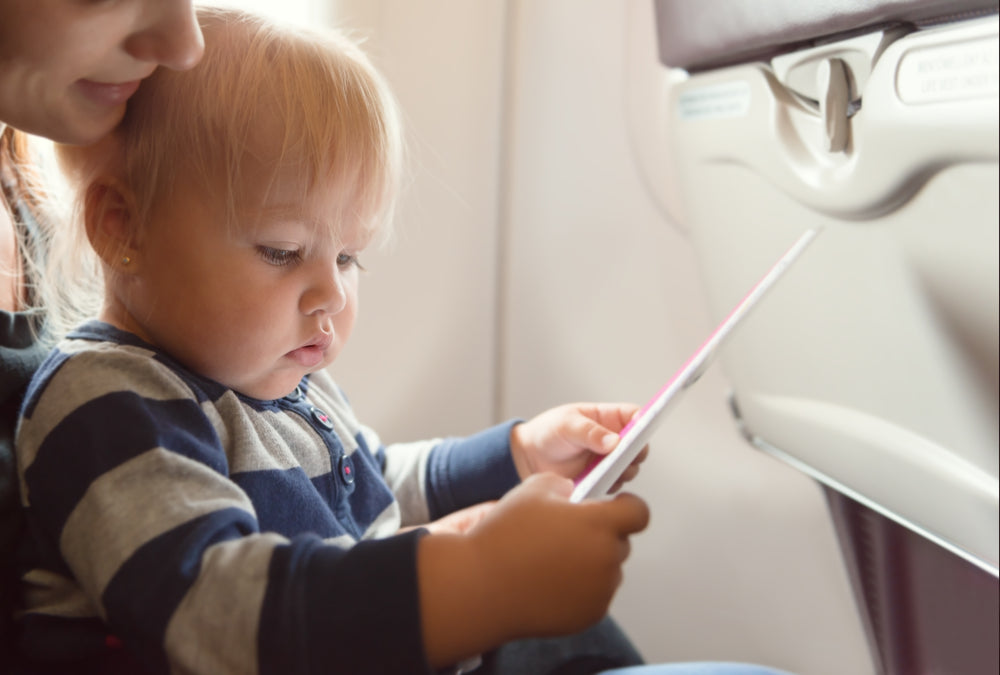
Planning a family trip is exciting, but packing for it can be overwhelming, especially if you plan to fly with your little ones. You can travel with milk, formula, or baby food no matter where you are. When you must pass through airport security and have enough supplies on hand for days, handling these items requires some simple preparation.
Before packing your bags, here are a few tips on traveling with baby formula and food so that you – and the whole family – stay happy.
Can you bring baby formula on a plane
The TSA classifies baby formula as medically necessary, so you can pack as much baby formula as you need for the trip without being limited to the 3.4-ounce rule that applies to other liquids. When you go through security screening, inform airport security of the amount of baby formula you’re carrying. Remove the formula from your carry-on so the agent can screen it separately. TSA officers may test the liquid to confirm it is baby formula and not a prohibited liquid.
Can you bring powdered formula on a plane?
You can pack unmixed baby formula in your carry-on. As with premixed powder, inform the TSA agent you have the baby formula during screening. Ideally, keep the formula in its original packaging. Security may test a small portion of the formula for prohibited substances but will not add anything to the formula package.
Breast or Store-Bought Milk
The rules for breast milk are the same as for baby formula. You can bring as much breast milk as you need for the trip in your carry-on, preferably stored in transparent bottles. The same rules apply if you’re wondering how to travel with milk for a 1-year-old. Milk for older children will be subject to the same 3-1-1 rules as other liquids.
Can you bring baby food on a plane
You can bring baby and toddler food on a plane in quantities greater than 3.4 ounces, including jars and baby food pouches of fruits, vegetables, and meat/poultry purees. Store the food in well-sealed containers separate from the rest of your personal belongings.
Can you bring homemade baby food on a plane?
Homemade baby food is allowed in carry-on bags but may be subject to additional screening by TSA agents. Label all homemade baby food before packing, and have it stored in an accessible location in your carry-on bag.
How to keep baby formula and food safe on board
Once you have figured out just how much baby formula powder/ breastmilk and food you should pack, you need to plan how to keep the food safe. Some trips can be long and involve many more hours than just your flight time. How can you ensure your baby’s food stays fresh?
Here are a few things you can do to ensure that your baby's food and formula are safe during travel:
- A travel cooler bag is your best bet for day trips to week-long adventures. Some are made for wet and dry foods and can be used to keep food warm or cold.
- Check baby food and formula containers for expiration and refrigeration requirements
- Use ice packs to keep food and formula cold when needed.
- Avoid giving your baby food from open containers that have been sitting out at room temperature for more than two hours.
- Do not heat baby food or formula using the airplane's microwave.
Being prepared by following these few guidelines will give you peace of mind for a safe and healthy trip. Check out more of our family travel blogs for other helpful tips and tricks on kid- and baby-friendly travel.
Share on Facebook
Tweet on Twitter
Pin on Pinterest
You might also enjoy
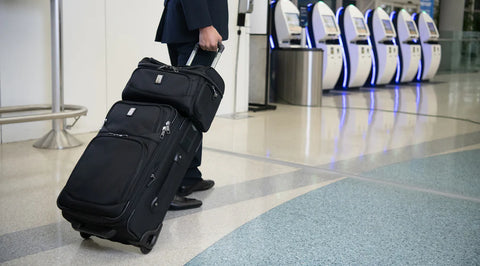
Tips & Tricks For Navigating an Airport Like a Pro
Travelpro Travel Expert Editor The Travelpro® Blog
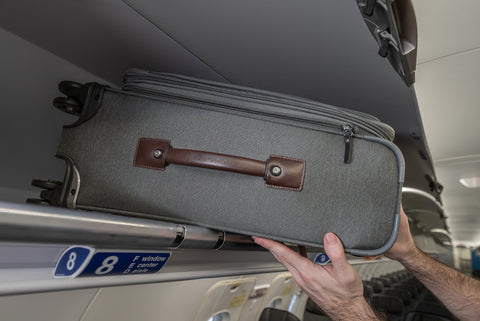
How to Board a Plane
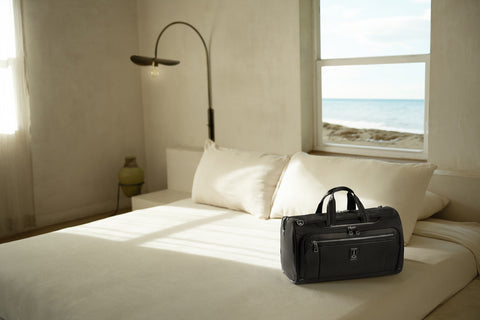
Duffle Bags as Carry-On: Everything You Need to Know
Flying with breast milk or formula? Don't worry about liquid limits. Here's what to know.
Actress Keke Palmer called out airport security officers in Houston this month on Twitter , saying they threatened to throw out more than 16 ounces of breast milk as she was going through security.
The officers were unambiguously in the wrong if they did ask her to get rid of her breast milk.
A Transportation Security Administration spokesperson told USA TODAY the agency was not aware of the incident but said travelers are encouraged to submit comments and concerns to the agency directly if they encounter issues during their screening.
TSA regulations make generous allowances for milk and formula:
Formula, breast milk, toddler drinks, and baby/toddler food (to include puree pouches) in quantities greater than 3.4 ounces or 100 milliliters are allowed in carry-on baggage and do not need to fit within a quart-sized bag. Formula, breast milk, toddler drinks, and baby/toddler food (to include puree pouches) are considered medically necessary liquids. This also applies to breast milk and formula cooling accessories, such as ice packs, freezer packs, and gel packs (regardless of presence of breast milk). Your child or infant does not need to be present or traveling with you to bring breast milk, formula and/or related supplies.
Travelers can also notify the TSA if they plan to travel with medically necessary liquids.
Nikeytha Ramsey, founder and CEO of Junobie, a company that produces sustainable, plastic-free storage containers for breast milk and baby formula, said it’s important for parents to know their rights when they fly with such liquids and to stick up for them if they run into any problems.
“It says it right here on your website that I am allowed to fly. Breast milk does not count against the 3.4-ounce rule. Neither does baby formula,” she said. “So just like what your website says ... I would appreciate if you can honor this right now for us.”
Ramsey added that it’s usually a good idea to notify TSA agents about any breast milk or formula you may be traveling with before your screening starts.
“You never know what TSA agent you are going to get. You can get a really, really pleasant TSA agent and they're not going to really give you any issues,” she said. “I will inform TSA, ‘Hey, I do have breast milk,’ or if you are a parent that has baby formula or baby food, inform them that you do have these things. That's what I always do. And they will take it over to either the bottle X-ray to screen it, or they will do what we call a vapor test.”
Tell us your story: Mobility device lost or damaged by an airline? USA TODAY wants to hear about it.
Sens. Tammy Duckworth, D-Ill., Mazie Hirono, D-Hawaii, and Steve Danes, R-Mont., reintroduced legislation in May that would require the TSA to better educate its officers about its policies, citing reports from constituents of complaints similar to Palmer’s.
“Too often, I hear stories of traveling moms being mistreated and denied access to their breast milk and the breastfeeding equipment that they need to pump and feed their babies,” Duckworth said in a statement . “Many of these incidents are inconsistent with TSA’s screening policies, which is why I’m proud to reintroduce this bipartisan legislation to ensure TSA keeps its employees up to speed on their own policies and updates those policies as necessary. It’s the least we can do to help make sure parents traveling through our airports are given the respect and dignity they deserve.”
The Bottles and Breastfeeding Equipment Screening Enhancement (BABES) Act would require the TSA to:
- Issue guidance promoting the hygienic handling of any breast milk, baby formula or other infant nutrition products, as well as accessories traveling through checkpoints.
- Consult with nationally recognized maternal health organizations in establishing and communicating the guidance to officers and travelers.
- Update its guidance every five years to respond to the emerging needs of parents and to account for developments in technology.
For now, the TSA recommends traveling with breast milk or formula in clear, translucent bottles rather than in bags, which can be harder to screen.
Travelers should know their rights when flying with breast milk, formula or related devices, and they can check out the TSA’s full guidelines linked again here .
Contributing: Ariana Triggs, USA TODAY
Zach Wichter is a travel reporter for USA TODAY based in New York. You can reach him at [email protected]

How To Pack Baby Formula On A Road Trip: 11 Hacks
- Date: July 18, 2022
- Time to read: 10 min.
Traveling with a baby can require a lot of packing, and with formula there are a few ways to make packing easier and less stressful.
These 11 tips from seasoned road trip mamas can make the trip a lot easier, cleaner and less stressful.
1. Pack All You’ll Need
Pack enough formula for the whole trip. I know many mamas who have had trouble finding their formula when traveling.
Try not to switch formulas while away from home it may cause an unexpected allergy or discomfort for your sweet baby.
If you are traveling for a long time you can call ahead to stores in the area to see if they stock the formula you use or mail some to your destination.
2. Pre Measure For Travel Days
Use a formula measuring container to pre measure formula for travel days. This can make stops faster and easier.
Keep everything you need to feed the baby in one bag that is easy to reach . You need to stop about every two hours when you are traveling with a baby, so be ready to get out quickly.
I like to make this bag brightly colored so I can easily describe it when I ask someone else to grab it.
You can use a tote if it fits your packing area better, but keep a grab and go bag handy too.
3. Pack Dish Soap
The most difficult part about traveling with bottles and formula is the washing. Be sure to pack a small bottle of dish soap so you are ready to wash the bottles.
Any sink will work, but you want a good dish soap to really get the bottles clean.
Dollar Tree often has very small bottles that are handy for travel.
4. Choose Drop In Bottle Liners
If you want to avoid as much washing as possible, you may choose to use bottle liners.
Playtex makes liners that drop into the bottle and hold the formula. This means you will only have to wash nipples!
These work best when used with liquid formula, so bring another mixing bottle or choose the pre-mixed liquid formulas if they are available in your preferred brand.
5. Use Kiinde For Picky Babies
If your baby uses only one kind of nipple , you can use a Kiinde feeding system with their preferred nipple.
Kiinde comes with a variety of adapters that allow you to add any nipple to their pouch. You have to buy the starter set or gift set (linked above) to get the adapters.
These work best with liquid formula, so grab premixed or mix the formula in another container before filling the pouches.
So load up the pouch with the formula and add the nipples that your baby is used to and just throw away the pouch when you are done.
I used these bottles for trips, but my babies hated the nipple. The adapters fix this problem.
I do see the sets used on marketplace so you could grab the adapters from a set and just buy the Kiinde bottles and pouches !
6. Get A Water Heater Not A Bottle Warmer
Use this water warmer to warm the water , not the whole bottle on the road. I like this because you can use the warm water for so much more than making warm bottles.
Use it to prepare instant coffee, make cup noodles or tea!
This water warmer is designed for making bottles and it has a rechargeable battery so it does not need to be plugged in when in use. Charge it at night and you can use it all day to make warm bottles.
It even suggests you could use it on your night side table to do night feeds, genius.
7. Pack a Drying Pad
Pack a bottle brush and drying pad with your dish soap so you can clean and dry bottles wherever you are.
Clear off a shelf or counter to dry your bottles and you have a very good setup for washing bottles.
If your baby is younger than 6 months consider using a microwavable sterilizer bag to keep the bottles extra clean.
8. Use Pre-Mixed Formula
Pre-mixed liquid formula is very convenient for a road trip. It is shelf stable and does not require water to prepare.
Some of the bottles can even be used by screwing a nipple to the top!
If you are using drop in liners or Kiinde pouches, I recommend the pre-mixed formula.
9. Send Ahead If Space Is Limited
If you need to pack lightly you can send yourself a package with your formula to your destination.
Stock up at home, pack the formula into a box and send it to your destination. Call your accommodations ahead to let them know it will be arriving.
Hikers do this on long hikes to replenish their supplies while on the trail.
10. Wash Bottles Daily
Be sure to wash bottles each day to avoid bacteria or mold growth.
Each night take all your dirty bottles and nipples and wash them in warm soapy water and let them air dry.
The American Academy of Pediatrics has updated advice and bottle washing tips in the linked post.
I like to keep my dirty bottles in a ziploc in the cooler to keep them from getting sour and moldy until I can wash them.
You can also use a microwave sterilizer bag if you want to be extra cautious or if you pediatrician recommends it for your baby.
11. Pack Water (Or a Filter?)
If you are using powdered formula, don’t forget to pack water.
You can use bottled water, but I find that we go through it so quickly on a trip, so I like to have a backup filter as well.
We love the Travel Berkey for when we are at a hotel or staying away from home, but it would be cumbersome in the car.
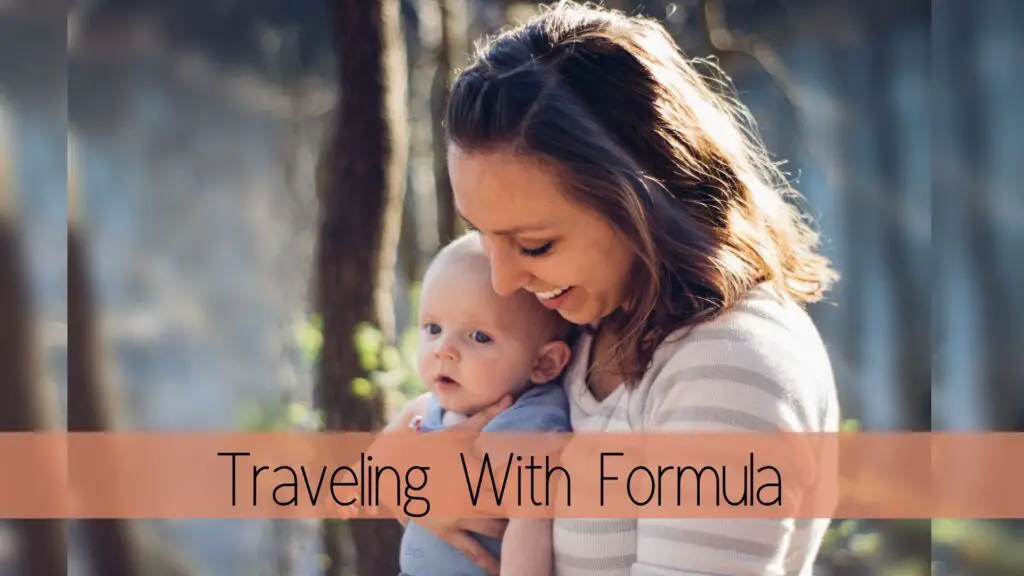
How to Pack Formula
So when you are packing the car, be sure you have enough formula for the trip within arm’s reach.
I have found a basket under the seat to be very convenient for diapers, bibs, blankets and feeding supplies.
Measure your day’s formula and pack it with the water, bottles, warmer and bag for dirty bottles in a basket that you can reach easily.
There are a few ways you may want to pack the actual formula.
Pre measure
Premeasure enough formula for the day into a travel container. This is probably how you prep for any outing with your little one, so you probably already have everything you need for this.
This will make it faster to get the bottles ready, if you use warm water, warm it in a travel warmer before mixing the formula.
Use Premixed
If at all possible, use premixed so that you don’t have to worry about water. If you are traveling with a cooler, you can store any opened bottles in there between feeding.
If the formula you use is not available as a liquid, do not try a new formula while you are away from home. It could result in allergy, gas or constipation. Not worth it.
Buy smaller bottles so that you will not have to store the opened containers for very long. They are generally available in 4oz, 8oz and quart size bottles.
If your baby prefers warmed bottles use a travel bottle warmer.
The unopened bottles do not need to be refrigerated and can be stored at room temperature.
If you cannot get mixed, be sure to do the math on how much water you will need. My family goes through so much water when we are traveling! We are not used to having to carry all our water with us and it shows.
You can usually buy water if you run out, but try to keep a special stash of bottle water and replenish it for the trip home.
How Much Formula To Pack
The best way to know how much formula you will need is to keep a record at home. Use an app or a simple notebook to track how much formula your baby is eating each day.
This can give you a good idea of how much formula you will need to pack.
You can also use this chart to give you a good estimate.
Chart adapted from What To Expect
Use this chart as a guide, but be sure to talk to your pediatrician about how much your baby is eating as they know YOUR baby and their specific needs.
It is possible that your baby will eat less on the road trip. All my kids have eaten less, and slept more on long trips.
If your baby starts eating less just be sure to monitor your baby for signs of dehydration and try to stick to a normal feeding routine as much as possible.
How to Clean Bottles on the Road
The biggest challenge when traveling with bottles is getting them clean.
I have a few ideas to get around this problem and a system for using what you have.
Create Fewer Dishes
One way to deal with dishes is to eliminate as many as possible. There are a few ways you can do this while traveling.
Be sure to use formula safety guidelines from the American Academy of Pediatrics and don’t mix it too far ahead and don’t water it down.
The first time I traveled with bottles I had been given a Kiinde system . My baby did not like the nipple on the original system, but now there is a very affordable bottle kit that allows any nipple type to be used.
A Kiinde system allows you to pour milk or formula into the pouch, screw the pouch or bag into the bottle and discard the pouch when the feeding is done.
With this system you would only have nipples to wash.
Drop In System
Playtex has the drop in bottle inserts that accomplish the same thing. These disposable drop in bottle liners allow you to put the formula into the bag and discard it when the feeding is done.
Again, with this system you would only have nipples to clean.
Pre-Mixed Formula
The easiest way to use formula on the go is to use pre pre-mixed formula. These are shelf stable, do not need to be refrigerated until open and do not require you to find water.
Pre-mixed formula can be purchased in quarts or smaller 4 or 8 ounce bottles.
Use pre-mixed formula with the Kiinde system or Playtex Drop ins and you will have a very simple formula solution.
The smaller bottles may allow you to screw the nipple directly to the bottle. Very convenient when traveling.
So you will just be washing nipples.
Washing Bottles on a Long Trip
You will need to wash the feeding supplies at least once a day . You can wash them whenever you have a sink available, if you need to sterilize bottles get a microwave sterilization kit to use at a hotel.
After feeding your baby put the dirty bottles and nipples in a bag or container to store for washing. I like to use a large ziploc and put the dirty stuff in the cooler to keep it from growing mold.
Whenever you have a sink available, wash the bottles with warm soapy water and air dry them on a clean surface.
If you would like to you can use microwave sanitizing bags as an extra step to ensure very clean bottles.
It may be uncomfortable to wash bottles in small sinks, and you can avoid this by using a pouch or liner system, then you will only have to wash nipples and rings.
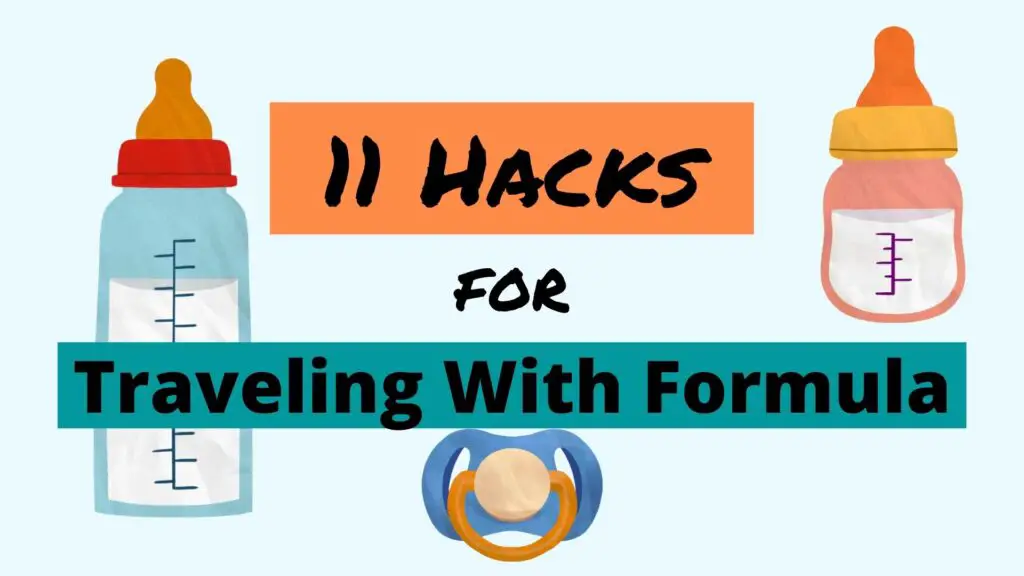
Flying with Formula
We travel by car most of the time, but flying with a formula is very similar.
The biggest difference between driving and flying with formula is your packing space. When you fly you will need to pack a bit smarter.
Formula is considered a medical necessity and TSA should be no problem getting through security with your formula.
In your baby bag you should carry enough bottles for the whole travel day. Pack a large ziploc to keep any dirty items until you arrive. Pack a small amount of soap as well so you can wash things if the need arrises.
Solid dish soap bars can be easier to carry when you are flying.
Pack a microwave sterilizer bag and book hotels that provide a microwave and minifridge.
If your little one is used to warmed bottles, consider how you plan to warm bottles en route or give room temperature bottles a try.
There are some great rechargeable bottle warmers that can easily be used while traveling.
You could try to simplify by offering room temperature bottles and see how your baby reacts.
If you find you must warm bottles you may be able to ask for hot water and warm bottles on your flight by placing them in a cup of hot water.
There are also portable water warmers (affiliate link) available that are a bit more versatile than bottle warmers. I find this a really helpful gadget as you can use it to heat water for instant coffee, mixing formula or making ramen in the car.
Be sure to pack enough formula to feed your baby for the whole trip and have a plan for washing your bottles and nipples. Pack dish soap and a bottle brush or choose a disposable bottle liner kit. A microwave sterilization bag is a great way to keep everything very clean for young babies.
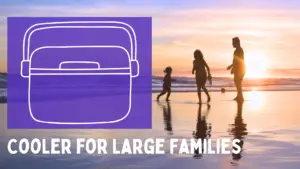
- What Is a Good Budget For A Family Road Trip?
- Can you Drive Over Hoover Dam? Cost, times and details
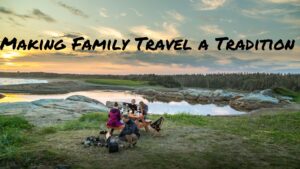
Previous Post
The 2 Hour Car Seat Rule: When Does It End?
11 trips to make your road trip more affordable.
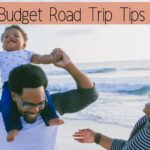

Related Posts
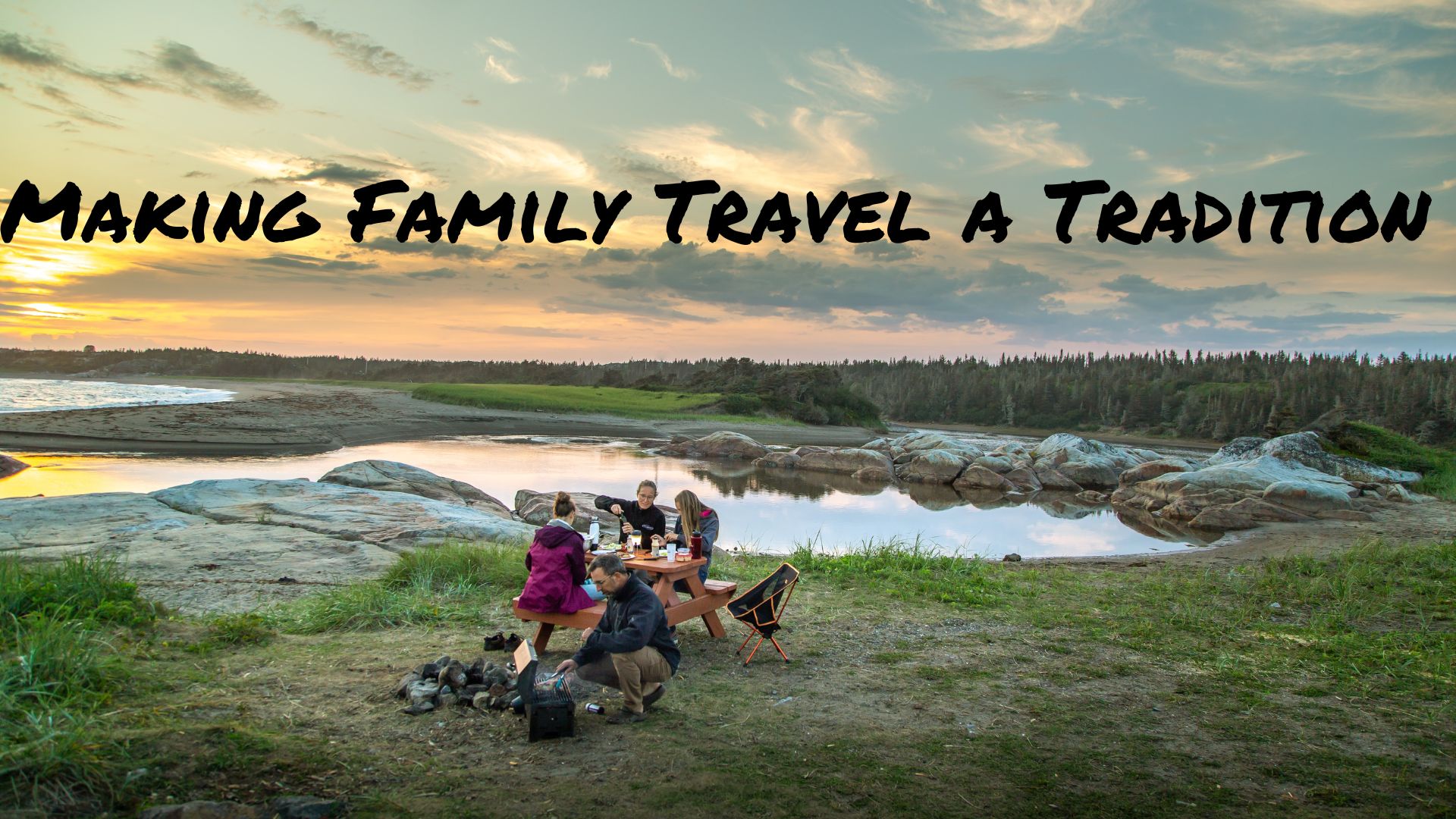
Making Travel a Family Tradition: How to get the time and money.
So, we all have dreams. When we are in a family the dreams can be difficult to manage. It feels like you have to pick one, your dream life or your family. I want to encourage you that you can still travel as a family and you should. You want to give your children those…
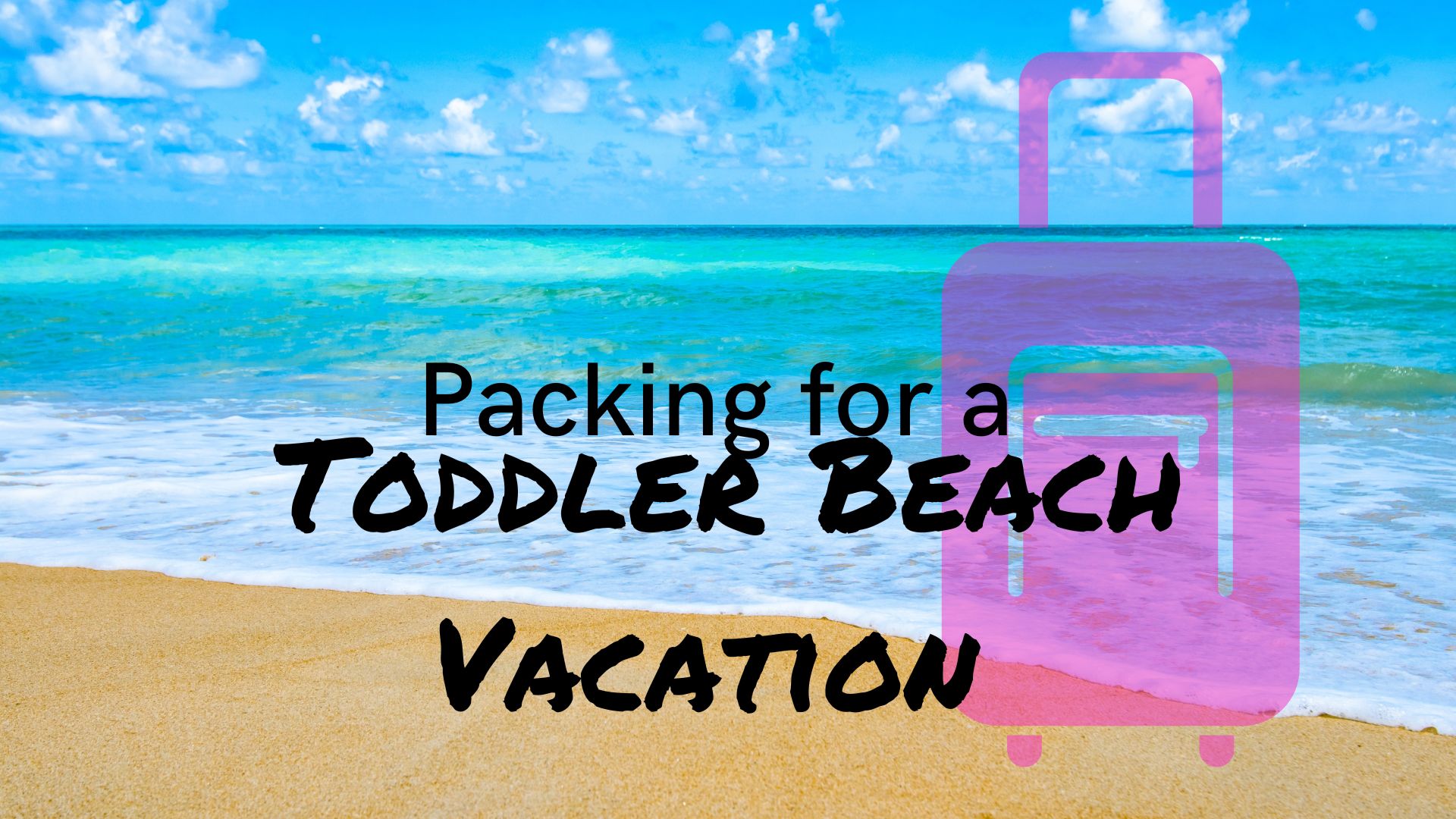
The Ultimate Packing List for a Toddler Beach Vacation
Family beach vacations are a great choice for family vacation, and packing the right things can make the trip smooth with your toddler. We take a lot of road trips with our family of 6, and we often take spontaneous trips. The way to pack for these trips quickly is to pack in categories! Packing…
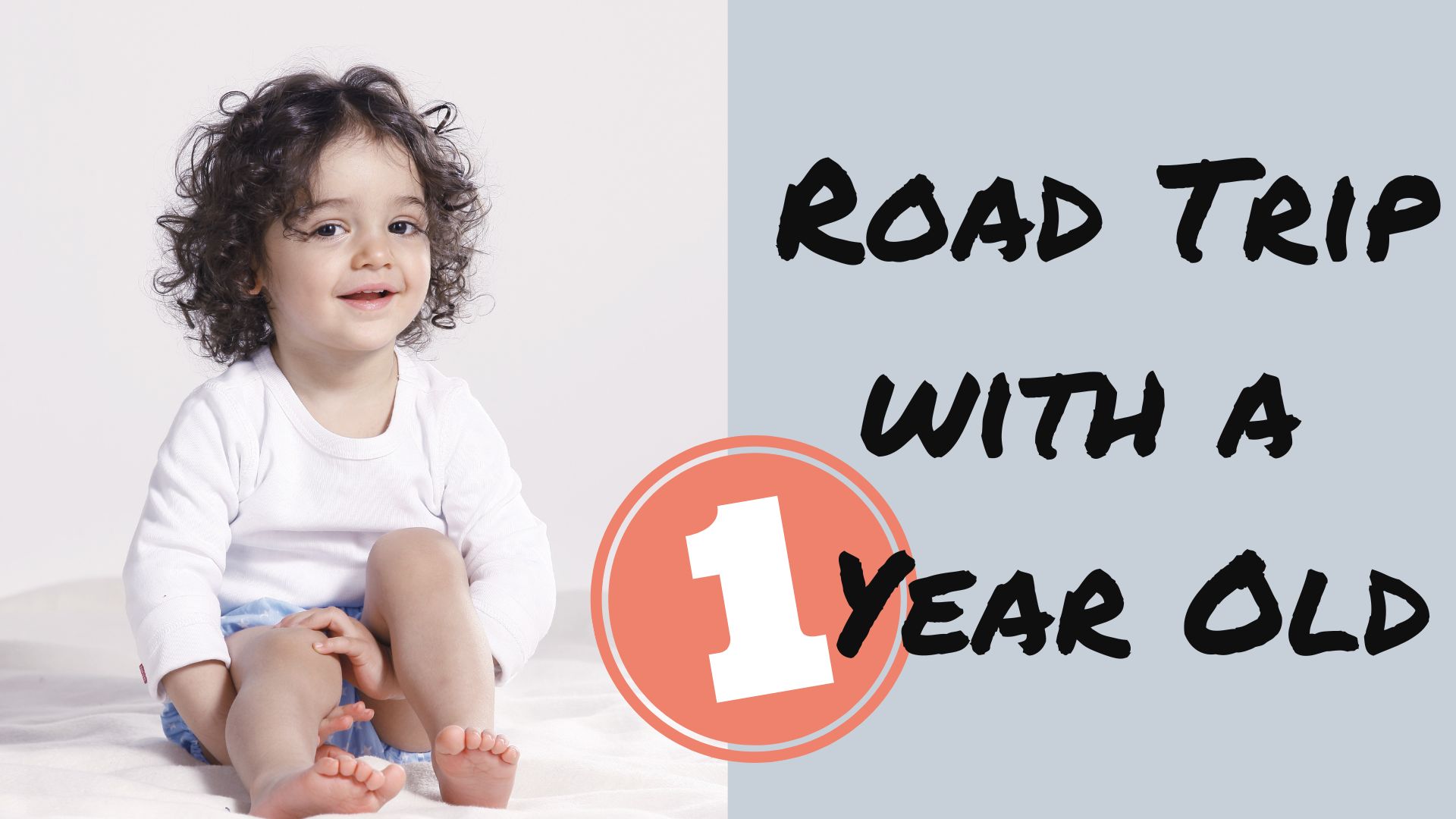
Road Trip With a 1 Year Old: A Handy Guide
Traveling in the car is a great way to vacation with a one year old! It can be tricky, but I got all the tips and tricks you need! Plan to Stop every 2 hours, pack a variety of snacks and travel during nap times to make the trip go as smoothly as possible. Plan…

- #1 brand recommended by pediatricians
- Ask a Nurse
- Join Enfamil Family Beginnings® For up to $400 in free gifts and special offers

5 Tips for Traveling with Baby Formula
From scheduling to prep options, here are five tips for traveling with formula to help make your life easier when out and about with your baby.

With a little planning, traveling with baby formula can be a breeze. Here are five tips:
1. Think about when your baby normally eats
You can often buy yourself a couple of hours to run errands if you plan your day around your baby’s usual feeding schedule. Try to schedule tasks for just after you’ve fed your little one. That way, you can enjoy some time before they’re hungry again.
2. Note the number of feedings to prepare
Going out for a long time? Count the number of feedings you need when traveling with formula and baby. Consider adding an additional bottle just in case. Anything’s possible! If your cooler bag doesn’t maintain a temperature of 35 to 40 degrees, use the bottles within two hours or throw out the formula.
3. Measure formula before you go
Getting out of the house can be tough enough. Why make things harder once you’re out? Preparing bottles before you leave can help make the whole trip easier. Prepared formula can be at room temperature for up to two hours—or one hour if it’s already been warmed or prepared with warm water.
4. Consider ready to use formula
As another option, there’s Ready to Use formula. You don’t need to mix or refrigerate, which is super convenient. They’re also a great option if you’re not sure you’ll be able to find clean water once you’re out. Learn more about Ready to Use formula options here .
5. Be ready for spills!
Let’s face it—accidents happen. Help keep your belongings from contact with spills with a waterproof baby bag. It doesn’t hurt to keep a few extra paper towels or wet wipes on hand too, just in case.
These five tips, can help you feel ahead of the game no matter what happens when you’re traveling with formula. And sometimes, that’s enough to make life a whole lot easier when you’re out on the town with your little one.
Share this article
You may also like
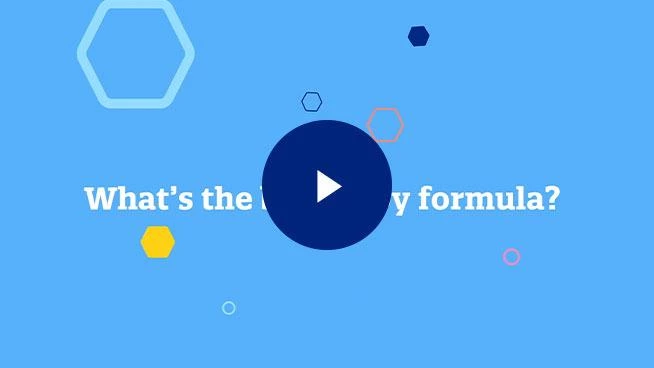
Choosing to Formula-Feed
Many moms choose formula-feeding. Learn more about choosing to...

Returning to Work After Pregnancy
How to set yourself up for success when you transition back to work...
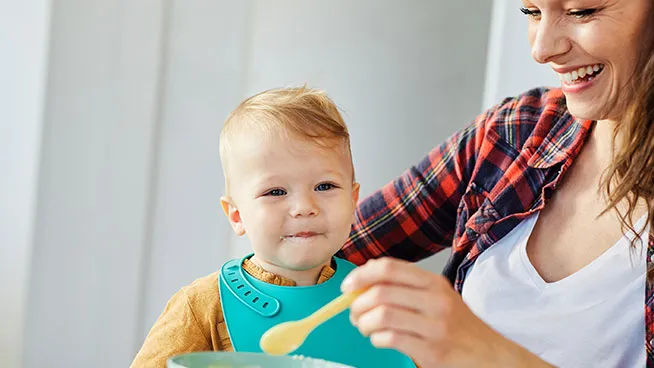
Baby Feeding Timeline and Guidelines
This article aims to provide you with a clear roadmap, outlining when...
All information on Enfamil , including but not limited to information about health, medical conditions, and nutrition, is intended for your general knowledge and is not a substitute for a healthcare professional's medical identification, advice, or management for specific medical conditions. You should seek medical care and consult your doctor or pediatrician for any specific health or nutrition issues. Never disregard professional medical advice or delay seeking medical treatment, care, or help because of information you have read on Enfamil .

Journey with Ease: A Comprehensive Guide to Storing Baby Formula While Travelling
Aug 17, 2023
Share this article
Traveling with an infant can be a joy-filled experience, filled with new sights and sounds for both parent and child. Yet, it also presents unique challenges, none more significant than ensuring your baby’s nutrition is handled with the utmost care and precision. For those relying on baby formula, the need for secure, convenient, and hygienic storage becomes paramount. The days of cumbersome packing and the stress of maintaining the perfect temperature are a thing of the past.
This guide is designed to illuminate the best practices for storing powdered formula, whether you’re navigating the bustling terminals of an international airport or exploring a remote countryside. Understanding the importance of maintaining the quality of the powdered formula and the specific needs of your little one can make all the difference in enjoying a relaxed and pleasurable travel experience.
In the pages that follow, we will explore everything from choosing the right containers to considering temperature, mixing on-the-go, handling unexpected situations, and even international travel considerations. So buckle up and prepare to embark on a stress-free journey with your infant, equipped with the knowledge to make baby formula storage a breeze.
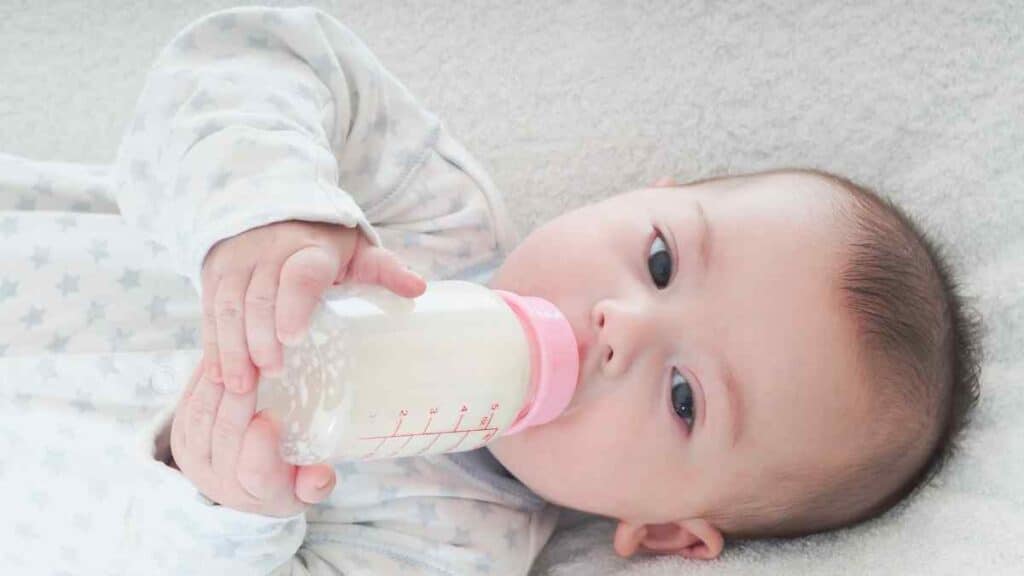
Understanding Baby Formula
Navigating the world of infant nutrition can seem overwhelming, especially when it comes to choosing the right baby formula for your child. This column will provide a brief overview of what baby formula is, discuss the different types, and emphasize the importance of maintaining quality. Understanding these aspects can help ensure your baby’s nutritional needs are met, especially when travelling.
What is Baby Formula?
Baby formula is a manufactured food designed to be a substantial equivalent to breast milk for babies who are not breastfed. It is specially formulated to support the baby’s immune system and growth and contains essential vitamins and minerals. When it comes to water for mixing formula, questions often arise such as “can babies drink purified water?” or “what is the difference between distilled vs purified water for a baby?” We will address these important concerns in this column.
Types of Baby Formula
1. powdered formula.
- Formula Powder : Easily mixed with warm water, convenient for travel, and often used by many parents. It’s vital to use the right water, with common choices being distilled water for babies or purified water for babies.
- Powder Formula Dispensers : Handy tools for pre-measuring formula for travel.
- Travel Tips : Using bottled water or a formula dispenser can make the process seamless when traveling with baby formula.
2. Concentrated Liquid Formula
- Mixing with Water : Requires mixing with equal parts water. A bottle warmer can help to prepare bottles ahead of time.
- Water Choices : Distilled or purified water for baby is generally preferred. Knowing the difference between nursery water vs distilled, or understanding if baby water is distilled or purified, can assist in making the right choice.
3. Ready-to-Feed Formula
- Convenience : Requires no mixing and is the simplest option, especially for a formula-fed baby.
- Travel Considerations : Ready to feed formula is great for carry-on bags and can be used with formula bottles without worrying about finding appropriate water for mixing.
Importance of Maintaining Quality
- Water for Baby Formula : Whether to use distilled vs purified water, or whether fluoride-free water is the best option, depends on various factors like the baby’s age and specific nutritional needs. Is purified water the same as distilled water? Not quite. Distilled water has had all minerals removed, whereas purified water has had impurities removed but might still contain some minerals.
- Storing Prepared Formula : The best way to store baby formula when travelling includes using proper formula containers, bottle liners, and keeping the formula cold with ice packs or a cooler bag.
- Feeding : Warming baby milk to the desired temperature, using clean bottles, and adhering to hygienic practices ensures that the baby’s bottle is safe and satisfying. A travel bottle warmer may be a handy investment for on-the-go feeding.

Pre-travel Preparation
Traveling with a baby requires meticulous planning, and ensuring that the baby’s feeding needs are met tops the list of priorities. When it comes to feeding your little one on the go, understanding the best practices for preparation and storage can make the journey smooth and stress-free. This column will offer insights into purchasing the right type of formula, deciding the quantity to carry, and ensuring the baby’s dietary needs, all essential steps in pre-travel preparation.
Purchasing the Right Type of Formula for Travel
- Understanding Baby’s Needs : Consider your baby’s age, dietary needs, and preferences when choosing the formula type. This includes whether to opt for powdered infant formula, ready-made formula, or other types.
- Water Considerations : Understand the differences between purified vs distilled water, or distilled vs purified water for baby, and choose the best water for baby formula accordingly. If you wonder, “is purified water the same as distilled water?” know that they differ in mineral content, and the choice may depend on baby’s specific requirements.
- Travel-Friendly Options : Consider formula dispensers, zip-lock bags, or travel bottle systems that allow you to pack formula in powder form, making bottle feeding more convenient on the go.
Deciding the Amount to Carry Based on Travel Duration
- Calculate Baby’s Needs : Estimate how many feedings you’ll need based on the baby’s feed schedule and duration of travel.
- Include Extras : Always carry a few extra servings for unexpected delays. This includes all the formula, bottles, and even a little extra purified or distilled water for babies.
- Carry-On Considerations : If traveling by plane, be familiar with airport security regulations, and pack reasonable quantities of formula in your carry-on bag, keeping in mind that it might be screened separately.
Ensuring Baby’s Dietary Needs
- Know Your Baby’s Formula : Stick with the brand and type your baby is accustomed to, and avoid experimenting during travel. If the baby has any allergies, make sure to pack specialized infant formula.
- Water Quality : Distilled or purified water for baby formula ensures quality. Consider baby water without fluoride, and understand the difference between nursery water vs distilled for specific requirements.
- Hygiene and Convenience : Include items like a bottle brush, sterilized bottles, wet wipes, and hot water facilities to warm baby milk. Many parents find a shoulder bag with compartments to be handy to organize all the essentials, including frozen gel packs to keep formula cold.
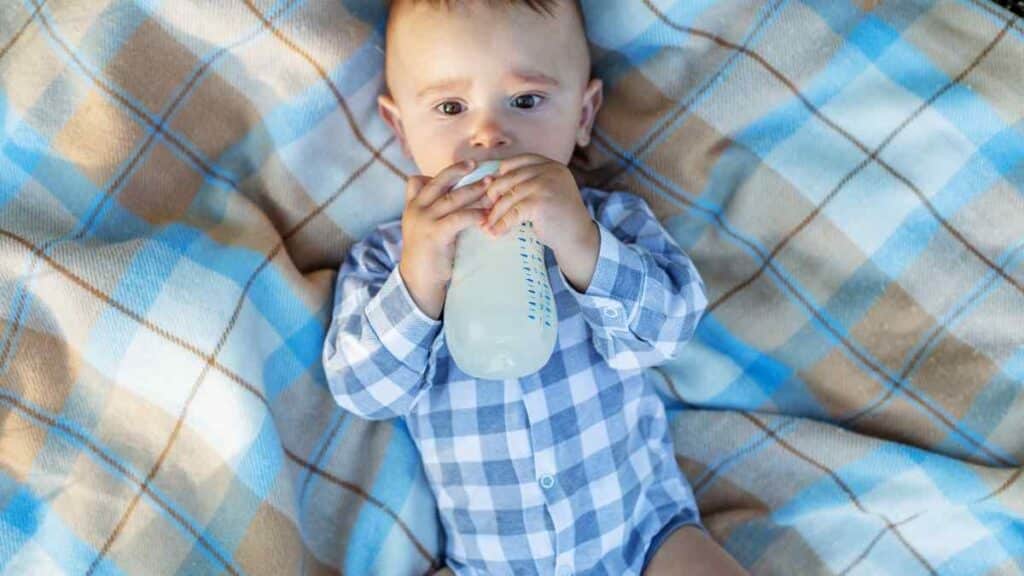
Choosing Appropriate Containers
When it comes to traveling with your baby, especially if your journey involves flights, selecting the right containers for storing baby formula is essential. The wrong choice could lead to leakage, spoilage, or even a run-in with airport security. Whether you are bottle feeding or planning to warm formula during your travels, knowing what to look for in containers can save time, prevent stress, and ensure that your baby’s nutritional needs are well taken care of. This column will explore how to select leak-proof, BPA-free containers, portioning considerations, and regulations for liquid carriage on airplanes.
Selection of Leak-Proof, BPA-Free Containers
1. Look for Quality : Choose baby bottles and formula bottles that are leak-proof to prevent spillage. Many bottles designed specifically for travel come with sealing disks or lids that prevent leaks.
2. Material Matters : Opt for BPA-free containers, which are safer for baby’s health. BPA-free bottles don’t contain the harmful chemicals found in some plastics.
3. Temperature Considerations : If you plan to warm formula, make sure the containers can withstand hot water or a bottle warmer without damage.
4. Convenience : Consider a bottle system with interchangeable parts or ones that can directly attach to the formula powder dispenser.
Portioning: Single-Serving Containers vs. Bulk
1. Single-Serving Containers : Pre-measured formula in single-serving containers can be a time-saver. It ensures you have the exact amount needed for each feeding, eliminating the guesswork.
2. Bulk Options : If traveling for an extended period or with a bottle-fed baby, you may want to carry formula powder in bulk. Make sure to have a reliable way to measure out each serving, like a scoop or pre-measured compartments.
3. Breast Milk Storage : For parents carrying breast milk, specific containers are designed to keep milk fresh and at the right temperature.
4. Formula Feeding Parent’s Choice : The choice between single-serving and bulk may depend on personal preferences, the baby’s feeding schedule, and the duration of travel.
Regulations Regarding Liquid Carriage on Airplanes
1. Understand Security Rules : Airports have specific regulations regarding the carriage of liquids. Be familiar with these rules and how they apply to baby food, bottled water, formula feeding, etc.
2. Declare Baby Essentials : Inform airport security about baby bottles, formula, and related items. They may be screened separately.
3. Bring Ice Packs : If you need to keep formula or breast milk cold, consider bringing ice packs. Check with airport security about how to pack these properly.
4. Sterilized Bottles : Carry sterilised bottles and be prepared to explain your needs if questioned by security.
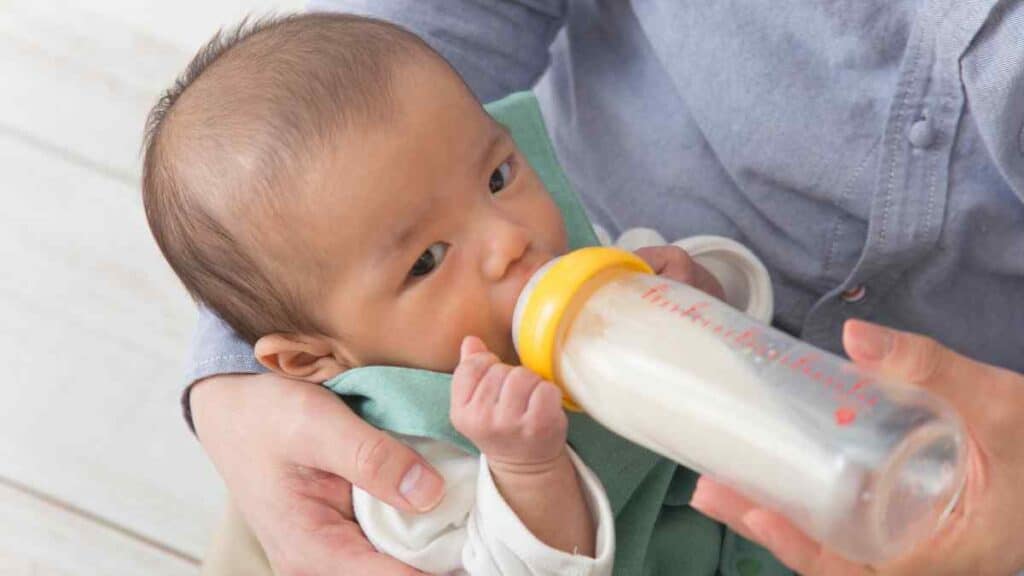
Emergency Solutions
Traveling with an infant requires careful planning, especially when it comes to feeding. However, even the best-laid plans can encounter unexpected delays or shortages that could lead to an urgent need for baby formula. Whether it’s a delayed flight or realizing you’ve run out of your baby’s preferred formula, knowing how to handle these emergencies can be a lifesaver. This column will cover essential tips for unexpected infant formula bottle delays or shortages and share insights on knowing local stores or brands, ensuring that your baby stays happy and well-fed even in unforeseen circumstances.
Tips for Unexpected Infant Formula Bottle Delays or Shortages
- Always Pack Extras : Carry extra formula bottles and pre-measured infant formula servings. Even a few additional servings can make a difference during unexpected delays.
- Utilize Available Resources : In a pinch, tap water can be used if bottled or boiling water is unavailable. However, always make sure it’s safe and clean, or opt for bottled water when in doubt.
- DIY Warming Techniques : If a bottle warmer is unavailable, you can warm bottles by placing them in hot water. Alternatively, holding a bottle under running warm water for a few minutes can bring it to the right temperature.
- Adapt with Available Items : In the absence of sterilized bottles, clean the best you can with hot water and soap. Also, a diaper bag can double as a cooler by adding a few ice packs or cold water bottles to keep formula cold.
- Create Makeshift Burp Cloths : If you run out of burp cloths, improvise with soft, clean fabrics like a towel or extra clothing.
Knowledge of Local Stores or Brands
- Research Ahead : Before traveling, especially internationally, research local stores that carry baby products, including infant formula. Knowing what’s available nearby can be crucial in emergencies.
- Understand Local Brands : Familiarize yourself with local formula brands and their ingredients. If your preferred brand isn’t available, knowing alternatives that suit your baby’s dietary needs is essential.
- Use Technology : Utilize maps or apps to find nearby stores that sell baby essentials. Most smartphones can guide you to the closest store with baby drinks, formula bottles, and other necessities.
- Ask for Help : Don’t hesitate to ask locals or hotel staff for directions to stores that carry baby products. They can often provide handy tips and insights into trusted local brands.
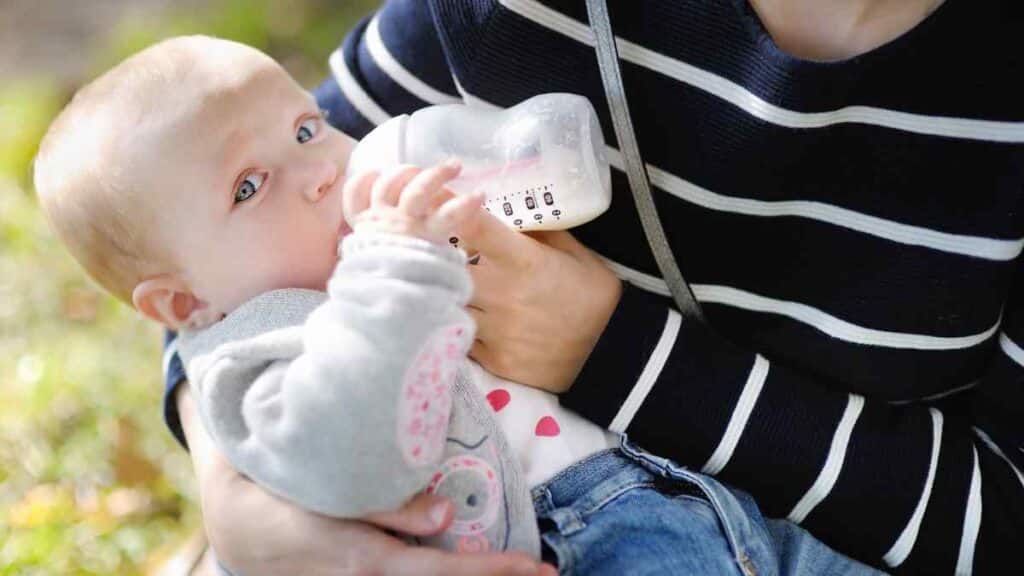
Traveling with a baby presents a unique set of challenges, but with careful planning and strategic preparation, it can be an enjoyable and memorable experience for the entire family. “Journey with Ease: A Comprehensive Guide to Storing Baby Formula While Travelling” has aimed to provide you with the essential knowledge, practical insights, and actionable tips you need to keep your baby fed and content during your travels.
As you embark on your next adventure with your little one, remember that being well-equipped and informed is half the battle won. Keep this guide handy, embrace the handy tips and strategies discussed, and you’ll find yourself navigating the world of traveling with baby formula like a seasoned pro.
May your travels be filled with joy, exploration, and the confidence that your baby’s nourishment is well taken care of. Happy journeying!
Did this article help you? Please leave a comment below. If you have any questions, please don’t hesitate to ask.
Read more articles
May 30, 2024

Dangers of Dehydration in Infants and How to Prevent It
One critical health concern that must be recognized early in infants is the dangers of dehydration. Dehydration refers...
May 2, 2024
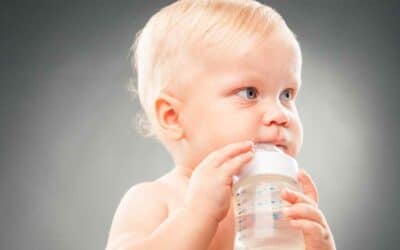
Fun Ways to Encourage Your Child to Drink More Water
Teaching your child to like water is something incredibly challenging. After all, who would want to drink a...
Apr 30, 2024
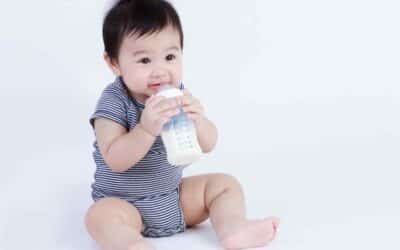
The Role of Hydration in Child Development: An In-Depth Guide
Dehydration is a health condition resulting from excessive loss of liquid in a person's body. The most common causes...

Tips & Tricks for International Travel with an Infant
- September 2, 2023
- Family Travel , Travel Tips + Planning , Travel with Baby
- Comments Off on Tips & Tricks for International Travel with an Infant
As Kaia passes the 7-month mark, she’s visited 10 countries, been on 15 flights (including 4 transatlantic), and stayed in nearly 20 hotels across the globe. She’s adjusted to time changes and had formula from a market purchased in the mountains of Oman. There’s no doubt that traveling with infants is different and requires flexibility, resourcefulness and a bit more pre-planning… not to mention more checked bags than you’re used to. Below, I’m sharing insight on international travel with an infant. I’m focusing largely on air travel with an infant, plus things to keep in mind, but also a few notes for prep for arriving and staying in a new country.
I should also note – in the vein of transparency – that international travel with an infant is not easy and does take a bit to adapt to. Many Instagram accounts paint a picture of glamorous travel with baby, easy moments sharing new cities with a little one, and tiny tots noshing on international cuisine like pros. That’s only part of the picture. Babies, like adults, have to adjust to time changes (more on that below) so that may mean a few difficult nights during the adjustment period. There are new realities to adapt to with dining time, some adults-only places you’ll have to tearfully pass on, and knowing baby’s needs (obviously) come before yours. There are lots of beautiful moments and memories to be made, but also the new realities of how travel has changed with a little one in tow. If you find the first few trips a bit difficult, just know you’re not alone! It gets easier with time as baby gets a bit older and as you get more used to your new travel companion.
In the Air with an Infant
First and foremost, I’m sharing details about air travel with an infant as this is probably where I get the most questions from first-time jet setters heading out with the baby. I get it and believe me, I get a bit of anxiety every time we’re heading to the airport with Kaia, but every trip does get easier as you find your new rhythm. One thing to just keep in mind when planning is that it’s not just the flight to keep in mind — this isn’t to scare anyone, but just to remind and inform! For us, a 3-hour flight to London from Rome, for example, isn’t just a 3-hour flight to Rome. It’s a two-hour drive to the airport, 2+ hours at the airport, and then a 3-hour flight pending no delays (more on that below). The 3-hour flight ultimately ends up being a 7 – 8 hour journey, not counting landing, clearing immigration, etc. All that to say, when you’re mentally planning your day and air travel with your infant, you’ll want to keep the bigger picture in mind and pack accordingly. More details, tips and tricks below!
Booking Your Infant Seat – What’s Included
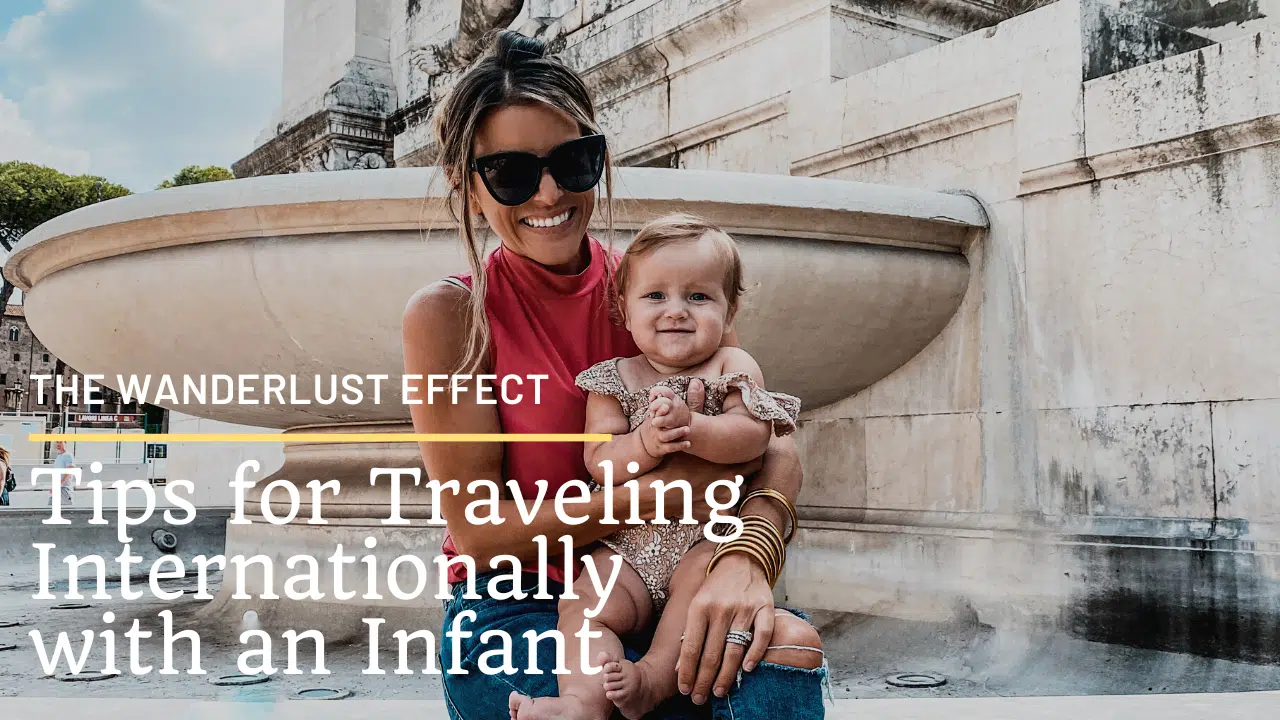
First and foremost, let’s talk about booking your infant’s seat. If you’re traveling internationally with an infant, you need a passport. That seems like a given, but I’ve seen the question asked. Your baby is a person with their own identity and you’ll want to be sure you have their passport prior to travel. There’s a lot of talk about lap infants traveling for ‘free’. To be accurate, infants don’t travel for free as they do have to pay for taxes and sometimes there’s a small infant fare. On international trips where we’ve flown Business Class (on points), we’ve had to pony up upwards of $300 – $400 for her despite the fact that she doesn’t have her own seat. Some smaller, budget carriers charge a fee for an infant (sometimes €25 or so on budget European carriers). A follow-up note to that: sometimes airlines don’t have an infant option when you’re booking. Or perhaps you’re booking airfare for the future and your baby is still in utero at the moment. The best approach is to call and add the infant to your booking. They’ll assign the infant to the mother usually and this will appear on your booking. The infant receives their own ticket but will show as INF vs. showing a seat number.
All of that said, your infant is expected to sit on your lap and share a seat with you which means this approach does not guarantee that you’ll have a seat for your baby in any way. If luck is on your side and an adjacent seat is available then yay! You can ask the agent upon check-in or the attendants when boarding but it’s really a gamble. If you want your child to have a seat, you’ll have to book them a child’s fare. Now, your infant fare includes a carry-on for your child and gives you the ability to bring formula (more on this below); liquids that typically wouldn’t be allowed for a normal flyer. I’m sharing more insight on this below in terms of packing and prepping as this was one of my main concerns!
The Bassinet — The Inside Scoop
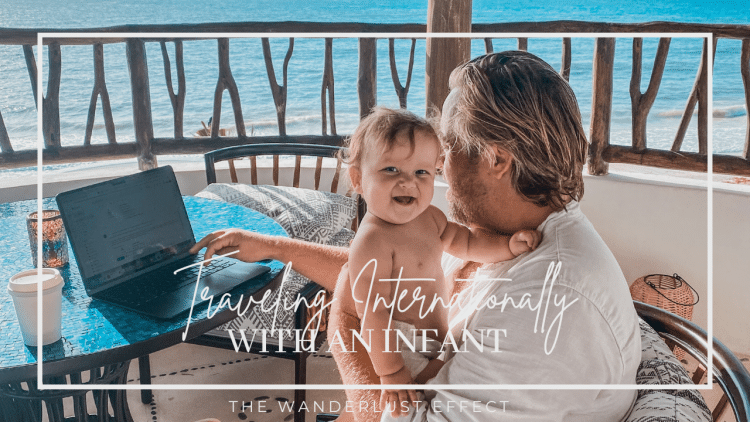
You’ve heard of the elusive bassinet. It’s like a unicorn add-on that every new mom is in awe of. These exist?! How did we never notice them before becoming pregnant or having a child?! It makes sense! We never needed them before and truth be told, they’re not available on every flight. Not to mention the fact that each bassinet is different. Here’s the inside scoop: bassinets are free and they’re first come, first served. Generally speaking, the agents I speak to over the phone when booking air cannot guarantee them. If a flight has a bassinet, it’s set up at a bulkhead seat and you have to let your flight attendant know to allow it to be set up prior to take off. When you’re looking at a plane configuration online, you may notice a small drawing of an infant (in your previous pre-parent life you may have not noticed this or thought it was a bathroom symbol). These seats are designated bassinet seats. Again, not all flights have them and not all classes of service have them. I’ve been on flights where economy had bassinets but Business Class didn’t. Each bassinet is different but they’re generally very useful and allow you to be hands-free for a bit when your baby sleeps. On our earlier flights, when Kaia was 6 – 14 weeks old or so, we found these helpful as she slept frequently and was comfortable in the bassinet. Piece of advice: bring their favorite/go-to blanket from home! It gives them some comfort and allows them to cozy up faster.
Take Comfort – There’s White Noise on the Plane
It’s your first time traveling internationally with baby and you’re concerned about the long flight… I’m going to remind you of one fantastic truth: there is so much white noise on planes. You know the white noise machines moms swear by for helping baby fall asleep at night? The plane is basically a big white noise machine so babies are lulled easily by that! Add to that the fact that there’s a lot of ambient noise on a plane (more than you ever realized before) so if baby is whining, fussing or crying a bit, the likelihood is that you notice it far more than anyone around you.
Take Off and Landing

One of the big conversations with babies is around take-off and landing. Every parent traveling by air with a baby for the first time is aware of this and fearful of it. The common sentiment/approach is to allow the baby to nurse or to provide them a pacifier upon take-off and landing to help with their ears and any pressure. If they’re sleeping, let them sleep. I wouldn’t advise waking a sleeping baby to have them nurse or provide them a pacifier. Another added comfort: I had a very difficult time nursing due to some issues during my birth experience and Kaia never took to a pacifier. She’s now been on 15 flights including 6 – 8 that were 7+ hours. We have never had an issue with her ears. Even if she isn’t having a bottle, nursing, etc. she’s never shown signs of pain or fussiness. I share that to just note that not all babies have issues. There’s a constant fear that your baby will be in pain, screaming for the flight due to pressure, but that’s not necessarily true. Of course if you can preempt the issue by nursing or providing a pacifier then go for it!
Prepping Your In-Flight Baby Bag
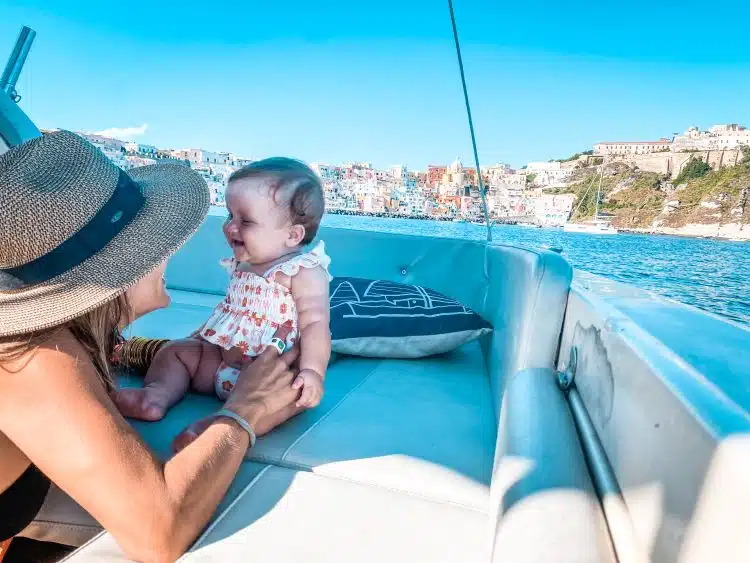
If you’ve followed my adventures in the past, you know that we’re generally light packers. We travel for a month in a carry-on and think nothing of it.
That’s past tense now (insert crying face).
Babies take a shocking amount of stuff — and it’s very difficult to pare down when they’re very young depending on your personal situation. You will have the ability to bring a carry-on on board for your infant. Pack wisely and thoughtfully. Big things to consider:
- Formula . If you’re like us and need to use formula or choose to use formula, bring enough (more details below).
- Diapers, Wipes and Changing Pad. Bring plenty of diapers – plenty! – just in case. I brought a dozen on our first transatlantic flight from London to Miami and a friend scolded me about being ill-prepared. He had been in a similar situation and dealt with flight delays, a baby with a bad tummy and a whole host of issues and a dozen was barely enough to make it out unscathed. Generally speaking, I think a dozen is fine. Do what’s best or you but be generous. Also bring a changing mat (we bring disposable ones AND a padded one), along with wipes. I prepare what I call a ‘nappy changing kit’ before travel. I take the changing pad (the non-disposable, nicer, cushioned pad), insert a disposable changing pad, put in two diapers, and a package of wipes and then fold it up so it’s ready to go. When I need to use the lavatory to change her, I pull the changing table down, the pack is ready to go and I unfold. I bring the second diaper to use as a pad for her head just in case!
- Backup Outfits. Always bring backup outfits for obvious reasons. If you don’t, Murphy’s Law dictates that you’ll deal with the world’s worst blowout and have no way to recover. Also, bring a backup outfit for yourself!
- Toys and Entertainment: Bring toys your baby loves to entertain them. For us, that’s Sophie (the ever-present giraffe), our Sea Tails crinkle book, a few rattles, a flexible mirror, and a couple of other toys just to mix it up in case.
- A go-to blanket: As i mentioned above, whether your baby is sleeping on you or in a bassinet, a blanket that their go-to is a piece of home and gives them some comfort in new settings.
- Any medications, specifics for baby: Whether it’s Tylenol or something your baby needs more critically, obviously be sure to pack meds for baby in the carry-on.
Formula Packing and Options
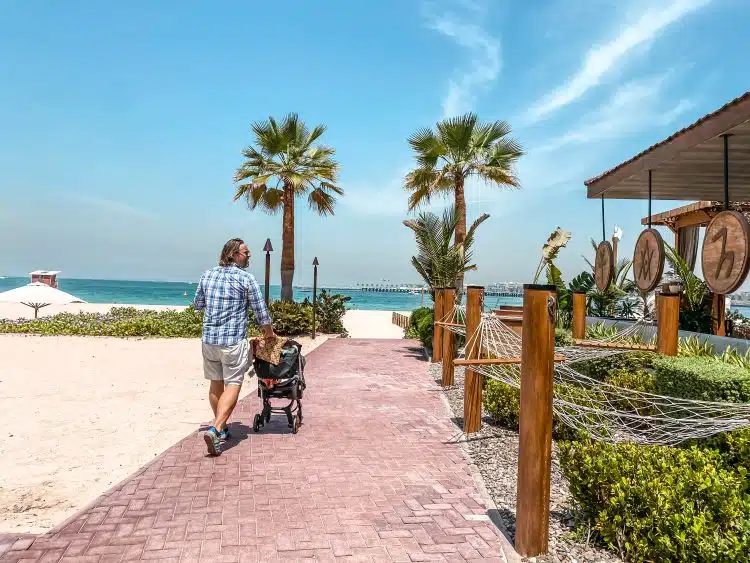
This was my biggest worry! How would I bring formula on board and what was my best approach for traveling with a formula-fed baby internationally? People have different takes on this, but this is what works for us: I have 5 – 6 bottles that we travel with. Generally speaking, at 7 months old, our baby eats about 150ml/5 oz. 5 times per day. I usually have 3 bottles filled, one with a ready-to-eat portion, then 1 – 2 empty. We have trained Kaia from her early early days to not expect warm formula. My mom gawked at this like it was some form of child abuse, but honestly — babies don’t need formula to be warm, and if they accept it lukewarm or even slightly chilled – gasp! – your life will be easier for it. The filled bottles that we carry with us go in a cooler bag with ice (you can take the ice through security since you have an infant) which keeps them safe for consumption. I usually take a bottle out (it’ll be freezing when you remove it) and allow it to warm with my body heat or request hot water from a flight attendant (or get hot water in the airport lounge depending on where we’re at). Kaia doesn’t require formula heated to a particular temperature so as long as it’s not absolutely freezing, she’s happy enough to have it. Also, in the spirit of being prepared for any circumstance, the worst-case scenario is running out of food for your baby. If you’re a mom that is not nursing, this means you rely on formula. In addition to our prepared formula, we bring two 500mL ready-to-drink formulas that are shelf-stable. We’ve opened them before on planes when needed. They do need to be kept cold after opening so your cooler bag will come in handy again. Note that flight crew often cannot put your items in their fridge per FAA regs but they CAN provide ice, which they’ve kindly done for us in the past. In addition, I bring powder formula in my carry-on just in case we get stuck somewhere and I need to prepare more. That’s a super safety precaution but always makes us feel safer in case things change unexpectedly.
With younger babies, the biggest concern is sanitizing bottles so bring extra, pre-sanitized bottles with you so you’re ready to go. We have travel-friendly microwavable sanitizer bags but these aren’t useful on the plane. If you’re in a major bind at some point, boiling water run through bottles usually is fine as bottles don’t need to be sanitized after every use though they do need to be cleaned properly shortly after use. I also bring a bottle brush when I can remember!
Is Business Class Appropriate?

We searched for answers to this ourselves before flying Business Class with her on a series of international flights. Is it appropriate to book Business Class with a baby? There are so many threads and so many personal anecdotes here, but let me just say that if you can book Business Class, do it. Our Business Class flights with baby were so much better than economy. I’m a petite person (5’1″) so I usually have plenty of room in a spacious Business seat which means I can happily share with baby. With full lay flat beds, I’ve sat with her to play, to cuddle, and to sleep. We shared a seat while she snoozed so while there wasn’t a bassinet available, we had plenty of space to be comfortable. I’ve been side-eyed when walking into Business Class with baby, but really? As someone on a forum noted (astutely, I might add), someone’s worried about my baby making noise during the flight… what about the guy next to me snoring? And reality check: there are usually good headphones in Business Class so they can cancel noise out pretty easily. Also note my comment above about white noise.
What if your baby cries for half the flight?
If you travel often, the reality is that this will probably happen at some point. Kaia fussed for at least 30% of our flight from Cancun to San Francisco (teething plus recovering from tummy issues). It was shitty. I felt terrible for the other passengers. I felt stressed in that moment. I did all that I could to comfort her. You know what? The flight is over now. We made it. We survived. It wasn’t our greatest flight experience but it was in no way indicative of future flights either. On the following flight we took with her from SFO > Rome (12 hours) she was fantastic. Other passengers fawned over how wonderful she was and complimented us on having a chill child. So, that is to say, if that does happen, a friend reminded me: you won’t see these people again. Do your best and that’s all you can do. Infants are infants. You can’t ‘control’ them and there’s no behavioral issue (it’s not like they’re a 4-year-old screaming and running amok). They’re babies — and guess what? We were all babies once. I need to remind myself of that same advice a lot, but I think the most important thing is to not have PTSD after a flight like that. One bad flight doesn’t mean that your future flights will be bad. Sometimes babies (and adults, for that matter) have bad days.
What To Bring For Baby
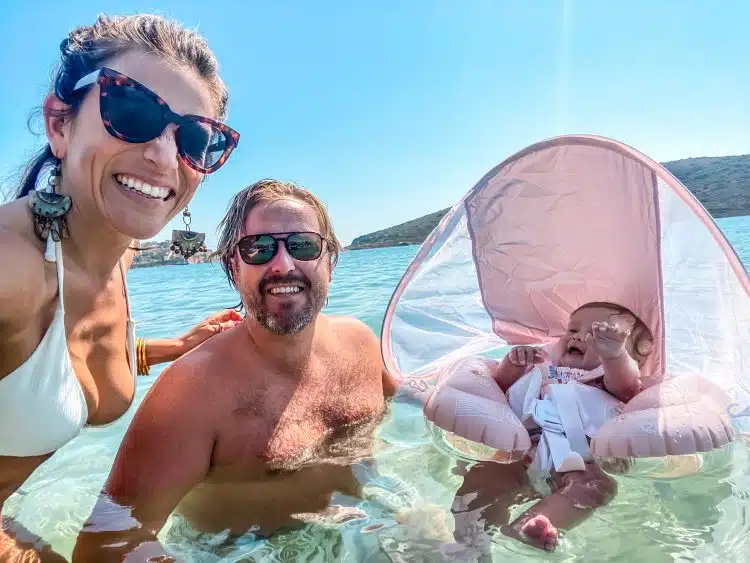
Above I mentioned that we were such light packers once upon a time. With baby, things shifted quite dramatically, though admittedly, I do feel that the first six months of traveling with her were the most difficult in terms of her needs. As babies become stronger and more capable, the infant needs become less stressful. When they’re tiny (our first international flight with Kaia was at 6 weeks old) they’re fragile. Their immune systems are fragile and their bodies are delicate so you’re naturally more concerned about having their comforts -and yours – with you.
If you’re traveling to a country in the developed world, remember that babies exist EVERYWHERE. So, diapers, for example, are not something you need to pack en masse. We bring enough to get us through flights and a few days but usually stop at a pharmacy or similar to buy more in the destination. Formula can be trickier so I do try to pack enough to get us through a trip. We use Aptamil which has been universally pretty easy to procure. Travel anecdote: we were running out of formula while in Jabal al-Akhdar during our two weeks in Oman . As you can imagine, a mom is pretty quickly in a panic realizing she didn’t pack enough food for baby and that she’s also in the middle of a mountain town in Oman with about three restaurants, a gas station, and a minimart. Lo and behold, the minimart had Aptamil. I quickly procured two containers, counted my blessings, and vowed not to risk that again. When Kaia was tiny (before she could sit on her own) we also traveled with her Baby Bjorn baby bouncer to give her a place to sit and play without having to always lay on her back. We no longer need that given she can sit independently. Blankets are a piece of home – bring baby’s favorite to put on the bottom of the crib and to put over baby as well. We travel with our portable baby monitor by Nanit (a must for us), along with a portable router for our Nanit, and a white noise machine. Depending on the destination, we may also bring things like swim diapers, floatation devices for infants, etc.
On the Ground with an Infant
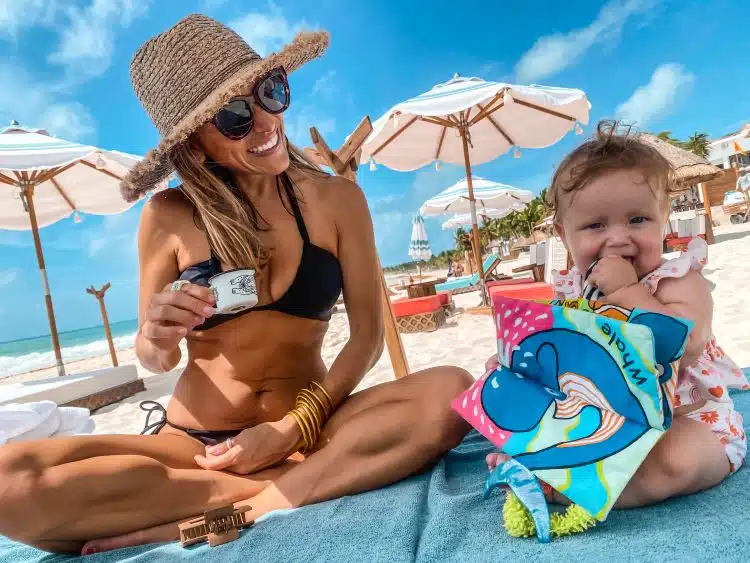
You’ve made it to your destination – yay! There’s major comfort when the final 30-minute countdown is on and you’re more or less clear. You made it!
Be Prepared for International Arrival – TSA, Global Entry, etc.
Reminder to frequent fliers new to traveling internationally with an infant: just because you’ve been jet setting for years with Global Entry doesn’t mean that this is transmitted to your baby. I have found that TSA Pre-Check actually was assumed by the baby when traveling, but Global Entry is not. If you’re flying into a major US hub there’s often an option for an interview upon arrival but you must submit the application prior. If you’ve submitted your app, you can go to a window where your infant will be ‘interviewed’ (formality, obviously) and then can finalize their own process.
Airport Arrival – Special Family Lines
Piggybacking on the above, one of the benefits of international travel with an infant is that you often have access to special family lines and stroller-friendly pathways. I used to feel bad zipping past lines of people, but they’re just as happy to get a baby moved through to avoid noisy infants and crying while waiting for passport control. Babies obviously still need to go through passport control (see above somewhat obvious – but apparently not-so-obvious – point that babies also need passports to travel internationally).
Hotel Bookings with an Infant
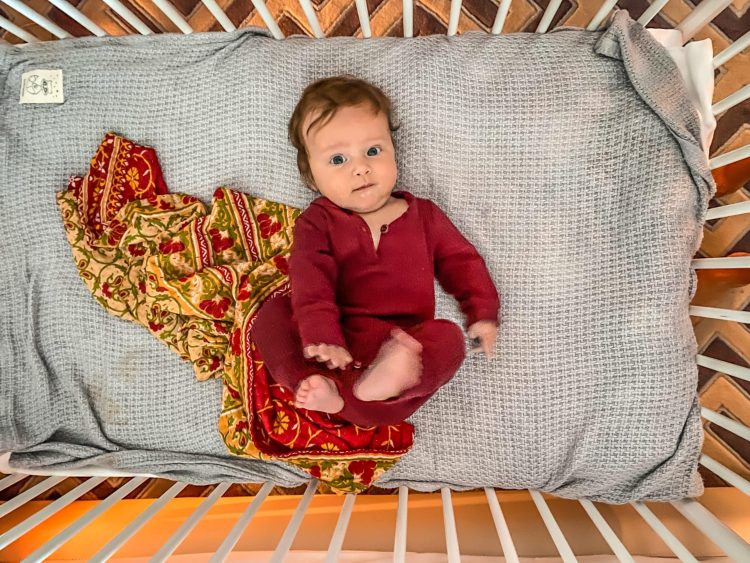
As a frequent traveler and as a hotelier, I can tell you that no request is too weird and where possible, hotels will do their best to honor your requests and needs. My common requests:
- A crib: Some people travel with a Pack n’ Play. I prefer to take as little as we can (which is still too much) so we request a crib when on the move. Kaia has slept in 20+ different cribs so is very flexible but my must is taking a blanket that is familiar so there’s a sense of continuity for her.
- A Kettle: We use formula so a kettle is important for preparing baby food (water must be boiled as formula isn’t sterile). Some rooms are equipped with a kettle but many are not and can be delivered upon request.
- Microwave or Sterilizer: If you’re traveling with a young infant and using bottles, you’re likely still sanitizing as well. I’m not strict about a ton, but I was very strict about sanitizing to avoid any tummy issues. You have three options here depending on what you have access to: 1) Sterilizer bags + microwave, 2) a sterilizer, or 3) pieces boiled in a kettle. With the first option, you’ll need a microwave to be accessible (though you can sometimes as hotel staff to microwave for you). The bags allow you to put in about 60mL of water, plus bottles, caps and nipples and microwave for 1.5 – 4 minutes (depending on microwave strength) to sterilize. With option 2, the hotel kindly provides a bottle sterilizer that gets plugged in and requires no microwave or special equipment from you (we do this at Borgo but it’s not a common amenity). With option 3, if you’re in a bind, you can boil some parts in the kettle to sterilize. It’s the less safe/secure/proper approach but in a bind, it’s the best solution. Bring your bottle brush if you can.
Luxury hotels will sometimes provide baby-friendly bath products, baby robes, baby amenities, etc. but I’ve found that true at very luxe properties like the Ritz in Dubai, the Ritz. in Muscat and the Belmond Maroma in Riviera Maya.
International Medical Needs
It’s every parent’s hope that their baby never gets sick and that they never need medical care internationally. We were 9 for 10 until we got to Mexico where Kaia got a virus (not bacterial/water-based). Babies touch everything and put their hands in their mouths constantly so it’s just a matter of time until they get a tummy bug. Obviously, make sure that you have medical insurance and that your baby is covered under your plan. If necessary, get travel insurance as well. Keep a scan of your baby’s vaccination records and of course know what medications they’re taking, if any, and bring extras if they’re on regular medications. In Kaia’s case, we had telemedicine included with our insurance. After speaking with a doctor over the phone, we were advised to find a pediatrician to look at her in person. If a pediatrician wasn’t available, we were to go to the ER to have her looked at. With infants, doctors are very conservative with their approach as babies can become easily dehydrated and affected since they’re so small. We found a local pediatrician, got in quickly, had her examined, and visited a pharmacy to collect prescribed medications. It’s frightening when babies get sick, especially when you’re away from home, but know that developed countries (and developing countries, for that matter) will likely have a nearby facility for medical care and babies exist around the world so there will more than likely be a pediatrician to assist. Our insurance includes airlift in case there is a major issue requiring us to seek medical care away from the country we’re visiting. It’s not a bad idea to travel with baby probiotics and infant Tylenol to help with stomach issues and for fever and pain regulation.
If we’ve learned anything since beginning our parenting journey it’s that it’s the most humbling learning experience, it’s an exercise in flexibility, resourcefulness, and selflessness that yields the most rewarding moments. When parents talk about the rewarding side of travel with baby, there’s no doubt that watching some of your little one’s firsts unfold overseas is one of the coolest and most rewarding things imaginable and it’s those little moments, hearing tiny laughs that make all the extra suitcases and missed rooftop bars somehow worth it. ✧
Have you begun your international travel with baby? Tips, tricks, or reassurances to add for other parents out there?

More about Shannon Kircher
Shannon Kircher is the founder and editor of The Wanderlust Effect. Founded in 2009, she has continued to document her international escapes as an expat in Europe and the Caribbean. Additionally, Shannon is the founder of Compass & Vine, a luxury boutique travel design firm, and is the Director of Marketing for the Frangipani Beach Resort. Shannon holds an MSc in Social Policy and Development from the London School of Economics and is a current candidate for WSET Level 3 in Wines & Spirits.
Related Posts
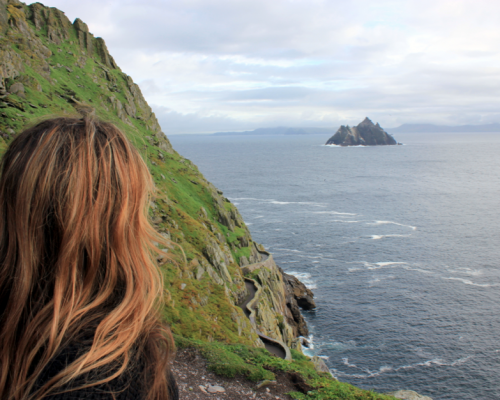
Journey to Skellig Michael
October 7, 2015

Brazil: Packing for Rio de Janeiro + Iguazu
May 25, 2015

Three Days in Chiang Mai
September 27, 2019

An official website of the United States government
Here’s how you know
Official websites use .gov A .gov website belongs to an official government organization in the United States.
Secure .gov websites use HTTPS A lock ( Lock A locked padlock ) or https:// means you’ve safely connected to the .gov website. Share sensitive information only on official, secure websites.
Traveling with Children
All passengers are required to undergo screening. However, TSA has developed modified screening procedures for children who appear to be 12 years old and younger. TSA officers will consult parents or the traveling guardian about the child’s screening.
TSA standard screening procedures apply for children 13 years and older. Carry-on property of all passengers, regardless of age, must be screened. All passengers who alarm will undergo additional screening.
Children with Medical Conditions, Disabilities, or Mobility Aids
Inform the TSA officer if the child has a disability, medical condition or medical device.
Let the TSA officer know if your child is able to walk through the metal detector or needs to be carried through the metal detector by a parent/guardian. You may carry your child through the WTMD. The TSA officer will not remove your child from their mobility aid, wheelchair or scooter.
Request Assistance
TSA Cares provides information to passengers with disabilities, medical conditions and those that need additional assistance to better prepare for the security screening process. Call TSA Cares 72 hours prior to traveling with questions about screening policies, procedures and what to expect at the security checkpoint. You may also call to request assistance at the checkpoint.
Liquid Formula, Breast Milk, Toddler Drinks, and Baby/Toddler food (to include puree pouches)
Formula, breast milk, toddler drinks and baby/toddler food (to include puree pouches) in quantities greater than 3.4 ounces or 100 milliliters are allowed in carry-on baggage and do not need to fit within a quart-sized bag. Formula, breast milk, toddler drinks and baby/toddler food (to include puree pouches) are considered medically necessary liquids. This also applies to breast milk and formula cooling accessories, such as ice packs, freezer packs and gel packs (regardless of presence of breast milk). Your child or infant does not need to be present or traveling with you to bring breast milk, formula and/or related supplies.
Inform the TSA officer at the beginning of the screening process that you are carrying formula, breast milk, toddler drinks and baby/toddler food (to include puree pouches) in excess of 3.4 ounces. Remove these items from your carry-on bag to be screened separately from your other belongings. TSA officers may need to test the liquids for explosives or concealed prohibited items.
It’s helpful to the officers when formula and breast milk are in clear, translucent bottles and not plastic bags or pouches. Liquids in plastic bags or pouches may not be able to be screened by Bottle Liquid Scanners, and you may be asked to open them (if feasible) for alternate screening such as Explosive Trace Detection and Vapor Analysis for the presence of liquid explosives. Screening will never include placing anything into the medically necessary liquid.
TSA X-ray machines are not harmful to food or medicines. However, if you do not want the formula, breast milk, toddler drinks, and baby/toddler food (to include puree pouches) to be X-rayed or opened, please inform the TSA officer. Additional steps will be taken to resolve alarms. You or the traveling guardian will undergo additional screening procedures, to include Advanced Imaging Technology screening and additional/enhanced screening of other carry-on property.
Ice packs, freezer packs, frozen gel packs and other accessories required to cool formula, breast milk, toddler drinks and baby/toddler food (to include puree pouches) – regardless of the presence of breast milk – are also allowed in carry-ons, along with liquid-filled teethers. If these items are partially frozen or slushy, they are subject to the same screening as described above.
Passengers requiring special accommodations or concerned about the security screening process at the airport may request assistance by contacting TSA Cares or by phone at (855) 787-2227.
Screening of Children’s Items
- Place all carry-on baggage such as children's toys, bags and blankets on the X-ray belt for screening.
- Strollers, umbrella-strollers, baby carriers, car and booster seats and backpacks must be screened by X-ray.
- Place items in the stroller pockets or baskets, in a carry-on bag or on the X-ray belt for screening.
- Equipment that does not fit through the X-ray machine will undergo a visual/physical inspection by TSA officers.
Screening Technology
Walk-Through Metal Detector
Children able to walk through the metal detector without assistance may do so separately from their parent or guardian. If they alarm, children are allowed multiple passes through screening technologies and may undergo other procedures to resolve the alarm to reduce the need for a pat-down. Infants and small children may be carried through the metal detector. Should the alarm sound, additional screening is required.
Advanced Imaging Technology
If your child is able to remain standing in the required position for 5 seconds, he or she may be screened through the advanced imaging technology. If a child 12 and under goes through the machine and alarms, they have an opportunity to go through again or the TSA officer may use other procedures to resolve the alarm to reduce the need for a pat-down.
You may not be screened by this technology when carrying an infant or child.
Screening your Child
- Children 12 and under can leave their shoes, light jackets and headwear on during screening. For AIT screening, light jackets must be removed and placed on the X-ray belt.
- Children will not be separated from their parent/guardian.
- Remove infants and children from strollers and car seats and carry them in arms through the walk-through metal detector.
- Infants may be carried in a sling/carrier (to include lap baby) through the walk-through metal detector or when being screened in a wheelchair, but may be subject to additional screening
- Modified screening procedures are in place to reduce the likelihood of a pat-down.
hospital packing list
New modern mom, amazon picks, liketoknowit, gift guides, latest posts.
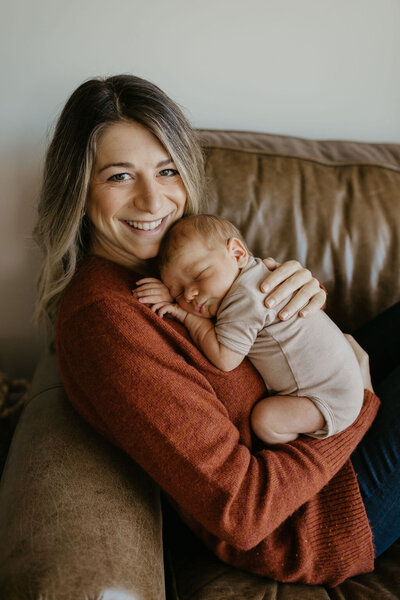
The Top of Mind Newsletter by New Modern Mom is your guide to a fulfilling life, packed with wisdom on motherhood, travel, career, style and self care. Get the latest resources, news and musings right to your inbox.
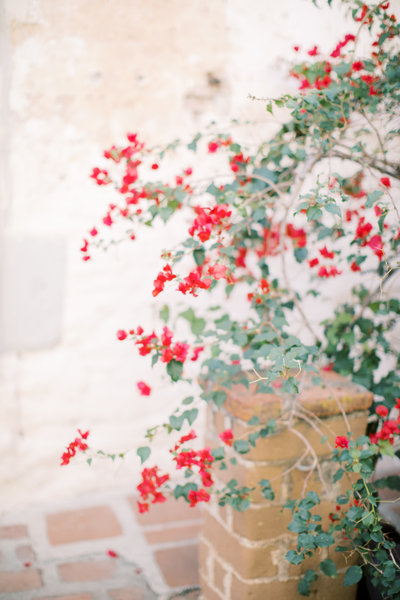
Step-by-Step Guide for International Travel With an Infant
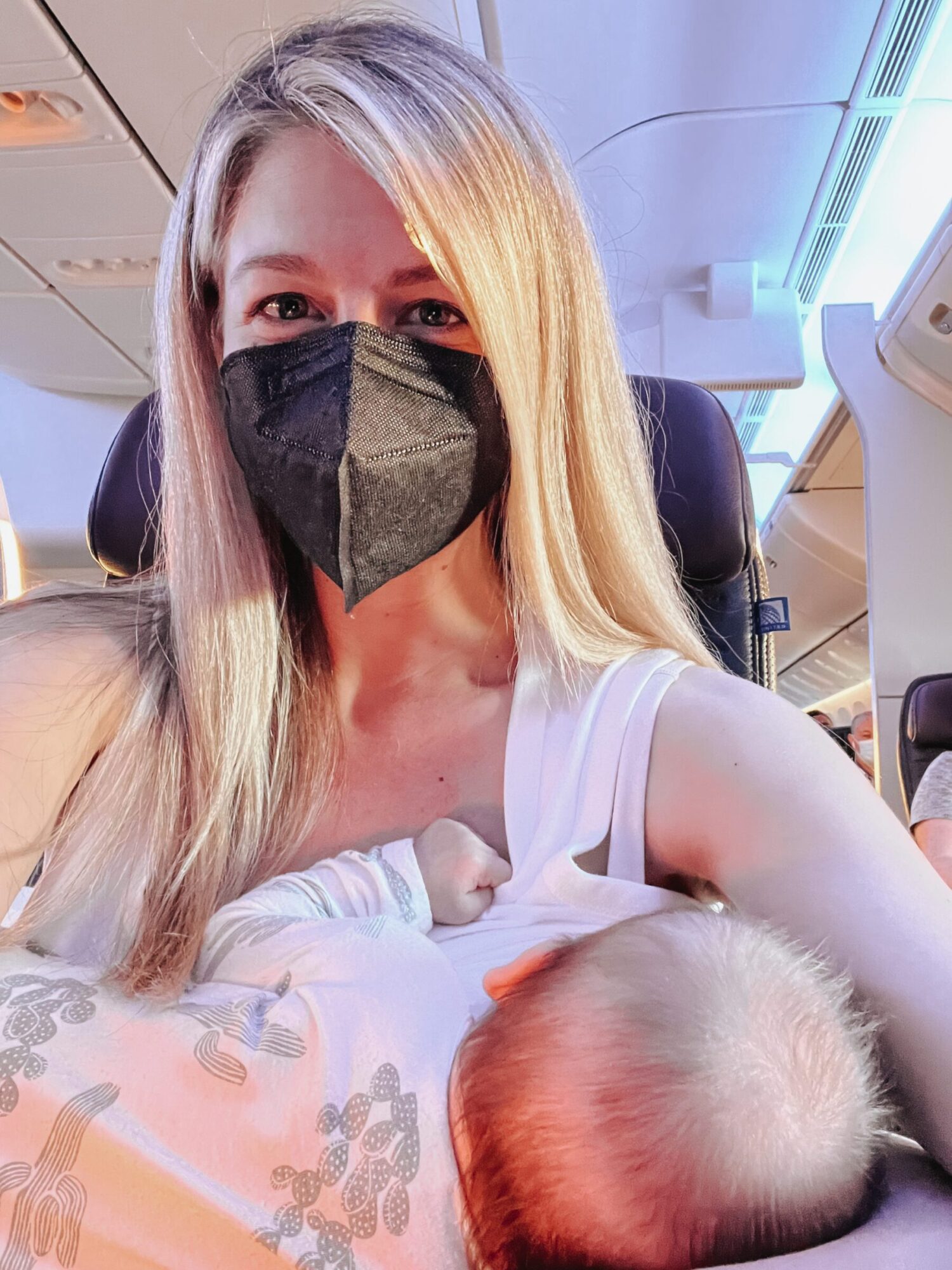
Written by:
Barbara mighdoll.
So you've got this adorable new addition to your family and you're itching to introduce them to the wonders of the world. Good news! The third and fourth months of your baby's life are the perfect time to start traveling – road trips, domestic flights in the United States, and yes, international trips too. Your little one can snooze through most flights (especially in a comfy bassinet seat) or car rides, doesn't require their own plane seat, and can be easily transported from place to place in a compact stroller.
But hold on, there's a bit of groundwork for you new parents to lay before you can jet off on international travel. It might seem like a mountain of tasks, but trust me, it's easier than you think! We had grand plans to whisk our firstborn, Caden, off to the South of France or Tuscany, Italy… and then, well, COVID happened. So, our dream three-week family trip got postponed until our second baby, Willow, was born. We learned A LOT about traveling internationally with an infant (and toddler) from our trip to Italy when Willow was 2 months old .
We were so eager to travel that we'd already booked our flights and accommodations before Willow's arrival, so when it came to getting her passport, we had to be quick off the mark. Now, our kids are seasoned travelers, ready to globe-trot with us at a moment's notice. Aside from numerous U.S. destinations, they've explored Mexico, Italy, and next on the list… Portugal.
Needless to say, we are big fans of travel as a family, and I’m here to show you it can be done with tiny little newborns! I hope these baby tips and tricks for international travel that we've picked up along the way will be helpful to you.
1. Secure your flights and bulkhead seats before your baby is born
2. obtain your baby’s official birth certificate and social security number asap, 3. complete form ds-11, but hold off on signing it, 4. attend your passport application appointment as a family, 5. select spacious accommodations with home-like amenities, 6. plan a conservative itinerary, 7. add a lap infant to your flight reservation, 8. set up your baby for global entry, 9. schedule baby’s vaccinations at least 2 weeks ahead of your travel, 10. buy the right baby gear, 11. craft a smart packing list, 12. plan for breast milk and formula on the flight, 13. strategize airport security, 14. airtag all your checked baggage, 15. enjoy exploring the world as a family, when to book your flights.
Book your trip far in advance – you aren’t going to want the stress of planning an international trip when you are a sleep deprived, exhausted parent of a 2 week old. Figure out the ideal dates for your trip based on when you expect your baby to be no less than 8 weeks old. You may be asking… how soon can you travel with a newborn? Most pediatricians recommend waiting until your baby is at least 2 to 3 months old since your baby’s immune system is still developing. Check with your doctor for guidance.
You're going to want to buy refundable tickets for travel. Yes, refundable tickets might be a bit pricier, but they're worth every penny for the peace of mind they offer in case either baby or Mama aren't up for international travel. Again, you should consult with your pediatrician before traveling. We haven’t done this, but you may want to consider travel insurance depending on your circumstances.
Seats to reserve
Plus, booking well in advance means you're more likely to snag those coveted bulkhead seats. Of course the extra space is nice, but that's where you can also secure the airplane bassinet so that you don't feel the need to buy your baby an extra seat for long haul flights. Do check with your airline to confirm which seats – the ones by the window or the ones in the center of the plane – have bassinet access. For instance, when we flew United, we initially bought the row of bulkhead seats by the window, only to find out that the bassinet attachments were only available in the center group of seats. So, we had to switch.
You may be having the big debate of splurging for business class. My 2 cents: at minimum get yourself Premium Economy (one class up from Economy Plus). But if you plan far in advance you can take advantage of credit card bonus point deals to upgrade yourself to Business class tickets in time for your trip!

Apply for this credit card to get upgraded on your trip
American express business platinum.
Currently you can earn 120,000 membership reward points if you make $15k in purchases within the first 3 months. Apply now.
- Points Transfer: 1:1 ratio for most airline and hotel loyalty programs
- Flight Upgrades: Use points to upgrade flights on over 20 airlines
- Airline fee credit: Get up to $200 in statement credits for fees including checked bags and in-flight refreshments
- Lounge Access: Includes The Centurion Lounge, Delta Sky Club and Priority Pass Select
- Global Entry or TSA Pre-check: Statement credit up to $100
To apply for a U.S. passport , you'll need your baby’s birth certificate and their social security number. Both of these can only be obtained after your baby is born. In the hospital, you'll likely receive a certificate, but for your baby’s passport, you'll need the “certified birth certificate” (issued by your city, county, or state, depending on where you live). Once you get the official birth certificate, double-check that both parents’ names are printed correctly as it will be used as proof of parental identity. Typically, you'll receive the official birth certificate one to two weeks after giving birth. In some cases, you can request to pick it up instead of having it mailed if you're in a rush and the records office is nearby.
Pro tip: Get in touch with your hospital administration (or whoever handles processing) ASAP once your baby arrives. They usually only submit to the City/County/State once or twice a week, so you'll want to get it in early if you're in a rush, definitely before the weekend. There can be added fees for expediting, but if you're pressed for time for an international trip, ask if there's anything the hospital can do to speed things up.
The DS-11 form is the official application for your infant's passport. You'll need your baby’s social security number to fill out the form, along with the basics like date of birth, place of birth, gender, and contact info for both parents. You can find the Form DS-11 right here . *Important* don't sign the forms just yet — you'll need to sign in person during your passport appointment!
When you submit your application, you'll also need to send both the original copy of your baby’s official birth certificate (don't worry, they'll mail it right back to you!) and a photocopy of it. Both parents need to submit their own IDs. This, along with the birth certificate, verifies that you are indeed the baby’s parents. Your passports or driver’s licenses will work for this. You'll need to bring your passport/license to your appointment, along with copies for each of you.
Pro Tips:
- If you're in a rush, schedule your passport appointment before your baby arrives. We did this and walked right into the post office when Willow was 7 days old.
- Make sure your identification copies are on white, 8.5” x 11″ standard paper, black and white, and single sided.
- If you've adopted your baby, you'll need to bring your adoption decree and copies of it as well.
The Passport Appointment
You'll need to schedule an in-person appointment with both parents/guardians present. If one parent can't make it, fill out a “Statement of Consent” (Form DS-3053) for the non-appearing parent and get it notarized. You'll also need a clear copy of the non-applying parent's government-issued photo ID, front and back. In most cases, I highly recommend making this appointment as soon as you have the birth certificate and social security number just in case there's a wait!! Our local post offices only accept appointments 4 weeks in advance. While you wait for your appointment date, start preparing all of the forms and materials you need to bring with you.
During the appointment they'll take your baby’s passport photo, review all your forms, and check your identification. Then, you'll sign the DS-11 form in front of them, they'll attach your baby’s photo to the application, and you'll pay the fee to officially submit it. It’s $100 for the passport itself, and $35 for the processing fee. It’s important to note that the state department is a bit old school, and you must submit a check (personal, certified, cashier's, traveler's) or money order payable to “U.S. Department of State”. Unfortunately, credit and debit cards are not accepted.
Ahead of your appointment, confirm if the location offers passport photo services because it's time to take that perfect shot of your baby for their passport, but don't worry, there's a bit more flexibility with baby passport photos. It's understood that getting a photo of a newborn with their eyes fully open, looking at the camera, and sitting up is a tall order. For tips on a DIY passport photo, check out tip #3 on this baby passport FAQ .
Tracking Your Baby's Passport Progress
After your application is submitted at your appointment, you can track your baby’s passport application with the government’s passport application tracker . For expected processing times, check out tip #7 on my baby passport FAQ.
Forgot this critical step?
Forgot to get your baby a passport and now have no time before your trip? Don’t panic. There are services for this. There are some qualifying criteria first:
a) If you have not yet applied, you must be traveling internationally within 14 calendar days.
b) If you have already applied, you must be traveling internationally within 5 calendar days.
If one of these circumstances describes you, then you need to quickly find your nearest Passport Agency and call their office to make an appointment. You can find a map of these here . Be aware that these agencies and centers are different from passport acceptance facilities (for example, USPS is an acceptance facility but not going to cut it as a passport agency when you need urgent results).
Pro Tip: If you choose to expedite your passport processing, there is an additional $60 fee. Technically, that $60 additional expedited fee is for once the passport arrives. To avoid issues with mail transit, you should invest in certified tracking or pay additionally to expedite (yes this is on top of passport, processing, and expedited fees).
When traveling with an infant, your choice of accommodation can make a big difference. Instead of the usual hotel room, consider booking a vacation rental that offers more space and home-like amenities.
Having separate sleeping and living areas can be a lifesaver when traveling with a baby. You can put your baby down for a nap or bedtime in a quiet room, while you relax, squeeze in a workout, or plan your next day.
Look for accommodations with a kitchen or kitchenette. Having the ability to store and prepare baby food, formula, or breast milk can make meal times easier and more flexible. Plus, you can save money by eating meals in. We personally love shopping local and cooking meals with fun local ingredients.
Also, consider the location of your accommodation. Staying in a central location can reduce travel time and make it easier to return for nap time or if you forget something.
Pro tip: check if your accommodation offers baby gear like a crib or high chair. Many family-friendly accommodations do, and it can save you the hassle and space of bringing your own.

Traveling with an infant means slowing down. Gone are the days of jam-packed itineraries, adventurous bucket list checking outings, rushing from one tourist spot to another. With a baby in tow, you'll want to plan a more relaxed and flexible schedule. Our go-to is always TripAdvisor to research the best local spots and tours.
Babies need frequent breaks for feeding, diaper changes, and just to relax and play. So, instead of trying to see everything, pick one, yes I said one, big outing each day. This could mean wine tasting at a beautiful winery in Tuscany, soaking in the sun with a beach day in the South of Spain, or exploring The Louvre followed by a picnic lunch in front of the Eiffel Tower.
Also, consider your baby's nap times. If your little one sleeps well in a stroller or carrier, you might plan your day around a long walk or a museum visit during nap. If your baby prefers a quiet, dark room, you might head back to your hotel or vacation rental for nap time.
And don't forget to plan some downtime for yourself too! Traveling with a baby can be exhausting, and you'll enjoy your trip more if you're not worn out. So, whether it's a leisurely lunch while the baby naps, a quiet evening cooking dinner with local ingredients in your villa, or even a relaxing bath after the baby's bedtime, make sure to take some time for yourself doing absolutely nothing.
The goal of your trip is to enjoy your time as a family, not to see and do everything. So, take it slow, be flexible, and savor this special time with your baby.

Next up, you'll want to add your infant to your flight reservation as a lap child. Even though your baby will be on your lap for the journey, airlines still need to know they're coming. This process varies by airline, but typically, you can add a lap infant during the booking process or by calling customer service after you've booked your own ticket.
While your baby might not need their own seat, there could be additional fees for a lap infant on international flights, but the cost is nothing compared to an adult fare. So, make sure to check with your airline about any extra costs.
Pro tip: As soon as you walk onto the airplane, ask the flight attendant to set up the baby bassinet after takeoff if you were lucky enough to get the bulkhead seats. It's a good idea to board during family boarding for extra time to get on the plane and get situated in your airplane seat.
Consider setting up Global Entry for your baby. This program can make re-entry into the U.S. a breeze, saving you time and stress at customs.
To do this, you'll need to apply for Global Entry for your baby, just like you would for an adult. The process involves filling out an online application and scheduling an interview.
Keep in mind though, unlike TSA pre-check, even if both parents have Global Entry, it doesn't extend to your baby. Each individual, regardless of age, needs their own Global Entry to use the expedited lanes.
Pro tip: You can actually do your interview upon arrival back in the U.S. from an international trip. This is called “Enrollment on Arrival” and it's a great way to knock out the interview without an extra trip to the airport.
Check to ensure traveling with your infant is safe by your doctor. Ask about the specific vaccinations your destination requires, whether your baby can wear sunscreen or bug spray, and the methods to protect your baby from diseases prevalent in the area you plan to visit
If you plan to travel when your infant is 8 weeks old, you can usually administer most, if not all, of the 2-month shots safely from 6 weeks old. We chose this approach for Willow to ensure her full protection by the time we traveled when she was 8 weeks old. *I am not a medical professional, and you need to consult with your pediatrician on what is best for your family.

The must-have baby gear
You’ll need the right baby gear to make your travel simpler. Here are my must-have travel essentials along with the actual brands we use:
- a compact, lightweight stroller that fits in the overhead bin | UppaBaby Minu V2 with the car seat adapters for the UppaBaby Mesa
- comfortable baby carrier | Artipoppe (but cheaper option is the Wildbird Aerial Carrier )
- travel diaper bag | No Reception Club Getaway Bag Code: NMM20 for $20 off
- car seat travel bag | versatile option from Amazon
If the hotel or vacation rental you’re staying at does not have a crib, you’ll also need to bring a lightweight portable travel crib (we love the Guava Lotus ) and depending on the age of your baby, you'll also want the Slumberpod . However, I strongly recommend booking one that does have a crib so you don’t need to pack this!

The nice-to-have baby gear
Some other items I couldn’t live without: I highly recommend packing the Baby Bjorn Bouncer if your baby is not sitting up on their own yet. It may be bulky to travel with, but you can bring it as a carry on in this handy Travel Bag and it's 100% worth the hassle to have a safe place to set down your infant while you are getting ready, during meals, really any time of the day. Another travel must for me was the SnuggleMe Feeding Pillow , which allowed for hands free feeding on the airplane, and hands free napping on Mama on the airplane or during meals out and about.
Packing list for your infant
Packing for a trip with an infant requires a bit more thought and planning. You're not just packing for yourself anymore, but for a tiny human who has their own set of needs. So craft your packing list well in advance of your trip.
First, make a list of all the everyday essentials your baby will need. Diapers, wipes, clothes, feeding supplies, and comfort items like a favorite blanket or stuffed animal.
Second, think about what you'll need for the flight itself. Pack enough diapers in your carry-on bag for 3 days, and 3 changes of extra clothes – you never know if your flight will be delayed, diverted or canceled.
Third, consider what you can buy like diapers and formula at your destination. But if you are like me, and are very particular about the products you use on your baby or if your destination is a bit more remote, I recommend utilizing the extra space in your checked car seat bag to fill it with enough diapers for your trip .
Fourth, plan for the medical unknowns. Pack an infant thermometer , infant tylenol, infant ibuprofen, infant benadryl, medicine dispenser , nose frida with extra filters, saline spray , natural vapor rub , antibiotic ointment, bandaids, adult tylenol, adult cold and flu medicine, and tums. You can usually find most of these items at a local pharmacy, but pharmacies often don't operate 24/7.
Lastly, pack items that will help maintain your baby's sleep routine, like a portable white noise machine, swaddle or sleep sack. I love how small the new Hatch’s Rest Go sound machine is.
Your packing list
For your own packing list, I know it is HARD, but I recommend fighting the urge to overpack for the “just in case” moments. Instead, build a thoughtful capsule wardrobe to save space in your luggage and minimize shoe options (both Jason and I basically lived in our Birkenstocks for 3 weeks in Italy). It’s a fun project during your middle-of-the-night feedings in those hazy first few weeks of newborn life 🙂
For luggage, we brought 3 roller bags: two large checked bags and one small carry-on bag. My favorite carry-on bags are Beis The Carry On Roller or July Carry On Pro .
Nursing while traveling
If you're breastfeeding, consider your comfort and privacy while on the move. Many airports offer nursing rooms, but on the plane, you might want a window seat for a bit more privacy. A nursing cover can also be a lifesaver (literally every single friend of mine owns this one ). Personally I opted for this with Caden, but with my second baby, Willow, I embraced feeding in public and cared less about modesty.

Pumping while traveling
If you are at all reliant on pumping, bring your breast pumps with you in your carry-on bag. The last thing you'll want to stress about is your luggage getting lost with your pump in it. I also highly recommend bringing a manual breast pump as a backup in case your pump stops working or you lose a part.
I tested multiple coolers and ice packs and these are the winners to bring with you on the plane:
- Hydro flask 20L Carry Out Soft Cooler
- Cooler Shock Reusable Ice Packs
Using formula while traveling
For those using formula, pack enough for the long flight and bring 3 days of extra formula in your carry-on luggage for any unexpected delays or difficulties in finding formula at your final destination. Pack a travel sized formula container and ask the airline for hot water.
- TSA allows you to bring a reasonable amount of breast milk, formula, and baby food for your infant. It's exempt from the 3-1-1 liquids rule, but you do need to declare it at security.
- Pack a few extra bottles, a bottle warmer and portable bottle cleaner and soap.
- Pack these breast pump cleaning wipes for on-the-go pumping.
- To avoid ear pain, plan to feed your baby during takeoff and landing.
Navigating airport security with an infant requires a bit of strategy when you have young children. Jason and I literally talked through the entire ordeal prior to arriving at the airport – who would wear the baby, who would lift the stroller, etc.
If you do not have TSA pre-check check if the airport has a family lane. These lanes are designed for families, and can make the process smoother without having an annoyed traveler giving you dirty looks behind you.
Baby gear like strollers and car seats need to go through the X-ray machine. Decide who will be in charge of folding up your stroller. If you bring your car seat through security, you'll need to clip the straps together and flip it upside down to go through the machine.
Wear your baby in a baby carrier if possible. This frees up your hands for handling IDs, tickets, and luggage. In most cases, you will not be asked to remove your baby from the carrier during the screening process.
Plan to do a diaper change after you get through security, before boarding.
Pro tip: If you are traveling with the UppaBaby Vista, it won’t fit through the X-ray machine. You’ll need to wait for a TSA agent to conduct an extra security check. This stroller is bulky and heavy to be traveling with, which is why I’m the absolute biggest fan of the UppaBaby Minu V2 .
When it comes to international travel with an infant, keeping track of your belongings becomes even more crucial. Airlines, unfortunately, can misplace luggage, and this risk seems to increase with international travel. To help prevent this, consider using Apple AirTags on your checked luggage, including gate-checked stroller bags. Use different colored keychain holders and assign the colors to your Find My app. Make note of which bag is which color. The airline actually lost our gate-checked stroller when we went to Italy and it took 8 days to get it back. By having the AirTag we were able to locate our stroller and help the airline coordinate delivery.
Always make sure to have your most valuable and essential items – like passports, wallets, and necessary baby supplies – in your carry-on luggage. And when it comes to gate-checked items, make sure they're securely packed and labeled with your contact information.
Once you reach your final destination, expect jet lag to take three days to wear off. We had one of the most magical experiences on our international family trip to Italy during our parental leaves. Will my kids remember it? No, but there is photographic proof they were there, and it was made so much more special because of it.

So, there you have it, a step-by-step guide full of my best tips to traveling internationally with an infant. Follow these steps to enjoy the adventure of a lifetime with your little one. If this still seems too overwhelming, but you're anxious for a getaway, consider a roadtrip (and here are some tips )!
Interested in an extended international trip with your baby?
And if you are ready for an extended international trip, I’m excited to share we’ve booked a two-month “ Boundless Life ” experience next summer. This program is for digital nomad families, with co-working space for adults and daycare, preschool and elementary school for the kids. Want to join us? I’ll be writing more about Boundless Life and our decision to take this adventure soon. But in the meantime, 2024 cohorts are almost sold out, so book an intro call, and use code NEWMODERNMOM for €400 off your trip.
I live in San Francisco with my husband, Jason, toddler, Caden, one year old baby, Willow, and Bernese Mountain Dog, Bear. I previously held multiple VP of Marketing roles at tech startups before deciding to take the leap to build New Modern Mom full time in an effort to find fulfillment and flexibility in my life. I also was a fitness instructor in an earlier life. I created this space to curate the best products and real advice on pregnancy, motherhood, cooking, travel and more to make doing it all for ambitious moms like me a whole lot easier.
See author's posts
You may also like...

This post may contain affiliate links including the Amazon Associates Program. When you make purchases through links in this post, I may earn a small commission at no extra cost to you. I only endorse products I believe in.
Hospital bag checklist: a minimalistic approach », « amara smoothie melts vs. happy baby yogis.
Becoming a mom introduced a new dimension to my identity, transforming my perception of ambition and success. At 29, I had already achieved my dream role through dedication, hard work, and unrelenting strides beyond my comfort zone. But with the arrival of my first child, the dream job I had so passionately chased suddenly lost its luster. I was caught in the dichotomy of wanting to be present as a mother and seeking fulfillment in a thrilling career. I felt like I couldn’t lean into either side without sacrificing something. So I spun up a passion project, now turned full time career. I built New Modern Mom as a resource to help you simplify the daily chaos of motherhood. But New Modern Mom is more than just a publishing platform, it’s a mission to empower mothers striving to find that delicate balance between a rewarding career and cherishing precious moments of motherhood. It's about living a fulfilled, balanced, present, and beautiful life amidst all the chaos.
about NEW MODERN MOM
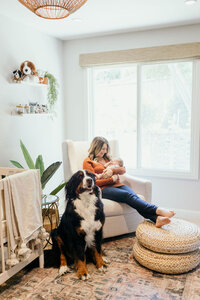
New Modern Mom 2024. All rights reserved.
Photography Credits
Affiliate Disclaimer
Terms and Conditions
Privacy Policy
June 1, 2020
Due to travel restrictions, plans are only available with travel dates on or after
Due to travel restrictions, plans are only available with effective start dates on or after
Ukraine; Belarus; Moldova; North Korea; Russia; Israel
This is a test environment. Please proceed to AllianzTravelInsurance.com and remove all bookmarks or references to this site.

Use this tool to calculate all purchases like ski-lift passes, show tickets, or even rental equipment.

9 Tips For International Travel with an Infant
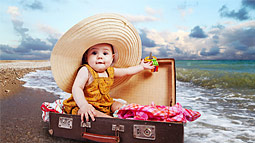
Get a Quote
{{travelBanText}} {{travelBanDateFormatted}}.
{{annualTravelBanText}} {{travelBanDateFormatted}}.
If your trip involves multiple destinations, please enter the destination where you’ll be spending the most time. It is not required to list all destinations on your policy.
Age of Traveler
Ages: {{quote.travelers_ages}}
If you were referred by a travel agent, enter the ACCAM number provided by your agent.
Travel Dates
{{quote.travel_dates ? quote.travel_dates : "Departure - Return" | formatDates}}
Plan Start Date
{{quote.start_date ? quote.start_date : "Date"}}
Share this Page
- {{errorMsgSendSocialEmail}}
Your browser does not support iframes.
Popular Travel Insurance Plans
- Annual Travel Insurance
- Cruise Insurance
- Domestic Travel Insurance
- International Travel Insurance
- Rental Car Insurance
View all of our travel insurance products
Terms, conditions, and exclusions apply. Please see your plan for full details. Benefits/Coverage may vary by state, and sublimits may apply.

Insurance benefits underwritten by BCS Insurance Company (OH, Administrative Office: 2 Mid America Plaza, Suite 200, Oakbrook Terrace, IL 60181), rated “A” (Excellent) by A.M. Best Co., under BCS Form No. 52.201 series or 52.401 series, or Jefferson Insurance Company (NY, Administrative Office: 9950 Mayland Drive, Richmond, VA 23233), rated “A+” (Superior) by A.M. Best Co., under Jefferson Form No. 101-C series or 101-P series, depending on your state of residence and plan chosen. A+ (Superior) and A (Excellent) are the 2nd and 3rd highest, respectively, of A.M. Best's 13 Financial Strength Ratings. Plans only available to U.S. residents and may not be available in all jurisdictions. Allianz Global Assistance and Allianz Travel Insurance are marks of AGA Service Company dba Allianz Global Assistance or its affiliates. Allianz Travel Insurance products are distributed by Allianz Global Assistance, the licensed producer and administrator of these plans and an affiliate of Jefferson Insurance Company. The insured shall not receive any special benefit or advantage due to the affiliation between AGA Service Company and Jefferson Insurance Company. Plans include insurance benefits and assistance services. Any Non-Insurance Assistance services purchased are provided through AGA Service Company. Except as expressly provided under your plan, you are responsible for charges you incur from third parties. Contact AGA Service Company at 800-284-8300 or 9950 Mayland Drive, Richmond, VA 23233 or [email protected] .
Return To Log In
Your session has expired. We are redirecting you to our sign-in page.

- Criminal Justice
- Energy + Environment
- Health Care
- Election 2024
A bipartisan push to make air travel easier for new parents packing breast milk and formula
By: elisha brown - may 30, 2024 5:45 am.

New parents share stories of tense encounters with airport security over breast milk and formula. A bill from U.S. Rep. Katie Porter, a California Democrat, would strengthen guidelines for U.S. Transportation Security Administration officers (Getty Images).
As the summer travel season approaches, new parents may be navigating airports with their babies — and the complexities of keeping them fed. Despite federal guidelines for airport agents laying out how to treat nursing moms, stories about problem encounters with security sometimes go viral.
In 2023, actress and singer Keke Palmer said she was at Houston airport when she faced threats to throw out her 16 ounces of breast milk. A year earlier, engineer and science TV host Emily Calandrelli said U.S. Transportation Security Administration officers escorted her out of line and made her check her partially thawed ice packs, which are used to keep breast milk cool.
“It was a very traumatizing experience, and it also didn’t align with what the TSA policies were, which state that you’re allowed to have them for medically necessary purposes,” Calandrelli told States Newsroom.
In May 2022, she went on her first work trip away from her 10-week-old baby and was traveling from Los Angeles to Washington, D.C. Calandrelli planned on pumping after going through security at LAX, but TSA officers drilled her with questions about what the ice packs were for and said it wouldn’t have been an issue if her breast milk was already pumped.
“I spoke to three different males who worked at TSA, and I requested to speak to a woman but wasn’t able to,” she said.
Like Palmer, she shared the experience with her legions of social media followers. Calandrelli said the agency later apologized. TSA issued a statement shortly after the incident: “Our employees go through regular training to effectively engage and screen diverse traveler populations, including those who are breastfeeding and/or traveling with breast milk.”
Both women’s experiences violate TSA guidelines : formula, breast milk, toddler drinks and baby food are allowed on planes and carry-ons in quantities greater than 3.4 ounces. Breast milk, formula and ice packs — along with other cooling accessories — are considered medically necessary. Passengers are advised to let TSA officers know they’re carrying these items when arriving at airport security.
Even though these protections exist, many lactating parents still encounter problems during air travel, and these issues carry physical and emotional side effects, according to Tina Sherman, a doula and interim executive director at the U.S. Breastfeeding Committee.
“Lactating parents have to pump on a fairly regular basis to be able to continue to keep up their supply,” Sherman said.
When they can’t express milk or that cycle is interrupted, mothers experience pain or breast leaks, she said. In some cases, long delays in pumping can lead to mastitis — an infection that causes swelling in the breasts and cracked nipples. Emotionally, being prevented or delayed from expressing milk can make parents feel anxious, embarrassed and stressed, Sherman said.
Calandrelli’s plight two years ago led her to reach out to her local California congresswoman. U.S. Democratic Rep. Katie Porter first introduced legislation to strengthen existing protections for breastfeeding parents in August 2022.
“You have to have clear instructions and clear rules, and have people follow them in order for moms to be able to meet the standards,” Porter said. “There’s a lot of obstacles to breastfeeding. There’s a lot of challenges to feeding a baby and traveling with a baby.”
The Bottles and Breastfeeding Equipment Screening ( BABES ) Enhancement Act would require “hygienic handling of breast milk and baby formula” by TSA officers and private security companies. Porter’s bill would direct airport officials to “minimize the risk for contamination” of breast milk, formula and infant drinks, along with ice or freezer packs and related cooling accessories.
Under the proposal, the agency must consult with maternal health organizations — March of Dimes, Association of Maternal and Child Health Programs, American College of Obstetricians and Gynecologists, and the Society for Maternal-Fetal Medicine — to determine what policies and regulations need to be updated as pumping technology and best practices for breast milk storage evolve, she said.
BABES Act is an update to a 2016 law that required TSA training on special screening procedures for nursing parents. The original law also made it legal to carry larger amounts of breast milk, formula and infant drink — juice or purified water — in airports and on planes.
Reps. Maria Elvira Salazar, a Florida Republican, and Eric Swalwell, a California Democrat, are the lead co-sponsors in the House. Democratic Sens. Tammy Duckworth of Illinois and Mazie Hirono of Hawaii, along with GOP Sens. Steve Daines of Montana and Ted Cruz of Texas sponsored the bill in the upper chamber.
The bipartisan bill didn’t go anywhere last session , but Porter reintroduced the proposal. She said the bill is set to be heard in the Senate Commerce, Science and Transportation Committee soon.
As a mother of three, Porter is acutely familiar with the problems that come with traveling with infants. Her children are adolescents and teens now, but when they were babies, lactation stations in airports were uncommon. She said a flight attendant once told her to stop nursing her baby while the plane was still on the ground. Porter said she was angry and scared, but mostly “worried about my baby, who was hungry.”
As for her bill, she recognizes that TSA agents have a hard job. But the BABES Act will help them “have clear rules and better training so that they’re not put in challenging situations when they’re dealing with frustrated parents,” she said.
Making travel for lactating parents easier could chip away at larger stigma about breastfeeding, advocates said. More than 80% of babies are breastfed in infancy , and 58% are still getting some breast milk by the time they’re 6-months-old, according to the U.S. Centers for Disease Control and Prevention.
Still, earlier this month, an ad for lactation cookies featuring a cooking star’s covered breasts and pregnant belly was temporarily removed from a Times Square billboard, according to The New York Times .
“Normalizing breastfeeding and lactation is really critical to families being able to meet their breastfeeding goals,” Sherman said.
GET THE MORNING HEADLINES DELIVERED TO YOUR INBOX
Our stories may be republished online or in print under Creative Commons license CC BY-NC-ND 4.0. We ask that you edit only for style or to shorten, provide proper attribution and link to our website. AP and Getty images may not be republished. Please see our republishing guidelines for use of any other photos and graphics.

Elisha Brown
Elisha Brown is the Reproductive Rights Today newsletter author at States Newsroom. She is based in Durham, North Carolina, where she previously worked as a reporter covering reproductive rights, policy, and inequality for Facing South. Her work has appeared in The New York Times, The Daily Beast, The Atlantic, and Vox. She attended American University in Washington, D.C. and was raised in South Carolina.
Related News

FDA warns parents to avoid infant formula distributed by Texas company due to deadly bacteria

WASHINGTON (AP) — U.S. health officials warned parents to avoid powdered infant formula sold by a Texas dairy producer, because a dangerous bacteria was found in one of the company’s products.
The Food and Drug Administration issued the alert Friday on Crecelac Infant Powdered Goat Milk Infant Formula, after a sample collected from a Texas store tested positive for cronobacter, which can cause deadly infections in babies. The same bacteria sparked recalls and shortages of infant formula in 2022 after it was detected at a major U.S. formula factory.
The Crecelac formula was imported and distributed by Dairy Manufacturers Inc., of Prosper, Texas, according to the FDA. Press releases from the FDA and the company did not specify where the product was produced or how widely it was distributed in the U.S. Messages left for the company Friday were not immediately returned.
Last week, the company voluntarily recalled the Crecelac formula and another brand, Farmalac, because they had not received approval by the FDA for sale in the U.S. Infant formula distributors are required to submit data to FDA regulators showing their products meet U.S. food and nutritional standards.
The FDA said testing of the Farmalac product did not detect cronobacter, but parents and caregivers should still avoid using the formula.
Cronobacter can cause blood infections and other serious complications in infants, including meningitis and nervous system injuries. The bacteria are found naturally in the environment and also can make their way into infant formula after packages are opened.
In 2022, FDA investigators shutdown an Abbott formula plant in Sturgis, Michigan, after inspections sparked by four infant illnesses linked to cronobacter, including two deaths, showed widespread contamination at the site.
Amid the shortages caused by the shutdown, the FDA began allowing imports of infant formula produced by overseas manufacturers. Previously the agency restricted U.S. infant formula production to a handful of domestic manufacturers, including Abbott.
The Associated Press Health and Science Department receives support from the Howard Hughes Medical Institute’s Science and Educational Media Group. The AP is solely responsible for all content.
Copyright 2024 The Associated Press. All rights reserved.

Seneca Falls Police respond to shooting at Waterloo Tops Friendly Market

Nearly 200 people attend funeral for 10-year-old who died by suicide after ‘relentless bullying’

‘Brothers in Law Enforcement Motorcycle Club’ hold memorial for founder

Cortland County Drug Task Force execute a search warrant on a Cortland business

Fill up the Truck donation event at the Broome County Dog shelter
Latest news.

Jury selection is beginning in gun case against President Joe Biden’s son Hunter

Southwest Airlines is back in court over firing of flight attendant with anti-abortion views

American veterans depart to be feted in France as part of 80th anniversary of D-Day

At 100, this vet says the 'greatest generation' moniker fits 'because we saved the world'

Quadruplets ‘very proud’ as they celebrate graduation from same college together
- Open access
- Published: 26 May 2024
State paid family leave policies and breastfeeding duration: cross-sectional analysis of 2021 national immunization survey-child
- Julia Rosenberg 1 ,
- Deanna Nardella 1 , 2 &
- Veronika Shabanova 1 , 3
International Breastfeeding Journal volume 19 , Article number: 37 ( 2024 ) Cite this article
272 Accesses
10 Altmetric
Metrics details
Paid parental leave policies may promote breastfeeding, which can have short- and long-term health benefits for both members of the birthing person-infant dyad. In the United States, where 56% of the workforce qualifies for unpaid federal medical leave, certain states have recently enacted paid parental and family leave policies. We aimed to assess the extent to which living in states with versus without paid family leave was associated with feeding regimens that included breastfeeding.
In this cross-sectional analysis of the 2021 National Immunization Survey-Child, we assessed feeding outcomes: (1) exclusively breastfed (only fed breastmilk—never infant formula—both before and after six months of age), (2) late mixed breastfeeding (formula after six months), (3) early mixed breastfeeding (breastfed, formula before six months), and (4) never breastfed. We conducted Pearson χ 2 to compare social-demographic characteristics and multivariable nominal regression to assess extent to paid family leave was associated with breastfeeding regimens, compared with never breastfeeding.
Of the 35,995 respondents, 5,806 (25% of weighted respondents) were from states with paid family leave policies. Compared with never breastfeeding, all feeding that incorporated breastfeeding—exclusive breastfeeding, late mixed feeding (breastfed, formula introduced after six months), and early mixed feeding (breastfed, formula introduced before six months)—were more prevalent in states with paid family leave policies. The adjusted prevalence ratio (aPR) and differences in adjusted prevalence compared with never breastfeeding in states with versus without paid family leave policies were: aPR 1.41 (95% CI 1.15, 1.73), 5.36% difference for exclusive breastfeeding; aPR 1.25 (95% CI 1.01, 1.53), 3.19% difference for late mixed feeding, aPR 1.32 (95% CI 1.32, 1.97), 5.42% difference for early mixed feeding.
States with paid family leave policies have higher rates of any breastfeeding and of exclusive breastfeeding than states without such policies. Because all feeding types that incorporate breastfeeding were higher in states with paid family leave policies, expansion of paid family leave may improve breastfeeding rates.
The short- and long-term benefits of breastfeeding for both members of the birthing person-infant dyad have been well-established. The American Academy of Pediatrics, the American College of Obstetrics and Gynecology, and the World Health Organization promote exclusive breastfeeding for six months followed by continued breastfeeding until one to two years of age [ 1 , 2 , 3 ]. For newborns, sustained breastfeeding is associated with decreased adverse health consequences including lower rates of infant mortality and lower incidence of sudden infant death syndrome; respiratory, ear, and gastrointestinal infections; asthma; eczema; autoimmune conditions; and diabetes [ 2 ]. While exclusive breastfeeding without infant formula introduction is recommended to maximize benefits, data suggest protective effects of any breastfeeding against gastrointestinal illnesses, ear infections, asthma, and obesity [ 4 , 5 , 6 ]. For birthing people, breastfeeding is associated with decreased rates of hypertension, diabetes, and certain types of cancer [ 1 , 2 ]. In addition to the individual benefits, breastfeeding promotes dyadic health with opportunities for bonding and benefits for mental and physical health [ 7 ]. According to the Centers for Disease Control and Prevention (CDC) breastfeeding report card, in 2019, only 25% of infants born in the United States (US) exclusively breastfed until six months of age and about 36% were breastfeeding at one year [ 8 ], falling short of the US Healthy People 2030 targets of 42.4% and 54.1%, respectively [ 9 ].
A major barrier to sustained breastfeeding can be caregivers returning to work. Globally, longer maternity leave is associated with higher rates of breastfeeding [ 10 ]. In the US, exclusive breastfeeding decreases by approximately 25% within the first week of life, nearly 50% by three months, and 70% by six months, correlating with return to work for many parents [ 8 ].
With nearly two-thirds of females participating in the US workforce having a child under three years of age [ 11 ], the need to establish and evaluate policies that protect breastfeeding for working lactating persons has been underscored in formal recommendations, including through the Surgeon General’s Calls to Action to Support Breastfeeding and to Improve Maternal Health and the 2022 White House National Strategy on Hunger, Nutrition and Health [ 12 , 13 , 14 ]. Despite these recommendations, the US is the only country in the Organization for Economic Cooperation and Development (OECD) to not offer a paid federal family leave policy [ 15 , 16 ].
Federal US Legislation supporting unpaid leave and lactation includes the 1993 Family Medical Leave Act (FMLA), the 2010 Patient Protection and Affordable Care Act, and the 2021 Providing Urgent Maternal Protections for Nursing Mothers (PUMP) Act [ 17 ]. Federal FMLA stipulates 12 weeks of unpaid, job-protective leave for care of a child [ 18 ]. A growing number of states and regions have enacted paid family leave policies. As of 2024, 17 US states and Washington, DC have active paid family leave policies, with five states’ legislation to be enacted in future years (Fig. 1 ) [ 19 ].
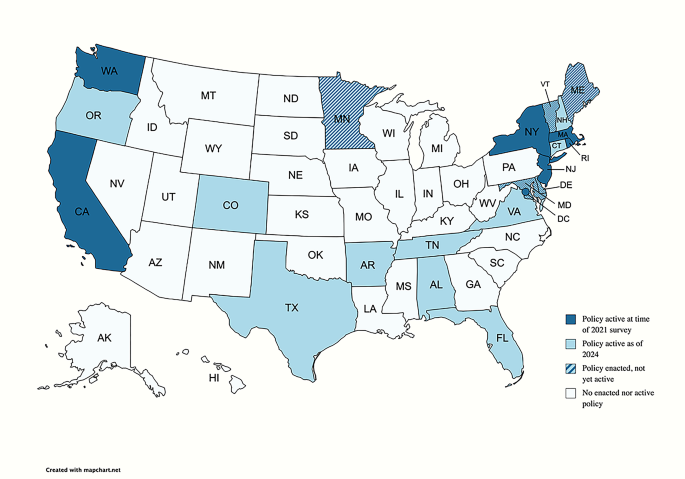
Primary exposure of interest: paid family leave policy status by US state
In this cross-sectional study, we aimed to assess the relationship of paid family leave with a spectrum of breastfeeding outcomes, including metrics of breastfeeding duration and exclusivity, at the population level. We hypothesized that residence in US states with paid family leave policies is associated with higher rates of both exclusive and any breastfeeding.
Data source
This cross-sectional, secondary dataset analysis was conducted using data from the 2021 National Immunization Survey-Child (NIS-C), which included the fifty US states and Washington, DC. The National Immunization Surveys (NIS), which includes NIS-C, are telephone surveys administered via random digit dialing to a stratified representative US sample, conducted by the CDC’s National Center for Immunization and Respiratory Disease. The NIS-C incorporates data from parent/guardian interviews and from questionnaires sent to medical providers to evaluate multiple domains of health, including immunization, breastfeeding, and usage of the Special Supplemental Nutrition Program for Women, Infants, and Children (WIC) program. The 2021 NIS-C target population included US families of children who were 19–35 months old during calendar year 2021. The survey was translated into English and Spanish, and other languages were queried using telephonic interpretation [ 20 , 21 ].
The NIS-C is a publicly available, de-identified dataset. Its use is not considered Human Subjects Research, and we did not obtain a determination of this status from the Institutional Review Board. We followed the STrengthening the Reporting of OBservational studies in Epidemiology (STROBE) guidelines for cross-sectional observational data (Additional File 1 ) [ 22 ].
Study variable terminology
When analyzing and presenting data, we used terminology as reported in the NIS-C dataset, which includes terms such as breastfeeding and mother, rather than gender-inclusive terms such as chest feeding and birthing person [ 23 , 24 ].
States with and without paid family leave policies
The locations with paid family leave policies at the time of the 2021 NIS-C included California, Massachusetts, New Jersey, New York, Rhode Island, Washington, and Washington, DC (Fig. 1 ). All other states without active paid family leave policies were grouped together, and Puerto Rico was excluded. Three locations—Washington DC, Massachusetts, and Washington—had aspects of their policies enacted in 2020, so some of the surveyed families may have given birth before full enactment. Thus, post-hoc sensitivity analyses were also conducted with these locations removed from analyses.
Primary outcome
The primary outcome was a composite variable reflecting breastmilk and infant formula feeding. To construct this variable, we accounted for three NIS-C variables that assessed if the child ever was fed breastmilk, duration of breastfeeding, and the date of first formula introduction. The finalized infant feeding primary outcome is summarized in Fig. 2 and includes four categories: (1) exclusively breastfed for the duration captured by data (without formula introduction), (2) late mixed breastfeeding (breastfed exclusively until six months, introduced formula after 6 months), and (3) early mixed breastfeeding (breastfed, introduced formula either before six months of age or at unknown time), and (4) never breastfed. “Exclusively breastfed” refers to receiving breastmilk and never infant formula as source of nutrition but may include supplementary, non-infant formula foods. Because the primary outcome centered around breastfeeding, the 141 respondents with unknown breastfeeding data were excluded from the analysis (see Additional File 2 for characteristics of excluded respondents, who could be considered as non-respondents generally due to high rates of missingness for other variables).
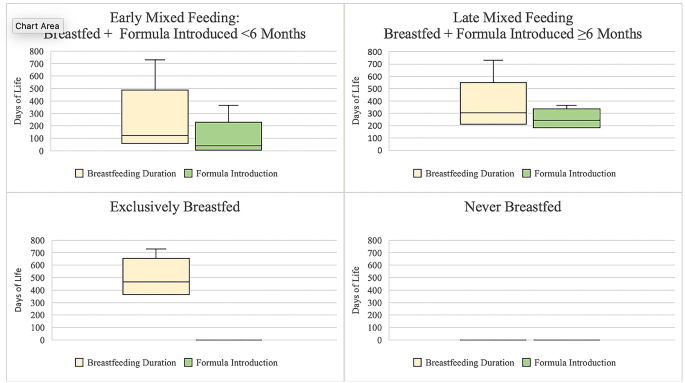
Total days of breastfeeding duration and first day of formula by primary outcome of infant feeding category. Legend: “Exclusively breastfed” refers to receiving breastmilk and never infant formula as source of nutrition but may include supplementary, non-infant formula foods. Figure includes maximum (upper whisker) but not minimum values, as some respondents who reported exclusive breastfeeding had very few days of breastfeeding reported, which we assumed to be errors in reporting. Box indicates upper and lower quartiles. Line indicates median. Adjusted n’s: Exclusively Breastfed n = 6,579.82, Late Mixed Feeding n = 5,899.27, Early Mixed Feeding n = 16,312.40, Never Breastfed n = 5,9343.9
Covariate selection
Based on prior studies of breastfeeding outcomes and available data in the NIS-C, selected covariates included: maternal age, infant age, infant sex, infant race and ethnicity (as reported by the NIS-C dataset), household size, children in the home, maternal education, marital status, language of interviews, poverty level, and WIC enrollment [ 2 ]. In order to control for policies that may affect breastfeeding outcomes at the state level, we also developed a covariate to account for workplace lactation protection policies; thirty states and the District of Columbia have such protections in place [ 25 ].
Statistical analyses
Since the data were collected using stratified random sampling, survey responses have been weighted by the weights provided by the NIS-C, to reflect strata and non-response. Simple descriptive statistics (count, percent) and Pearson χ 2 tests were used to describe and compare the social and demographic characteristics of children and mothers from states that did and did not have active paid family leave policies in 2021 (Table 1 ).
We used multivariable nominal regression to examine the extent to which the primary exposure variable of residence in states with and without paid family leave policies in 2021 was associated with the primary outcome of any infant feeding regimen that included breastfeeding, compared with never breastfeeding. In this multivariable regression, we controlled for a priori chosen covariates, all of which were retained in the adjusted model and are displayed in Tables 1 and 2 . Results are reported as adjusted estimates of prevalence of each feeding regimen (as percentages within each outcome level); differences between adjusted prevalence of breastfeeding outcomes (exclusive, late mixed, early mixed) and adjusted prevalence of never breastfeed; and unadjusted and adjusted prevalence ratios (PR, aPR) with 95% confidence intervals (CI), which were obtained postestimation via linear combinations of relevant parameters and use of marginal mean statement [ 26 ]. As noted in the description of the independent variable (states with and without family leave policies), we also conducted post-hoc sensitivity analyses without states where implementation of policies occurred during the study period. Because we were interested in the effect of paid family leave on a spectrum of breastfeeding outcomes that corresponded to independent hypotheses, we did not adjust for multiple comparisons [ 27 , 28 ].
Given the predetermined sample size by the NIS-C, our conclusions are based on the magnitude of the PR and surrounding 95% CI, rather than the p-values [ 29 , 30 ]. We further defined a meaningful magnitude of difference in the prevalence of breastfeeding at the 1% point, which reflects the change noted in the prior three years of exclusive breastfeeding in the United States, per Healthy People 2030 [ 9 ].
We completed analyses in Stata Version 15 (StataCorp College Station, Texas).
Sociodemographic characteristics by state paid family leave policy
As shown in Table 1 , of the 34,722 NIS-C unweighted survey respondents from 2021, 5,806 were from states with paid family leave policies, and they accounted for 25% of weighted survey respondents. We did not observe a meaningful difference between states with and without paid family leave policies in terms of infant sex, infant age, or household size. Differences were noted when assessing breastfeeding workplace policies, maternal age, number of children in the home, parental education, marital status, language of the interview, poverty level, and WIC enrollment (Table 1 ). Families in states with paid parental leave policies were more likely to reside in states that had workplace breastfeeding protections, report that the mother was over 29 years old, the infant was of Hispanic/Latino ethnicity, there were fewer children in the home, the mother graduated college, the mother was married, and that the income was above poverty and above $75,000. They were less likely to report being enrolled in WIC (Table 1 ).
Infant feeding patterns by state paid family leave policy
Exclusive breastfeeding was more prevalent in states with paid family leave policies than in states without such policies: 20.36% (95% CI 18.46%, 22.26%) in states with policies vs. 18.48% (95% CI 17.74%, 19.22%) in states without policies. Late mixed breastfeeding was similar in states with vs. without paid family leave: 16.78% (95% CI 14.97%, 18.60%) vs. 17.09% (95% CI 16.30%, 17.88%). Early mixed breastfeeding was more prevalent in states with vs. without paid family leave: 48.48% (95% CI 46.00%, 50.97%) vs. 46.55% (95% CI 45.47%, 47.64%). Fewer reported never breastfeeding in states with paid family leave: 14.38% (95% CI 12.52%, 16.23%) vs. 17.87% (95% CI 16.98%, 18.76%) (Fig. 3 ).
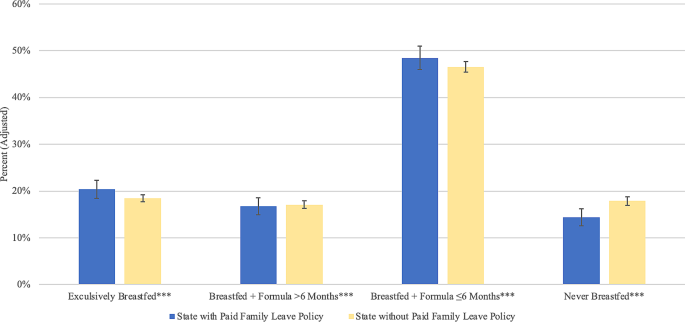
Adjusted prevalence of breastfeeding outcomes by US state paid family leave policies, National Immunization Survey-Child, 2021. Legend: Reported values are estimated prevalence of each feeding type. Error bars correspond to 95% confidence intervals
As shown in Table 2 ; Fig. 4 , compared with never breastfeeding, the adjusted prevalence of exclusive breastfeeding was higher by 5.36% (aPR = 1.41) in states with paid family leave vs. in states without paid family leave. Similarly, the adjusted prevalence of late mixed breastfeeding was higher by 3.19% (aPR = 1.25), and early mixed breastfeeding was higher by 5.42% (aPR = 1.32).
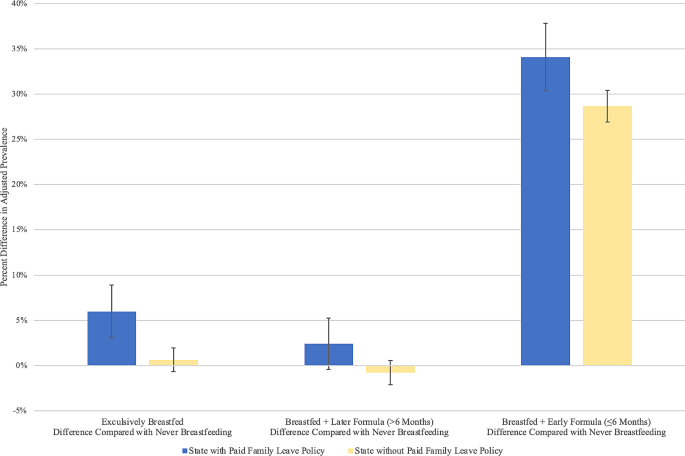
Difference in adjusted prevalence of breastfeeding outcomes and prevalence of never breastfeeding by US state paid family leave policies, National Immunization Survey-Child, 2021. Legend: Reported values are estimated differences in adjusted prevalence of each feeding type. Error bars correspond to 95% confidence intervals
A sensitivity analysis which excluded states that enacted family leave policies during the study period (Washington DC, Washington, and Massachusetts) found similar results across all feeding types (Additional File 3 ).
Covariates associated with breastfeeding
As shown in Table 2 , several covariates remained associated with breastfeeding outcomes in the adjusted model.
Workplace breastfeeding policies were positively associated with all types of breastfeeding.
Women with income below poverty had lower aPR of late mixed breastfeeding. Women who were married had greater aPR of all breastfeeding outcomes. Respondents who reported the race/ethnicity of their child as non-Hispanic/Latino Black had lower aPR of exclusively breastfeeding compared with non-Hispanic/Latino White children. Respondents who identified their children as Hispanic/Latino had higher aPR of late mixed feeding compared with non-Hispanic/Latino White children. Compared with English-speaking respondents, Spanish-speaking respondents had higher aPR of all breastfeeding types. Respondents with lower education levels had lower aPR of all breastfeeding outcomes. WIC enrollees also had lower aPR of all types of breastfeeding.
In this secondary dataset analysis using a US representative sample, we found that, after adjusting for covariates, all feeding types that incorporate breastfeeding (exclusive breastfeeding, late mixed feeding, and/or early mixed feeding) were higher in states with paid family leave compared with states without paid family leave policies. These findings offer novel insight into various feeding approaches indicative of real-world infant feeding practices among breastfeeding persons in the labor force. Even after controlling for state-level workplace breastfeeding policies, paid family leave policies are associated with exclusive breastfeeding and with a spectrum of feeding types that incorporate breastfeeding. These results demonstrate that the paid family leave policies are positively associated with breastfeeding, and thus may reflect health benefits for the parent/baby dyad that accompany any degree of breastfeeding [ 2 , 4 , 5 , 6 ].
Paid family leave policies have previously been associated with improvements in breastfeeding duration and with health and economic benefits [ 31 , 32 , 33 , 34 , 35 , 36 ]. After California was the first US state to provide eight weeks of partial paid family leave in 2004, Huang et al. utilized the CDC Infant Feeding Practices Study and found contemporaneous increases in the rates of breastfeeding in California compared with other US states, with difference-in-differences of 15.8%, 17.4%, and 18.4% in the rates of any breastfeeding at three, six, and nine months, respectively [ 37 , 38 ]. Globally, parental leave after childbirth has been associated with reduced maternal and infant morbidity and mortality [ 15 , 39 , 40 , 41 , 42 ]. In high-income countries, paid parental leave has been associated with increases in exclusive breastfeeding, downstream earning potential, workforce retention, and infant vaccination rates and with reductions in maternal medical and mental health morbidity [ 16 , 43 ]. Data suggest higher degrees of benefit with increasingly generous leave, including longer breastfeeding duration and higher maternal pay [ 44 ].
Just over half (56%) of the US workforce qualifies for federal FMLA, which is unpaid [ 45 ]. There are also limited opportunities for paid leave in the United States, which results in suboptimal breastfeeding initiation and duration [ 41 ]. Cross-sectional US studies have found that 59% of women did not receive paid leave, and, even when it was received, paid leave averaged about three weeks, with reduced salary [ 46 ]. Current FMLA policies and qualifications tend to support families who can afford unpaid time off work and have stable employment from large employers [ 18 ]. Women facing social and structural barriers to breastfeeding, such as low income, lower educational attainment, and membership in minority racial and ethnic groups, disproportionately do not benefit from federal FMLA policies. In this multivariable analysis, we found disparities in breastfeeding was associated with multiple factors that are also related to disparities in medical leave policies.
When evaluating income, we found that, in the adjusted model, women below the poverty level were less likely to exclusively breastfeed for the first six months before introducing infant formula. Families with lower incomes have previously been shown to have less paid and unpaid leave. One 2014 cross-sectional study found that only 20% of families making under $35,000 per year received paid leave, averaging 1.5 weeks in duration, compared with a respective 55% and 4.5 weeks for families making over $75,000 per year [ 46 ]. The 2018 US Department of Labor FMLA surveys demonstrated that low-wage workers making $15 per hour or less were least likely to take needed medical leave, citing the inability to afford unpaid time off from work and fear of job loss [ 45 ].
Similar to other studies, we found that marital status was positively associated with breastfeeding [ 47 ]. The US Department of Labor reports that approximately 95% of fathers with children under three years of age are working, highlighting the potential importance of parental leave for all caregivers in the workforce [ 11 ].
Our findings also reflected known racial and ethnic disparities in breastfeeding stemming from complex policies and histories related to structural and ongoing racism [ 8 , 48 , 49 ]. After adjusting for covariates, we found that, compared with respondents who identified their children as non-Hispanic White, non-Hispanic Black respondents were less likely to exclusively breastfeed. Racial and ethnic disparities extend to FMLA eligibility; studies have found that more Black and Hispanic/Latino workforce members (60.2% and 66.9%, respectively) reported being ineligible for or unable to afford unpaid leave than White workers (55.3%) [ 39 ]. Because Black women experience higher rates of pregnancy complications and preterm delivery compared to other races, current federal FMLA policies, which count time from pregnancy complications as part of leave, may further exacerbate racial inequities [ 50 , 51 , 52 ]. We also found that Hispanic/Latino respondents had higher rates of late mixed feeding but lower rates of exclusive breastfeeding compared with non-Hispanic White women. A 2021 study examining feeding goals found that despite Hispanic/Latina women having higher intentions to breastfeeding compared with non-Hispanic/Latina White women, they had lower odds of meeting their goals [ 53 ]. Inequitable access to FMLA policies may be contributing to this gap, as Hispanic/Latina women are less likely to qualify for both paid and unpaid leave, which may be related to part-time work status or working for small employers [ 39 , 54 , 55 ].
Employment and education have also previously been associated with breastfeeding outcomes and may be related to access to FMLA [ 47 ]. While NIS-C does not include employment data, in the unadjusted and adjusted analyses, we found that women with lower education levels, which are associated with employment opportunities, were less likely to breastfeed. Return to work is among the top reasons for interrupted breastfeeding [ 33 , 56 ], and women who take six months or more of leave from work have a 30% higher likelihood of any breastfeeding at six months [ 57 ].
We also found that women enrolled in WIC were less likely to report breastfeeding across all adjusted and unadjusted analyses. For breastfeeding individuals, WIC distributes breast pumps, offers nutritional support, and supports breastfeeding peer counselor programs [ 58 ]. WIC also subsidizes formula purchases, which can result in sales benefits for formula manufactures [ 59 ]. Multi-level strategies have been found to enhance breastfeeding for WIC participants, including supporting early WIC enrollment, assessing breastfeeding intentions, and funding peer counseling [ 60 ]. However, formula provision may be an incentive for WIC enrollment for some income-eligible individuals, and prior studies have found that some enrollees perceive WIC as a formula provider and appreciate the financial support for formula supplementation [ 61 ]. These findings underscore the need to further enrich the lactation-supporting capacity of WIC while considering financial implications and regulations for formula provision.
Limitations of this cross-sectional, secondary dataset analysis included baseline differences between the states with and without paid family leave policies. Respondents in states with paid family leave policies were more likely to report older age, Hispanic/Latina ethnicity, smaller household size, college degree, married status, higher income levels, and lower WIC enrollment. While we adjusted for these characteristics and for workplace breastfeeding policies, there were potentially other unmeasured confounding factors that may have differed between states with and without paid family leave policies, including maternal employment status. Although more generous leave has been found to be associated with greater benefits for breastfeeding-related outcomes, this study did not account for state-by-state variation in leave policies [ 44 ]. Several states had policies that went into effect during the survey lookback period, but sensitivity analyses showed similar outcomes regardless of inclusion or exclusion of these states in analyses. Additionally, there were limited data for families who prefer languages other than English or Spanish, and birthing people with varying gender identities may have been excluded.
Despite the limitations of the cross-sectional analysis, it is important to assess differences in breastfeeding outcomes, including mixed breast and formula feeding, as more states enact paid family leave policies. Future prospective studies can evaluate changes in breastfeeding after policy enactment and can assess breastfeeding prevalence in the workforce.
Conclusions
In the United States, all feeding types that incorporate breastfeeding were higher in states with paid family leave compared with states without paid family leave policies. Although multilevel interventions are needed to support breastfeeding, expansion of policies that grant working families and caregivers paid time to raise children can positively affect breastfeeding, which in turn could improve preventative health and economic benefits for individuals and society.
Data availability
The datasets analyzed during the current study are available in the repository which is available from the Centers for Disease Control and Prevention at: https://www.cdc.gov/vaccines/imz-managers/nis/datasets.html.
Abbreviations
Adjusted prevalence ratio
Centers for Disease Control and Prevention
Confidence Interval
- Family Medical Leave Act
National Immunization Surveys
National Immunization Survey-Child
Organization for Economic Cooperation and Development
Prevalence Ratio
Providing Urgent Maternal Protections for Nursing Mothers Act
STrengthening the Reporting of OBservational studies in Epidemiology
United States
Special Supplemental Nutrition Program for Women, Infants, and Children
Practice advisory to update the duration of breastfeeding. https://www.acog.org/en/clinical/clinical-guidance/practice-advisory/articles/2023/02/duration-of-breastfeeding-update . Accessed 18 March 2024.
Meek JY, Noble L. Technical report: breastfeeding and the use of human milk. Pediatrics. 2022;150:e2022057989. https://doi.org/10.1542/peds.2022-057988 .
Article PubMed Google Scholar
World Health Organization. Breastfeeding. https://www.who.int/westernpacific/health-topics/breastfeeding . Accessed 18 March 2024.
Frank NM, Lynch KF, Uusitalo U, Yang J, Lönnrot M, Virtanen SM, et al. The relationship between breastfeeding and reported respiratory and gastrointestinal infection rates in young children. BMC Pediatr. 2019;19:339. https://doi.org/10.1186/s12887-019-1693-2 .
Article CAS PubMed PubMed Central Google Scholar
Güngör D, Nadaud P, Dreibelbis C, LaPergola C, Terry N, Wong YP et al. Shorter versus longer durations of exclusive human milk feeding prior to the introduction of infant formula and food allergies, allergic rhinitis, atopic dermatitis, and asthma: a systematic review. Alexandria (VA): USDA Nutrition Evidence Systematic Review; 2019. http://www.ncbi.nlm.nih.gov/books/NBK580356/ . Accessed 10 April 2023.
Dewey K, Bazzano L, Davis T, Donovan S, Taveras E, Kleinman R et al. The duration, frequency, and volume of exclusive human milk and/or infant formula consumption and overweight and obesity: a systematic review. Alexandria (VA): USDA Nutrition Evidence Systematic Review; 2020. http://www.ncbi.nlm.nih.gov/books/NBK578873/ . Accessed 10 April 2023.
Glazer KB, Zeitlin J, Howell EA. Intertwined disparities: applying the maternal-infant dyad lens to advance perinatal health equity. Semin Perinatol. 2021;45(4):151410. https://doi.org/10.1016/j.semperi.2021.151410 .
Article PubMed PubMed Central Google Scholar
CDC. 2022 Breastfeeding report card. Center for Disease Control and Prevention. 2022. https://www.cdc.gov/breastfeeding/data/reportcard.htm . Accessed 23 Feb 2023.
Increase the proportion of infants who. are breastfed exclusively through age 6 months — MICH–15 - Healthy People 2030 | health.gov. https://health.gov/healthypeople/objectives-and-data/browse-objectives/infants/increase-proportion-infants-who-are-breastfed-exclusively-through-age-6-months-mich-15 . Accessed 23 Feb 2023.
Steurer LM. Maternity leave length and workplace policies’ impact on the sustainment of breastfeeding: global perspectives. Public Health Nurs. 2017;34:286–94. https://doi.org/10.1111/phn.12321 .
Labor force participation rates | U.S. Department of Labor. https://www.dol.gov/agencies/wb/data/latest-annual-data/labor-force-participation-rates#Labor-Force-Participation-Rate-of-Mothers-and-Fathers-by-Age-of-Youngest-Child . Accessed 1 May 2023.
CDC. The Surgeon General’s call to action to support breastfeeding. Centers for Disease Control and Prevention. 2021. https://www.cdc.gov/breastfeeding/resources/calltoaction.htm . Accessed 30 March 2023.
The Surgeon General’. s call to action to improve maternal health - Healthy People 2030 | health.gov. https://health.gov/healthypeople/tools-action/browse-evidence-based-resources/surgeon-generals-call-action-improve-maternal-health . Accessed 10 April 2023.
The White House. Biden-Harris administration national strategy on hunger, nutrition, and health. 2022. https://www.whitehouse.gov/briefing-room/statements-releases/2022/09/27/executive-summary-biden-harris-administration-national-strategy-on-hunger-nutrition-and-health/ . Accessed 10 April 2023.
Nandi A, Jahagirdar D, Dimitris MC, Labrecque JA, Strumpf EC, Kaufman JS, et al. The impact of parental and medical leave policies on socioeconomic and health outcomes in OECD countries: a systematic review of the empirical literature. Milbank Q. 2018;96:434–71.
Heymann J, Sprague AR, Nandi A, Earle A, Batra P, Schickedanz A, et al. Paid parental leave and family wellbeing in the sustainable development era. Public Health Rev. 2017;38:21. https://doi.org/10.1111/1468-0009.12340 .
Rep, Maloney. CB [D-N-12. H.R.3110–117th Congress (2021–2022): PUMP for Nursing Mothers Act. 2021. http://www.congress.gov/ . Accessed 10 April 2023.
Department of Labor. Family and Medical Leave (FMLA). http://www.dol.gov/general/topic/benefits-leave/fmla . Accessed 1 May 2023.
Bipartisan Policy Center. State paid family leave laws across the U.S https://bipartisanpolicy.org/explainer/state-paid-family-leave-laws-across-the-u-s/ . Accessed 10 December 2023.
U.S. Department of Health and Human Services (DHHS) National Center for Immunization and Respiratory Diseases. The 2021 National Immunization Survey - Child. Atlanta, GA: Centers for Disease Control and Prevention. 2022. https://www.cdc.gov/vaccines/imz-managers/nis/downloads/NIS-PUF21-DUG.pdf . Accessed 18 March 2024.
Centers for Disease Control and Prevention. NIS-Child data tables for 2015 to present. 2023. https://www.cdc.gov/vaccines/imz-managers/nis/datasets.html . Accessed 23 February 2023.
von Elm E, Altman DG, Egger M, Pocock SJ, Gøtzsche PC, Vandenbroucke JP, et al. The strengthening the reporting of Observational studies in Epidemiology (STROBE) statement: guidelines for reporting observational studies. J Clin Epidemiol. 2008;61:344–9. https://doi.org/10.1016/j.jclinepi.2007.11.008 .
Article Google Scholar
Dinour LM. Speaking out on breastfeeding terminology: recommendations for gender-inclusive language in research and reporting. Breastfeed Med. 2019;14:523–32. https://doi.org/10.1089/bfm.2019.0110 .
National Institutes of Health (NIH). Inclusive and gender-neutral language. https://www.nih.gov/nih-style-guide/inclusive-gender-neutral-language . Accessed 1 May 2023.
National Conference of State Legislatures. Breastfeeding state laws. 2021. https://www.ncsl.org/health/breastfeeding-state-laws . Accessed 6 December 2023.
Stata. mlogit — multinomial (polytomous) logistic regression. https://www.stata.com/manuals/rmlogit.pdf . Accessed 27 May 2023.
Rubin M. When to adjust alpha during multiple testing: a consideration of disjunction, conjunction, and individual testing. Synthese. 2021;199:10969–1000. https://doi.org/10.1007/s11229-021-03276-4 .
Rubin M. There’s no need to lower the significance threshold when conducting single tests of multiple individual hypotheses. Acadademia Lett. 2021. https://doi.org/10.20935/AL610 .
Poole C. Low p-values or narrow confidence intervals: which are more durable? Epidemiology. 2001;12:291–4. https://doi.org/10.1097/00001648-200105000-00005 .
Article CAS PubMed Google Scholar
Sullivan GM, Feinn R. Using effect size—or why the p value is not enough. J Grad Med Educ. 2012;4:279–82. https://doi.org/10.4300/JGME-D-12-00156.1 .
Navarro-Rosenblatt D, Garmendia M-L. Maternity leave and its impact on breastfeeding: a review of the literature. Breastfeed Med. 2018;13:589–97. https://doi.org/10.1089/bfm.2018.0132 .
Rollins NC, Bhandari N, Hajeebhoy N, Horton S, Lutter CK, Martines JC, et al. Why invest, and what it will take to improve breastfeeding practices? Lancet. 2016;387:491–504. https://doi.org/10.1016/S0140-6736(15)01044-2 .
Baker M, Milligan K. Maternal employment, breastfeeding, and health: evidence from maternity leave mandates. J Health Econ. 2008;27:871–87. https://doi.org/10.1016/j.jhealeco.2008.02.006 .
Andres E, Baird S, Bingenheimer JB, Markus AR. Maternity leave access and health: a systematic narrative review and conceptual framework development. Matern Child Health J. 2016;20:1178–92. https://doi.org/10.1007/s10995-015-1905-9 .
Hamad R, Modrek S, White JS. Paid family leave effects on breastfeeding: a quasi-experimental study of US policies. Am J Public Health. 2019;109:164–6. https://doi.org/10.2105/AJPH.2018.304693 .
Kortsmit K, Li R, Cox S, Shapiro-Mendoza CK, Perrine CG, D’Angelo DV, et al. Workplace leave and breastfeeding duration among postpartum women, 2016–2018. Am J Public Health. 2021;111:2036–45. https://doi.org/10.2105/AJPH.2021.306484 .
Huang R, Yang M. Paid maternity leave and breastfeeding practice before and after California’s implementation of the nation’s first paid family leave program. Econ Hum Biol. 2015;16:45–59. https://doi.org/10.1016/j.ehb.2013.12.009 .
Centers for Disease Control and Prevention. Why it matters. 2023. https://www.cdc.gov/breastfeeding/about-breastfeeding/why-it-matters.html . Accessed 10 April 2023.
Sprague A, Earle A, Moreno G, Raub A, Waisath W, Heymann J. National policies on parental leave and breastfeeding breaks: racial, ethnic, gender, and age disparities in access and implications for infant and child health. Public Health Rep. 2023;333549231151661. https://doi.org/10.1177/00333549231151661 .
Webster JL, Paul D, Purtle J, Locke R, Goldstein ND. State-level social and economic policies and their association with perinatal and infant outcomes. Milbank Q. 2022;100:218–60. https://doi.org/10.1111/1468-0009.12571 .
Ruhm CJ. Parental leave and child health. J Health Econ. 2000;19:931–60. https://doi.org/10.1016/s0167-6296(00)00047-3 .
Burtle A, Bezruchka S. Population health and paid parental leave: what the United States can learn from two decades of research. Healthcare. 2016;4:30. https://doi.org/10.3390/healthcare4020030 .
Raub A, Nandi A, Earle A, de Guzman Chorny N, Wong E, Chung P et al. Paid parental leave: a detailed look at approaches across OECD countries. UCLA WORLD Policy Analysis Center; 2018. https://www.worldpolicycenter.org/sites/default/files/WORLD%20Report%20-%20Parental%20Leave%20OECD%20Country%20Approaches_0.pdf . Accessed 18 March 2024.
Heshmati A, Honkaniemi H, Juárez SP. The effect of parental leave on parents’ mental health: a systematic review. Lancet Public Health. 2023;8:e57–75. https://doi.org/10.1016/S2468-2667(22)00311-5 .
Abt Associates. Assessing FMLA: results from 2018 surveys. https://www.abtassociates.com/insights/publications/report/assessing-fmla-results-from-2018-surveys . Accessed 11 May 2023.
Shepherd-Banigan M, Bell JF. Paid leave benefits among a national sample of working mothers with infants in the United States. Matern Child Health J. 2014;18:286–95. https://doi.org/10.1007/s10995-013-1264-3 .
Mandal B, Roe BE, Fein SB. The differential effects of full-time and part-time work status on breastfeeding. Health Policy. 2010;97:79–86. https://doi.org/10.1016/j.healthpol.2010.03.006 .
Griswold MK, Crawford SL, Perry DJ, Person SD, Rosenberg L, Cozier YC, et al. Experiences of racism and breastfeeding initiation and duration among first-time mothers of the black women’s health study. J Racial Ethn Health Disparities. 2018;5:1180–91. https://doi.org/10.1007/s40615-018-0465-2 .
Manuck TA. Racial and ethnic differences in preterm birth: a complex, multifactorial problem. Semin Perinatol. 2017;41:511–8. https://doi.org/10.1053/j.semperi.2017.08.010 .
Bornstein E, Eliner Y, Chervenak FA, Grünebaum A. Racial disparity in pregnancy risks and complications in the US: temporal changes during 2007–2018. J Clin Med. 2020;9:1414. https://doi.org/10.3390/jcm9051414 .
Martin JA, Hamilton BE, Osterman MJK. Births in the United States, 2019. NCHS Data Brief. 2020;1–8.
KFF. Preterm Births as a Percent of All Births by Race/Ethnicity. 2023. https://www.kff.org/other/state-indicator/preterm-births-by-raceethnicity/ . Accessed 11 May 2023.
Hamner HC, Beauregard JL, Li R, Nelson JM, Perrine CG. Meeting breastfeeding intentions differ by race/ethnicity, infant and toddler feeding practices Study-2. Matern Child Nutr. 2020;17:e13093. https://doi.org/10.1111/mcn.13093 .
Ann Bartell, Soohyun K, Nam J, Rossin-Slater M, Ruhm C, Waldfogel J. June. Racial and ethnic disparities in access to and use of paid family and medical leave: evidence from four nationally representative datasets: monthly labor review: U.S. Bureau of Labor Statistics. https://www.bls.gov/opub/mlr/2019/article/racial-and-ethnic-disparities-in-access-to-and-use-of-paid-family-and-medical-leave.htm . Accessed 2 2023.
Goodman JM, Richardson DM, Dow WH. Racial and ethnic inequities in paid family and medical leave: United States, 2011 and 2017–2018. Am J Public Health. 2022;112:1050–8. https://doi.org/10.2105/AJPH.2022.306825 .
Schwartz K, D’Arcy HJS, Gillespie B, Bobo J, Longeway M, Foxman B. Factors associated with weaning in the first 3 months postpartum. J Fam Pract. 2002;51:439–44.
PubMed Google Scholar
UNICEF USA. The ost of not breastfeeding. https://www.unicefusa.org/stories/cost-not-breastfeeding . Accessed 11 May 2023.
Food and Nutrition Service. Breastfeeding promotion in WIC: current federal requirements https://www.fns.usda.gov/wic/breastfeeding-promotion-wic-current-federal-requirements . Accessed 12 May 2023.
Choi YY, Ludwig A, Andreyeva T, Harris JL. Effects of United States WIC infant formula contracts on brand sales of infant formula and toddler milks. J Public Health Policy. 2020;41:303–20. https://doi.org/10.1057/s41271-020-00228-z .
Houghtaling B, Shanks CB, Jenkins M. Likelihood of breastfeeding within the USDA’s Food and Nutrition Service Special Supplemental Nutrition Program for women, infants, and children population: a systematic review of the literature. J Hum Lact off J Int Lact Consult Assoc. 2017;33:83–97. https://doi.org/10.1177/0890334416679619 .
Almeida R, Alvarez Gutierrez S, Whaley SE, Ventura AK. A qualitative study of breastfeeding and formula-feeding mothers’ perceptions of and experiences in WIC. J Nutr Educ Behav. 2020;52:615–25. https://doi.org/10.1016/j.jneb.2019.12.006 .
Download references
Acknowledgements
Not applicable.
Support for Dr. Rosenberg was made possible by CTSA Grant Number KL2 TR001862 from the National Center for Advancing Translational Science (NCATS), components of the National Institutes of Health (NIH), and NIH roadmap for Medical Research. Its contents are solely the responsibility of the authors and do not necessarily represent the official view of NIH.
Support for Dr. Nardella was made possible by the Yale National Clinician Scholars Program and by CTSA Grant Number TL1 TR001864 from the National Center for Advancing Translational Science (NCATS), a component of the National Institutes of Health (NIH). Its contents are solely the responsibility of the authors and do not necessarily represent the official view of NIH.
Author information
Authors and affiliations.
Department of Pediatrics, Yale School of Medicine, 333 Cedar St, New Haven, CT, USA
Julia Rosenberg, Deanna Nardella & Veronika Shabanova
National Clinician Scholars Program, Yale University, 333 Cedar St, New Haven, CT, USA
Deanna Nardella
Department of Biostatistics, Yale School of Public Health, 333 Cedar St, New Haven, CT, USA
Veronika Shabanova
You can also search for this author in PubMed Google Scholar
Contributions
JR: conceptualization, methodology, validation, formal analysis, investigation, resources, data curation, writing – original draft, review, editing, visualization, project administration, funding acquisition. DN: validation, investigation, resources, writing – original draft, review, and editing. VS: conceptualization, methodology, validation, formal analysis, writing – review and editing, supervision. All authors read and approved the final manuscript.
Corresponding author
Correspondence to Julia Rosenberg .
Ethics declarations
Ethics approval and consent to participate.
Not applicable. The National Immunization Survey is a publicly available, de-identified dataset. Its use is not considered Human Subjects Research, and we did not obtain a determination of this status from the Institutional Review Board.
Consent for publication
Competing interests.
The authors declare no competing interests.
Additional information
Publisher’s note.
Springer Nature remains neutral with regard to jurisdictional claims in published maps and institutional affiliations.
Electronic supplementary material
Below is the link to the electronic supplementary material.
Supplementary Material 1
Supplementary material 2, supplementary material 3, rights and permissions.
Open Access This article is licensed under a Creative Commons Attribution 4.0 International License, which permits use, sharing, adaptation, distribution and reproduction in any medium or format, as long as you give appropriate credit to the original author(s) and the source, provide a link to the Creative Commons licence, and indicate if changes were made. The images or other third party material in this article are included in the article’s Creative Commons licence, unless indicated otherwise in a credit line to the material. If material is not included in the article’s Creative Commons licence and your intended use is not permitted by statutory regulation or exceeds the permitted use, you will need to obtain permission directly from the copyright holder. To view a copy of this licence, visit http://creativecommons.org/licenses/by/4.0/ . The Creative Commons Public Domain Dedication waiver ( http://creativecommons.org/publicdomain/zero/1.0/ ) applies to the data made available in this article, unless otherwise stated in a credit line to the data.
Reprints and permissions
About this article
Cite this article.
Rosenberg, J., Nardella, D. & Shabanova, V. State paid family leave policies and breastfeeding duration: cross-sectional analysis of 2021 national immunization survey-child. Int Breastfeed J 19 , 37 (2024). https://doi.org/10.1186/s13006-024-00646-9
Download citation
Received : 16 December 2023
Accepted : 18 May 2024
Published : 26 May 2024
DOI : https://doi.org/10.1186/s13006-024-00646-9
Share this article
Anyone you share the following link with will be able to read this content:
Sorry, a shareable link is not currently available for this article.
Provided by the Springer Nature SharedIt content-sharing initiative
- Breastfeeding
- National Immunization Survey
International Breastfeeding Journal
ISSN: 1746-4358
- General enquiries: [email protected]

COMMENTS
3. Stop for feeding breaks. 4. Try to maintain your routine. 5. Pack cleaning supplies. 6. Once you arrive, set up a cleaning station. You can bring as much formula as you need on the plane, but it does take some planning to pack water, bottles, cleaning supplies, and more.
Formula, breast milk, toddler drinks, and baby/toddler food (to include puree pouches) in quantities greater than 3.4 ounces or 100 milliliters are allowed in carry-on baggage and do not need to fit within a quart-sized bag. Formula, breast milk, toddler drinks, and baby/toddler food (to include puree pouches) are considered medically necessary liquids.
The first important thing to know about traveling with baby formula is that you are exempt from the normal hand baggage liquid rules which limit liquids at 100ml. Sometimes this is known as the 3-1-1 rule. This is only valid IF you are flying with an infant. You can also take formula in your hold luggage.
When preparing for international travel, it's equally important to be aware of regulations and cultural considerations at your destination: 1. International Regulations: Different countries may have varying regulations concerning baby formula and other baby-related items. Some places may require special documentation for formula or breast milk.
The travel formula containers make life very easy in terms of portioning and mixing while en route. Although having the can handy for identification makes life easier while going through security. Mixing Formula. Probably my biggest and best tip for travel with baby formula is to get baby accustomed to drinking room temperature bottles.
Flying with baby formula isn't that complicated. My babies were formula fed and I traveled with them every other week. I often flew alone and took numerous international flights between 8-16 hours long when both infants were formula fed. If you prepare and know the rules, it's pretty easy to travel with baby formula.
Water: Bring clean water for mixing formula, or plan to buy bottled water after passing through security. Bottle brush: Pack a bottle brush for cleaning bottles on the go. Burp cloths: Bring a few burp cloths to clean up after feeding. Insulated bag: Use an insulated bag to keep formula and bottles cool.
Formula-feeding while road tripping gets easier the more times you do it, especially when you have the right strategies in place to keep your baby happy with a full tummy. Prepare Bottles Ahead - This tip we recommended for plane travel works great for car travel as well. Because it's so important to have clean hands to prepare bottles, it ...
Liquid amounts. For baby food including breast milk, water for formula, liquid formula, juice, and other forms of milk, you're allowed to bring "a reasonable amount" of each above the 100ml/container limit. The amount that is reasonable to take through security is left up to the TSA officer. I have actually run into issues with this when ...
A baby bottle warmer is essential when traveling by plane or car. It is the only way you can warm the milk well in advance. This way, you won't have to rush and start warming the milk when your baby gets angry. You don't also don't want to bother passengers with a crying baby, so it's good to put the formula in the warmer in advance.
Put some freshly boiled, slightly cooled water in a good-quality vacuum flask, which will keep it warm for about four hours. Pre-measure the correct amount of formula powder for each feed. You can buy formula containers for storing the pre-measured formula powder, or you can use clean, lidded containers. You can then easily make a feed by ...
Gather the paperwork. Fill out Form DS-11 and take your baby's birth certificate plus photocopies of each document. Bring a couple of photos, a valid ID for each parent, a photocopy of parental IDs and the fee (you can pay by check). Fees are currently $100 for the passport and $35 for processing.
Flying With Powered Baby Formula. You can bring powered baby formula on a plane in your carry-on bag or checked bags. But when packing powdered formula in hand luggage the powders rule applies. There is no limit to the amount of powdered baby formula you can pack in your carry-on luggage. But if your powdered can is over 12 oz then remove it ...
The TSA classifies baby formula as medically necessary, so you can pack as much baby formula as you need for the trip without being limited to the 3.4-ounce rule that applies to other liquids. When you go through security screening, inform airport security of the amount of baby formula you're carrying. Remove the formula from your carry-on so ...
TSA regulations make generous allowances for milk and formula: Formula, breast milk, toddler drinks, and baby/toddler food (to include puree pouches) in quantities greater than 3.4 ounces or 100 ...
3. Pack Dish Soap. The most difficult part about traveling with bottles and formula is the washing. Be sure to pack a small bottle of dish soap so you are ready to wash the bottles. Any sink will work, but you want a good dish soap to really get the bottles clean.
Here are five tips: 1. Think about when your baby normally eats. You can often buy yourself a couple of hours to run errands if you plan your day around your baby's usual feeding schedule. Try to schedule tasks for just after you've fed your little one. That way, you can enjoy some time before they're hungry again. 2.
It's vital to use the right water, with common choices being distilled water for babies or purified water for babies. Powder Formula Dispensers: Handy tools for pre-measuring formula for travel. Travel Tips: Using bottled water or a formula dispenser can make the process seamless when traveling with baby formula. 2.
Considering International Travel with an Infant? Here are tips + tricks from traveling with an infant (10 countries, 15 flights & 20 hotels)! ... Whether it's Tylenol or something your baby needs more critically, obviously be sure to pack meds for baby in the carry-on. Formula Packing and Options Kaia in Dubai at 3 months old (April 2023)
3 / 8. "Invest in a backpack with a number of dividers," says Christian. "This is the best way to keep your hands free to cuddle your baby until you are seated on board.". Babies come with a lot of baggage so it's important to check what you can and can't take on the plane. You can bring: a reasonable amount of baby milk - breast ...
Your child or infant does not need to be present or traveling with you to bring breast milk, formula and/or related supplies. Inform the TSA officer at the beginning of the screening process that you are carrying formula, breast milk, toddler drinks and baby/toddler food (to include puree pouches) in excess of 3.4 ounces.
Pack a travel sized formula container and ask the airline for hot water. Pro Tips: TSA allows you to bring a reasonable amount of breast milk, formula, and baby food for your infant. It's exempt from the 3-1-1 liquids rule, but you do need to declare it at security. Pack a few extra bottles, a bottle warmer and portable bottle cleaner and soap.
2. Consult your pediatrician before planning a big trip with your baby. Your doctor can advise you if your baby's old enough and well enough to travel, and if any extra vaccinations are suggested. Your doctor can also offer suggestions for keeping your baby healthy on the trip, including medications to pack. Don't listen to well-meaning ...
The implicated Crecelac formula, imported and distributed by Dairy Manufacturers Inc., located in Prosper, Texas, has led to concerns due to its potential distribution breadth across the US.
Both women's experiences violate TSA guidelines: formula, breast milk, toddler drinks and baby food are allowed on planes and carry-ons in quantities greater than 3.4 ounces. Breast milk, formula and ice packs — along with other cooling accessories — are considered medically necessary.
WASHINGTON (AP) — U.S. health officials warned parents to avoid powdered infant formula sold by a Texas dairy producer, because a dangerous bacteria was found in one of the company's products.
Paid parental leave policies may promote breastfeeding, which can have short- and long-term health benefits for both members of the birthing person-infant dyad. In the United States, where 56% of the workforce qualifies for unpaid federal medical leave, certain states have recently enacted paid parental and family leave policies. We aimed to assess the extent to which living in states with ...